Archaeopterygidae
Archaeopteryx albersdoerferi Kundrat et. al.
Archaeopteryx lithographica Meyer
Archaeopteryx siemensii Dames
*********************
edited: 20.12.2019

Archaeopterygidae
Archaeopteryx albersdoerferi Kundrat et. al.
Archaeopteryx lithographica Meyer
Archaeopteryx siemensii Dames
*********************
edited: 20.12.2019
Opisthocomidae
Hoazinavis lacustris Mayr et al.
Hoazinoides magdalenae Miller
Namibiavis senutae Mourer-Chauviré
Protoazin parisiensis Mayr & De Pietri
*********************
edited: 09.12.2019
This is a small bird from the Eocene of Wyoming, USA, it was only about 10 cm long and is so far known from a complete skeleton with most of the feathers preserved as well.
The bird is not yet described but is apparently currently under study, it may turn out to be related to Morsoravis sedilis Bertelli, Lindow, Dyke & Chiappe, and to belong into a new family, probably named the Morsorornithidae or alike, which then again are perhaps somehow related to the mousebird/parrot/songbird ‘orbit’.
The reconstruction shows it while somewhat stretching its left wing, it was ‘fun’ to draw all this wing feathers, and I probably will do that NEVER EVER AGAIN!!! 😉
*********************

*********************
A little update here:
This bird is now apparently included into the genus Morsoravis. [2]
*********************
References:
[1] Lance Grande: The Lost World of Fossil Lake: Snapshots from Deep Time. University of Chicago Press 2013
[2] Daniel T. Ksepka; Lance Grande; Gerald Mayr: Oldest finch-beaked birds reveal parallel ecological radiations in the earliest evolution of passerines. Current Evolution 29(4): 657-663. 2019
*********************
edited: 07.12.2019
Protopterygidae
Protopteryx fengningensis Zhang & Zhou
*********************
edited: 07.12.2019
Family incertae sedis
Horezmavis eocretacea Nesov (?)
Gobipterygidae
Gobipteryx minuta Elzanowski
*********************
edited: 07.12.2019
This new bird has recently been reported from Argentinia, and its name apparently is taken from the Aonikenk language, which is or was spoken by the Mapuche of southern Argentinia and its translation is given in the title.
***
The new genus and species is known so far from a single bone, an incomplete right coracoid, whose „combination of characters strongly suggests anseriform affinities“. [1]
That means that this species obvioulsy was an anseriform, some duck- or goose-like bird, more or less similar to other Late Cretaceous or Early Paleocene species.
Let’s see if there will be more remains to be discovered in the future.
*********************
References:
[1] Fernando. E. Novas; Federico. L. Agnolin; Sebastián Rozadilla; Alexis M. Aranciaga-Rolando; Federico Brisson-Egli; Matias J. Motta; Mauricio Cerroni; Martín D. Ezcurra; Agustín G. Martinelli; Julia S. d ́Angelo; Gerardo Alvarez-Herrera; Adriel R. Gentil; Sergio Bogan; Nicolás R. Chimento; Jordi A. García-Marasà; Gastón Lo Coco; Sergio E. Miquel; Fátima F. Brito; Ezequiel I. Vera; Valeria S. Perez Loinaze; Mariela S. Fernández & Leonardo Salgado: Paleontological discoveries in the Chorrillo Formation (upper Campanian-lower Maastrichtian, Upper Cretaceous), Santa Cruz Province, Patagonia, Argentina. Revista del Museo Argentino de Ciencias Naturales, n. s. 21(2): 217-293. 2019
*********************
edited: 07.12.2019
Avisauridae
Avisaurus archibaldi Brett-Surman & Paul
Bauxitornis mindszentyae Dyke & Ősi
Concornis lacustris Sanz & Buscalioni
Enantiophoenix electrophyla Cau & Arduini
Gettya gloriae (Varrichio and Chiappe)
Halimornis thompsoni Chiappe, Lamb & Ericson
Intiornis inexpectatus Novas et al.
Mirarce eatoni Atterholt et al.
Neuquenornis volans Chiappe & Calvo
Soroavisaurus australis Chiappe
*********************
edited: 06.12.2019
***
Note that this order may not be valid.
This tiny thing could be called the „Cretaceous Nicobar Pigeon“, it had somewhat elongated neck feathers, the typical short tail, or rather a not-a-tail-at-all tail so typical for many of those strange Cretaceous enantiornithine birds that we now already know.
The strange-feathered creature comes from China, where it lived some 130 Million years ago in the late Early Cretaceous.
The genus name refers to its crural feathers (bird trousers) which are actually found in many birds, but here they are shaped like nothing ever seen before, maybe like a thin sheet of ceratin with a chewed end, or brush-like end, not at all like a feather. The species name again refers to its multi-toothed beak.
*********************
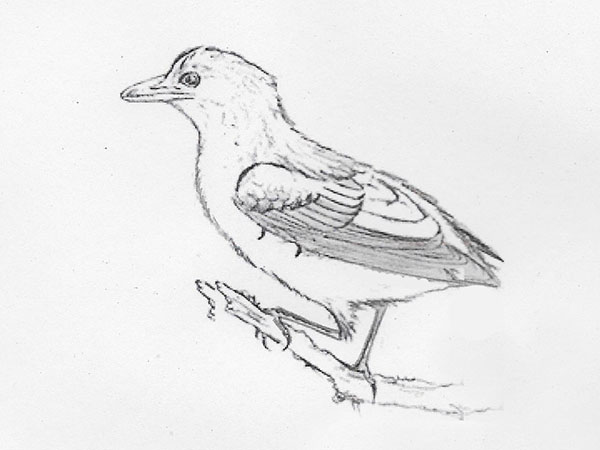
The bird reached a size of about 10 to maybe 11 or 12 cm when fully grown. The body feathers appear to have been more hair- than feather-like, and they may have been dark, while those on its neck were somewhat elongated and apparently were even glossy [1] … why not.
***
Unfortunatly I could not find any plant species from the same place and time.
*********************
References:
[1] Min Wang; Jingmai K. O’Connor; Yanhong Pan; Zhonghe Zhou: A bizarre Early Cretaceous enantiornithine bird with unique crural feathers and an ornithuromorph plough-shaped pygostyle. Nature Communications 8: 1-12. 2017
*********************
edited: 19.11.2019
This tiny bird is thought to be the ancestor of the kingfishers or of the todies, or of both.
Quasisyndactylus longibrachis was very small, only about 10 cm long, its legs were quite long, very much like in today’s todies (Todidae) and its feet were syndactyl (that means two of the toes, toes 3 and 4, are fused together), like those of all known Coraciiformes showing that it was a member of that order.
The species is known from several specimens, some of which also still harbor their feathering, showing that this species had rather roundish wings and a rather long tail.
*********************
References:
[1] G. Mayr: „Coraciiforme“ und „piciforme“ Kleinvögel aus dem Mittel-Eozän der Grube Messel (Hessen, Deutschland). Courier Forschungsinstitut Senckenberg, Band 205. 1998
*********************
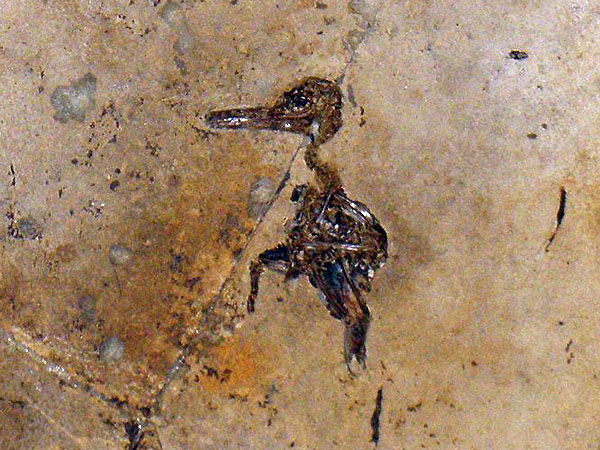
*********************

*********************
edited: 05.11.2019; 06.11.2019
Here I want to write a bit about two enigmatic birds that allegedly both were collected in Africa at the beginning of the 19th century; these are Adanson’s Bee-eater and Latreille’s Bee-eater.
*********************

Adanson’s Bee-eater is an enigmatic bird known only from a single specimen which is commonly thought to have been an artificially specimen, assembled from several bird parts, a practice that was rather common in these olden days when collectors were keen to have in their collections the most rare exhibition pieces.
The following French texts are all from François Le Vaillant, they describe this ’species‘ and give us some additional information about its wehereabouts. [1]
„Ce guêpier à queue en flèche ayant été méconnu par Buffon qui l’a, donné comme une simple variété de climat de son guêpier marron et bleu, ou de l’Isle-de-France, espèce que nous avons décrite dans notre précédent n°, sous la dénomination de guêpier Latreille, nous avons dû encore lui donner un nom distinctif, et nous ne pouvions à cet égard mieux faire, je pense, que de choisir celui du célebre voyageur qui l’ayant rapporté du Sénégal, l’a le premier fait connoître en Europe. Il suffira, je pense, de comparer les figures exactes que nous avons publiées de ces deux oiseaux, pour être d’abord et du premier coup-d’œil convaincu de la méprise de Buffon à leur égard, et être persuadé enfin qu’ils forment deux espèces très distinctes, bien loin de n’être l’un qu’une variété de l’autre; on ne conçoit même pas, en voyant les figures qui représentent dans les planches enluminées de Buffon ces deux oiseaux, l’un sous le nom de guêpier de l’Isle-de-France, n° 252, et l’autre, n° 314, sous celui de guêpier à longue queue du Sénégal, comment il a été possible de commettre cette erreur, et encore moins qu’elle ait été perpétuée par tous les ornithologistes qui ont écrit sur les oiseaux depuis Buffon. On conçoit en effet d’autant moins cette méprise, que ces deux figures, d’ailleurs très mauvaises , different bien plus l’une de l’autre encore, que ne différent réellement ces deux oiseaux eux-mêmes entre eux, mais assez cependant pour être bien sûr qu’ils ne peuvent être confondus ensemble comme appartenant à une seule et même espèce.„
translation:
„This spiny-tailed bee-eater was ignored by Buffon who gave it as a simple climate variety of its brown and blue bee-eater, or Isle-de-France [bee-eater], a species that we described in our previous issue. Under the denomination of Latreille, we have had to give it a distinctive name, and we could not, in this respect, have done better, I suppose, than the guide of the traveler who brought it back from Senegal, the first to make it known in Europe. It will suffice, I think, to compare the exact figures which we have published of these two birds, to be first and for the first glance convinced of Buffon’s mistake with regard to them, and to be finally persuaded that they form two very distinct species, far from being one variety of the other; it is not even conceivable, seeing the figures which represent, in the bright plates of Buffon, these two birds, one under the name of the Isle-de-France bee-eater, No. 252, and the other, No. 314, under that of long-tailed bee-eater from Senegal, how it was possible to make this mistake, let alone that it has been perpetuated by all the ornithologists who have written about birds since Buffon. This misunderstanding is all the less so conceived, that these two figures, which are, moreover, very bad, differ much more from one another than the two birds themselves really differ from one another, but enough, however, to be sure that they can not be confused as belonging to one and the same species.„
So, in short, these two birds were originally thought to be specifically identical, what they of course are not.
***
„Le guêpier Adanson est d’un tiers au moins plus fort que le guêpier Latreille, ainsi qu’on peut le voir d’ailleurs, en comparant les portraits de grandeur naturelle que nous en avons donné: il a le front ceint d’un large bandeau bleu qui, se prolongeant au-dessus des yeux, couvre les joues, les côtés et tout le devant du cou, la poitrine, et enfin tout le dessous du corps, en y comprenant les couvertures siqjéricures et inférieures de la queue, et le croupion; mais ce bleu s’affoiblit toujours davantage à mesure qu’il approche du bas-ventre; le dessus de la tête, à partir du bleu du front, ainsi que le derrière du cou, le manteau, les scapulaires, toutes les couvertures des ailes, et même les pennes de ces dernières, ainsi que toutes celles de la queue, sont couleur marron; seulement la partie excédante des deux pennes prolongées de la queue, ainsi que le bout des premières pennes des ailes, sont noirâtres; et les dernières plumes des ailes, proche le dos, sont en partie du même bleu que celui du dessous du corps; le bec est noir; les pieds sont bruns rougeàtres. Nous ignorons la couleur des yeux, n’ayant vu que la dépouille de cet oiseau, que je n’ai rencontré dans aucune des parties de l’Afrique dans laquelle j’ai pénétré; je n’ai même vu de cette espèce que le seul individu qu’en avoit rapporté Adanson du Sénégal, où il l’avoit recueilli durant ses voyages.„
translation:
„The Adanson bee-eater is at least a third stronger than the Latreille bee-eater, as can be seen elsewhere, by comparing the life-size portraits we have given: it has at its forehead a blue band which, extending above the eyes, covers the cheeks, the sides and all the front of the neck, the chest, and finally the whole underbody, including the undertail coverts of the tail, and the rump; but this blue becomes more and more feeble as it approaches the lower abdomen; the top of the head, from the blue of the forehead, as well as the back of the neck, the mantle, the scapulars, all the coverts of the wings, and even the feathers of these, as well as those of the tail, are colored brown; only the exceeding part of the two elongated feathers of the tail, as well as the end of the first primaries of the wings, are blackish; and the last feathers of the wings, near the back, are partly of the same blue as that of the underbody; the bill is black; the feet are reddish brown. We are ignorant of the color of the eyes, having seen only the remains of this bird, which I have not met in any part of Africa into which I have penetrated; I have not even seen of this species the only individual who had been brought back from Adanson of Senegal, where he had collected it during his travels.„
The author clearly states here that he did only see remains of this bird, but also that he did not see it at all, that is somewhat irritating to me.
But what was Adanson’s Bee-eater actually?
Well, the bird’s upper side looks almost exactly like that of the Southern Carmine Bee-eater (Merops nubicoides Des Mus & Pucheran) or the Northern Carmine Bee-eater (Merops nubicus Gmelin), the underside and forepart of the hea, however, come from another bird that, since the original specimen is now lost, will forever be unidentifiable.
*********************

Latreille’s Bee-eater, of which I won’t give any text because it isn’t really necessary, is said in its description to come from the Isle-de-France, known today as Mauritius but being far more widespread all over Africa. This ’species‘ might actually have been a Rufous-crowned Bee-eater (Merops americanus Statius Müller) or a Blue-throated Bee-eater (Merops viridis L.), both exclusively from Asia by the way. Again, the colors won’t fit completely, so again some parts of other birds might have been added to the depicted specimen. That was apparently a quite common practice in former times, the more rare and unique a specimen was the higher was its price ….
My personal conclusion is that both these ’species‘ never have existed.
*********************
References:
[1] François Le Vaillant: Histoire naturelle des promerops, et des guêpiers: faisant suite à celle des oiseaux de paradis par la même. A Paris, chez denné le jeune, Libraire, Rue Vivienne, N° 10. 1807
*********************
edited: 05.11.2019
Dieser tahitianische Papagei ist einer meiner Lieblingsvögel, leider existiert er aber nicht mehr da er durch eingeschleppte Säugetiere (Hunde, Katzen, Ratten) ausgerottet wurde.
Hier möchte ich zwei Darstellungen zeigen, die ich noch nicht kannte; beide stammen aus dem Jahr 1792 und wurden von Mitgliedern der Besatzung der HMS Providence angefertigt, die mit der Mission nach Tahiti gekommen war, Brotfruchtbäume und anderes botanisches Material vom Pazifik zu den Westindischen Inseln zu transportieren.
*********************
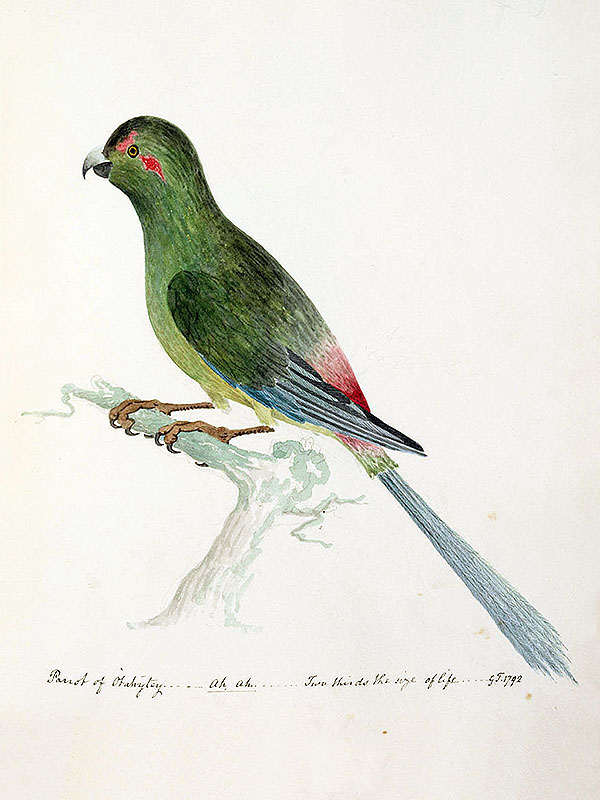
*********************
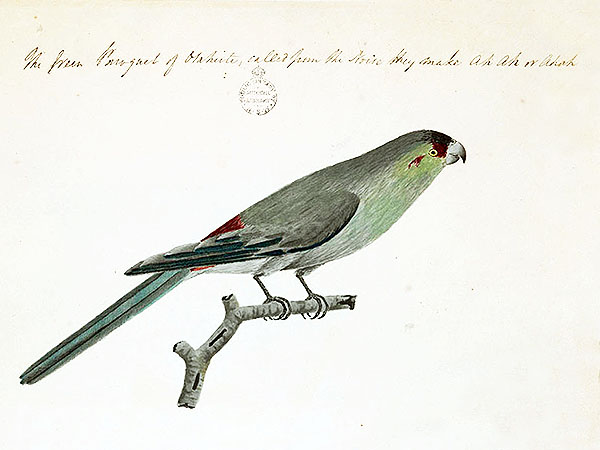
*********************
bearbeitet: 27.10.2019
Christopher Kemp: Die verlorenen Arten: Große Expeditionen in die Sammlungen naturkundlicher Museen. Verlag Antje Kunstmann GmbH 2019
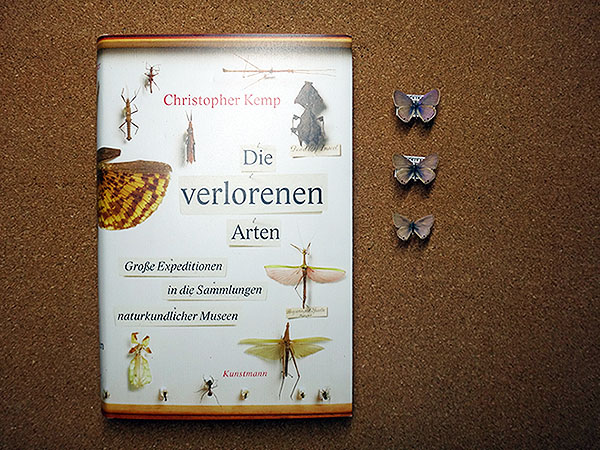
Well, what a book …!
I found this little treasure in an actual bookstore, a rare event these days ….
The author has done a lot of very, very good work, he visited several museums all over the world, and almost like a journalist (but a good one), he also interviewed several scientists to gain information about their respective „obsessions“, some of them are interested in – and specialzed to a special genus of frogs only etc..
The museums all over the world still keep giant collections, some more than 100 years old, that no one has ever seen, let alone catalogized or researched, and, due to job cuts and neglected financing, some of these hidden treasures are now literally crumbling to dust. There are some few scientists who take the challenge to research the sheer ammount of items while revising a special genus of insects or of any other animal or plant etc., and while doing so they almost always discover new species, many of which are already extinct in the localities where they were collected hundreds of years ago.
The book shows us that many museums are treasure troves full of undiscovered biodiversity that need far more attention by the public, and tells the stories of their discoveries, from the first collection to the latest state of things.
I can only recommend this book!
***
This book is also available in English: „The Lost Species: Great Expeditions in the Collections of Natural History Museums“.
*********************
edited: 27.10.2019
A while ago I found this Japanese book about the birds of Micronesia online while searching for I don’t no what, it originally probably included more than these three plates, however, these are the only ones that I could find and I want to share them here because they are so exceedingly beautiful.:
Tokutaro Momiyama: Horyo Nanyo Shoto-san chorui. Tokyo: Nihon Chogakkai: Taisho 11. 1922
(public domain)
***
I will name the birds with their current names in the order in which they are depicted.
*********************
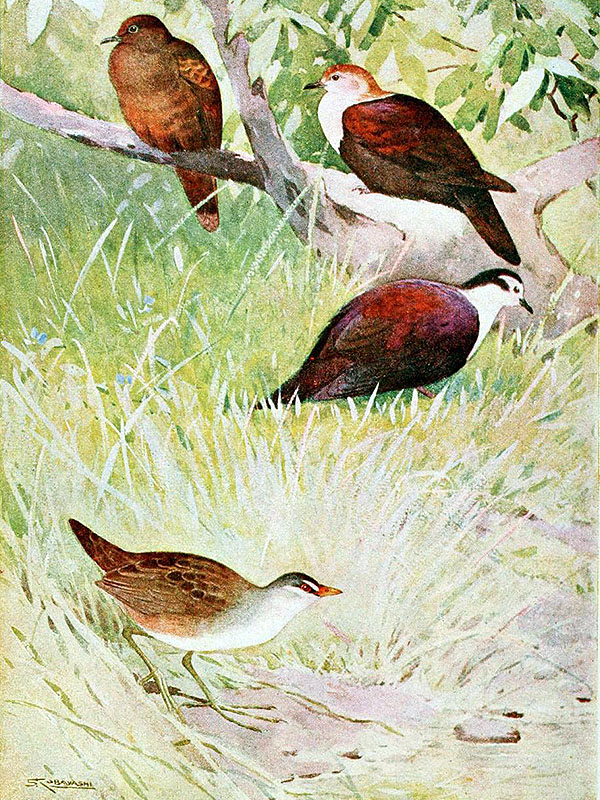


*********************
edited: 20.10.2019
Matthew P. Martyniuk: A Field Guide to Mesozoic Birds and Other Winged Dinosaurs. Pan Aves 2012
*********************
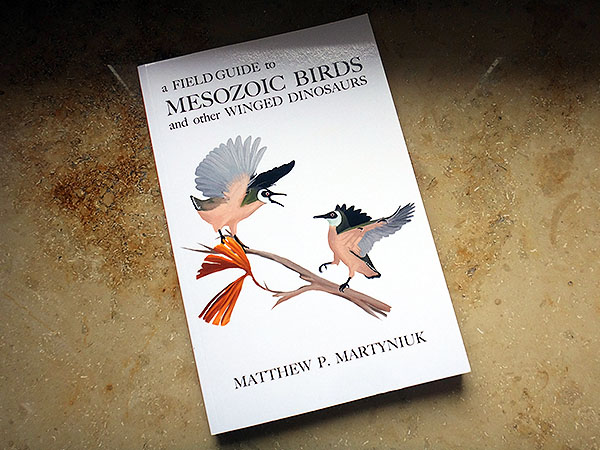
Ich habe dieses Buch schon ein paar Monate, und ich muss gestehen, ich weiß nicht recht wie ich es einordnen soll.
Die Idee des Autors war es, sein Buch wie einen herkömmlichen Field Guide, ein Bestimmungsbuch für unterwegs, aufzubauen und genau das ist ihm auch gelungen. Das Buch umasst hierbei alles was im Mesozoikum gelebt hat und (sowohl wahrscheinlich wie auch tatsächlich) Federn besessen hat (nicht alles davon würde heutzutage als Vogel durchgehen).
In der Einleitung erfährt man, was genau ein Vogel ist, oder, anders ausgedrückt, wie weit man diesen Begriff dehnen kann (… alles was Federn hat ….). Es folgen einige Informationen über den Ursprung der Vögel, den Ursprung der Federn und, vor allem, ein kleiner Überblick über die Vielfalt, die innerhalb dieser Tiergruppe bereits im Mesozoikum geherrscht hat.
Fast jede der vorgestellten Arten ist mit einer Abbildung versehen, die jeweils auf aktuellen wissenschaftlichen Erkenntnissen beruht, weshalb man sich nicht wundern darf, dass die allermeisten Abbildungen eher weniger farbenfroh ausfallen (“Carotinoids be damned” schreibt der Autor hierzu schon als Vorwort).
Ich kann dieses Buch nur empfehlen! 😛
*********************
bearbeitet: 20.10.2019
Der Einfarb-Ameisenpitta ist ein mehr oder weniger völlig schlicht, rötlich gefärbter, typischer Ameisenpitta, der in den dichten Wäldern der Anden und ihrer Ausläufer von Nordbolivien bis in Teile Südvenezuelas lebt.
Der Vogel erreicht eine Größe von etwa 14,5 bis 15 cm.
Die Art ist in sechs Unterarten unterteilt, die nun alle auf den Artstatus hochgestuft werden sollen. Sie werden dann wahrscheinlich wie folgt benannt:
Bolivianischer Ameisenpitta (Grallaria cochabambae J. Bond & Meyer de Schauensee)
Cajamarca-Ameisenpitta (Grallaria cajamarcae (Chapman))
Junín-Ameisenpitta (Grallaria obscura Berlepsch & Stolzmann)
Einfarb- oder Muisca-Ameisenpitta (Grallaria rufula Lafresnaye)
Sierra Nevada-Ameisenpitta (Grallaria spatiator Bangs)
Urobamba-Ameisenpitta (Grallaria occabambae (Chapman))
Diese zukünftigen neuen Arten unterscheiden sich geringfügig im Farbton ihres rötlich gefärbten Gefieders, höchstwahrscheinlich jedoch eher in ihrer DNA.
*********************
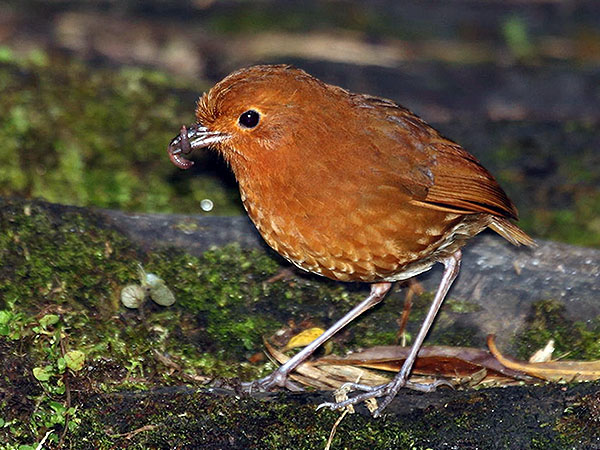
*********************
bearbeitet: 18.04.2024
Heracles inexpectatus, the unexpected Hercules, is a fossil parrot from the St. Bathans fossil site in New Zealand, that just has been described. [1]
The species is known from only two remains, or rather remains of remains to be more precicely, these are a partial left tibiotarsus and a partial right tibiotarsus, that’s just all. The species can be reconstructed as having reached a size of around 1 m, making it the largest known parrot species, dead or alive.
***
Unfortunately, one of the authors of this remarkable species apparently seem to think that the new find isn’t appetizing enough for the press, so added a „fierce beak“ to the description and is even speculating that this species, because of it’s size, must have been a predatory bird, which, of course, is complete bullshit.
According to the paper, the species apparently was a member of the Nestoridae, a family of parrots endemic to New Zealand, and within this family its closest relative appears to be the Kakapo (Strigops habroptilus Grey), a strict herbivor. So, I personally have no idea why one of the authors does such silly speculations.
Whatsoever … there was once a giant parrot rumbling the forests of New Zealand around 19 Million years ago, and that is remarkable enough, at least for me.
*********************
References:
[1] Trevor H. Worthy; Suzanne J. Hand; Michael Archer; R. Paul Scofield; Vanessa L. De Pietri
*********************
I need to write some kind of update here since the British- but also the German press apparently need to call this new species a “Cannibal” and a “Horror-Papagei”, and even claim that some scientist allegedly has suggested that this parrot was eating its smaller conspecific mates.
What a big load of shit, let’s say it together: “SHIT!!!” Which fucking scientist, as they claim, has ever said such a bullshit???
This was, and I bet my left hand for that, a large kakapo, nothing but a harmless, flightless, vegetarian creature, and the press apparently degenerates more and more to a shitpot full of idiots and arseholes.
Many Thanks!
*********************
edited: 08.08.2019
This species was described in 2010, it is known from five or six specimens found in the Messel shale, five of which include cervical vertebrae which again all bear strange small tubercles unknown in any other bird dead or alive.
The bird may or may not be related to the so-called screamers (Anhimidae), it had a quite small head compared to its body and had very large and strong wing bones, thus apparently was good at flying, its feet have short toes which appear to have been somewhat flattened – and my gut feeling tells me that they may have had been webbed ….
*********************

*********************
edited: 07.08.2019
Familie incertae sedis
Elaphrocnemus brodkorbi Milne-Edwards
Elaphrocnemus crex Milne-Edwards
Elaphrocnemus phasianus Milne-Edwards
Gradiornis walbeckensis Mayr
Itaboravis elaphrocnemoides Mayr et al.
Lavocatavis africana Mourer-Chauviré et al.
Ameghinornithae
Ameghinornis minor Gaillard
Ameghinornithidae gen. & sp. ‘Jebel Qatrani Formation, Ägypten’
Ameghinornithidae gen. & sp. ‘Nei Mongol, China’
Strigogyps dubius Gaillard
Strigogyps robustus (Lambrecht)
Strigogyps sapea (Peters)
Strigogyps sp. ‘Eckfelder Maar, Deutschland’
Bathornithidae
Bathornis celeripes Wetmore
Bathornis cursor Wetmore
Bathornis fricki Ostrom
Bathornis geographicus Wetmore
Bathornis grallator Olson
Bathornis veredus Wetmore
Eutreptornis uintae (Cracraft)
Paracrax antiqua Shufeldt
Paracrax gigantea Cracraft
Paracrax wetmorei Cracraft
Cariamidae
Cariama santacrucensis Noriega et al.
Cariamidae gen. & sp. ‘Alto Río Bandurrias, Chile’
Chunga incertis (Tonni)
Noriegavis santacrucensis (Noriega et al.)
Riacama caliginea Ameghino
Idiornithidae
Dynamopteris boulei Gaillard
Dynamopterus gaillardi (Cracraft)
Dynamopterus gallicus (Milne-Edwards)
Dynamopterus gracilis Milne-Edwards
Dynamopterus minor (Milne-Edwards)
Dynamopterus velox Milne-Edwards
Gypsornis cuvieri Milne-Edwards
Oblitavis insolitus Mourer-Chauviré
Occitaniavis elatus (Milne-Edwards)
Propelargus cayluxensis Lydekker
Propelargus olseni Brodkorb
Phorusrhacidae
Andalgalornis steulleti (Kraglievich)
Andrewsornis abbotti Patterson
Devincenzia pozzii (Kraglievich)
Eleutherornis cotei Gaillard
Hermosiornis australis Moreno
Kelenken guillermoi Bertelli, Chiappe & Tambussi
Llallawavis scagliai Degrange et al.
Mesembriornis incertus Rovereto
Mesembriornis milneedwardsi Moreno
Paleopsilopterus itaboraiensis Alvarenga
Paraphysornis brasiliensis (Alvarenga)
Patagornis marshi Moreno & Mercerat
Phorusrhacos longissimus Ameghino
Physornis fortis Ameghino
Procariama simplex Rovereto
Psilopterus bachmanni (Moreno & Mercerat)
Psilopterus lemoinei (Moreno & Mercerat)
Psilopterus affinis (Ameghino)
Psilopterus colzecus Tonni & Tambussi
Titanis walleri Brodkorb
Salmilidae
Salmila robusta Mayr
Salmilidae gen. & sp. `Green River Formation, USA`
*********************
edited: 24.04.2024
This species was described in 2017, it is one of the many birds from the Messel shale, that are somehow related to living ones but on the other hand again … are completely different.
This one is thought to be related to the Charadriiformes, and it may indeed have been a member of the jacana family (Jacanidae).
*********************

*********************
BTW: I only recently learned that the age of the Messel shale spans from the upper Early – to the lower Middle Eocene.
So not every bird from there is from the Middle Eocene.
*********************
edited: 04.08.2019
Dieser rätselhafte Vogel aus dem späten Paläozän frühen Eozän Brasiliens ist nur von einem einzigen, zerbrochenen Tarsometatarsus bekannt, der jedoch offenbar den Kuckucken zugeordnet werden kann.
Ich kann nicht so viel über diesen Vogel sagen, er scheint für eine paläozäne Vogelart ziemlich groß gewesen zu sein, und es könnte tatsächlich ein echter Kuckuck gewesen sein oder es könnte etwas völlig anderes gewesen sein.
***
Ein kleines (längst überfälliges) update … diese Art wird mittlerweile mit der Familie Gracilitarsidae in Verbindung gebracht.
Der Vogel in meiner neuen Rekonstruktion ist immer noch ungefähr 15 cm lang und ungefähr ein Drittel größer als Gracilitarsus mirabilis Mayr, der einzigen anderen bekannten Art der Familie.

*********************
bearbeitet: 28.07.2019
Es dürfte schon aufgefallen sein, dass ich ein bisschen von den Vögeln des Paläozän besessen bin, auch weil wir jede Menge gar nichts über sie wissen, besonders über jene aus dem frühen Paläozän, dem Beginn der “T-Zeit”, der Zeit unmittelbar nach dem K T-Grenze.
Nun, es gibt eine neue Veröffentlichung, die einen Überblick über die Vögel gibt, die genau zu dieser Zeit existierten, an der K/T-Grenze … auf dem Kontinent der Antarktis, um genauer zu sein, aber auch über diese Zeit hinaus bis zum Oligozän. [1]
***
Ich habe diese Veröffentlichung noch nicht vollständig gelesen, aber da fast alle Vogelfossilien aus diesem Gebiet auf einzelne Knochen oder manchmal Teilskelette beschränkt sind, wirft es nicht so viel neues Licht auf die vorherigen Aufzeichnungen.
*********************
Quelle:
[1] Carolina Acosta Hospitaleche; Piotr Jadwiszczak; Julia A. Clarke; Marcos Cenizo: The fossil record of birds from the James Ross Basin, West Antarctica. Advances in Polar science 30(3): 250-272. 2019
*********************
bearbeitet: 25.07.2019
MNT-11-7952 ist ein bemerkenswertes Fossil eines rätselhaften Vogels mit einer außergewöhnlichen Erhaltung; Abdrücke der erhaltenen Schwanzfedern weisen einen bläulich grauen Farbton auf, die Beine und Füße zeigen noch Spuren ihres Weichgewebes.
Dies ist jedoch alles, was bisher bekannt ist. Die beiden Platten enthalten nichts als den Arsch, sorry, den Rumpf, die Beine und die Schwanzfedern.
Die Federn sind sehr lang und schmal und erinnern an die Schwanzfedern der rezenten Mausvögel (Coliiformes). Die Füße scheinen jedoch anisodaktyl (drei Zehen nach vorn, eine nach hinten gerichtet) zu sein, im Gegensatz zu allen bekannten Mausvögeln, ausgestorben oder noch lebend.
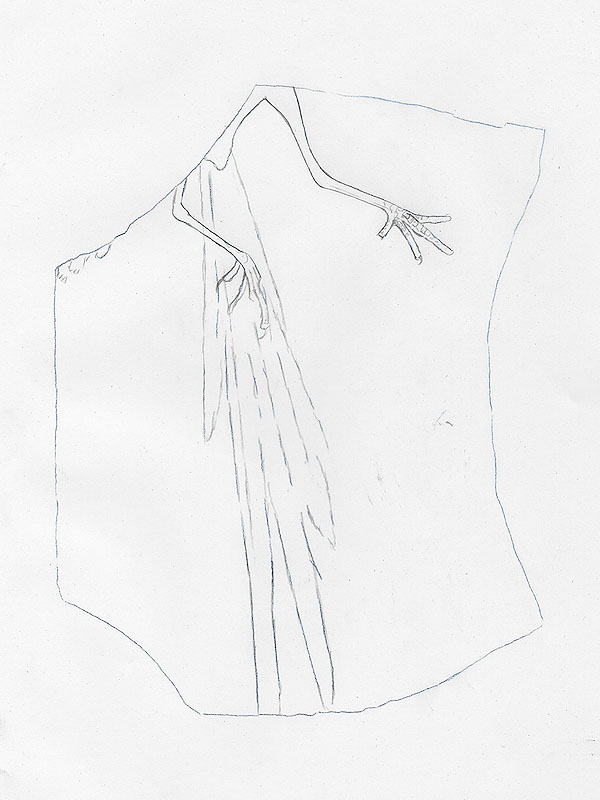

Das Fossil stammt aus dem mittleren Paläozän, ist also 60 bis 61 Millionen Jahre alt, und meiner Meinung nach könnte es sich tatsächlich um einen coliiformen Vogel handeln.
*********************
Hier ist ein kleiner skizzenhafter Versuch, diesen Vogel zu rekonstruieren, der, einschließlich seiner fast 20 cm langen Schwanzfedern, möglicherweise eine Gesamtlänge von ca. 34 cm erreicht haben dürfte, was sehr gut im Größenbereich moderner Mausvögel liegt!
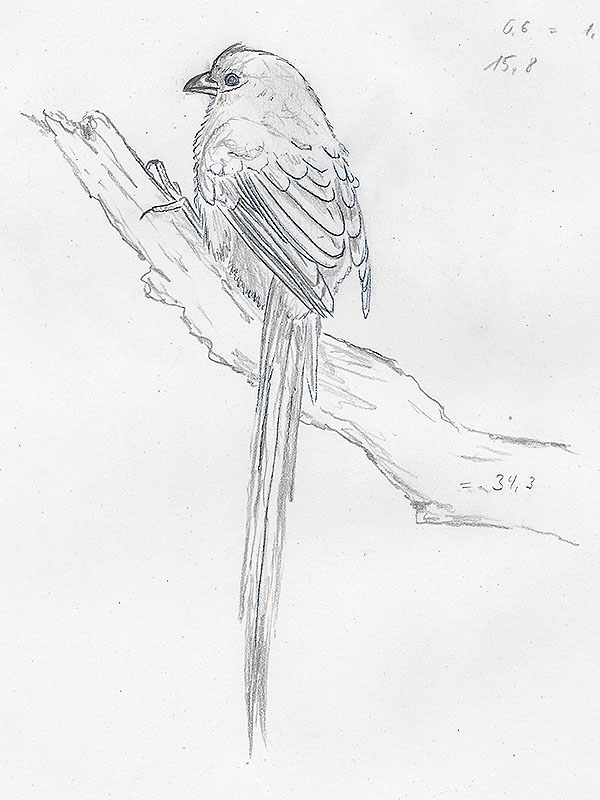
*********************
Quelle:
[1] Gerald Mayr; Sophie Hervet; Eric Buffetaut: On the diverse and widely ignored Paleocene avifauna of Menat (Puy-de-Dôme, France): new taxonomic records and unusual soft tissue preservation. Geological Magazine: 1-13. 2018
*********************
bearbeitet: 24.07.2019
Ein neuer wissenschaftlicher Bericht [1] wurde gerade veröffentlicht, in dem mehrere neue Vogelreste beschrieben werden, leider ohne eine Art zu beschreiben, da diese Überreste einfach zu fragmentarisch sind. Die Überreste selbst stammen aus dem mittleren Paläozän Belgiens und aus dem späten Paläozän Frankreichs.
Es gibt einen sehr kleinen Gastornis sp., einen Lithornithiden, einen Ralloiden und einen nicht zuweisbaren „höheren Landvogel“, alle aus Belgien, und es gibt einen weiteren Lithornithiden, einen Pelagornithiden, einen möglichen Leptosomatiformen und einen wahrscheinlichen Cariamaformen, alle aus Frankreich.
Nun, und das ist eigentlich auch schon fast alles.
*********************
Quelle:
[1] Gerald Mayr; Thierry Smith: New Paleocene bird fossils from the North Sea Basin in Belgium and France. Geologica Belgica 22(1-2): 35-46. 2019
*********************
bearbeitet: 21.07.2019
Enantiophoenix electrophyla Cau & Arduini from the Late Cretaceous of Lebanon, roughly the size of a recent European Starling.
*********************

This species is known from parts of a foot and some very few further remains.
********************
References:
[1] Andrea Cau & Paolo Arduini: Enantiophoenix electrophyla gen. et sp. nov. (Aves, Enantiornithes) from the Upper Cretaceous (Cenomanian) of Lebanon and its phylogenetic relationships. ATTI della Società Italiana di Scienze Naturali e del Museo Civico di Storia Naturale di Milano 149(2): 293-324. 2008
*********************
edited: 14.07.2019
Elektorornis chenguangi Xing, O’Connor, Chiappe, McKellar, Carroll, Hu, Bai & Lei, a bird from the Cretaceous era described just now.
*********************
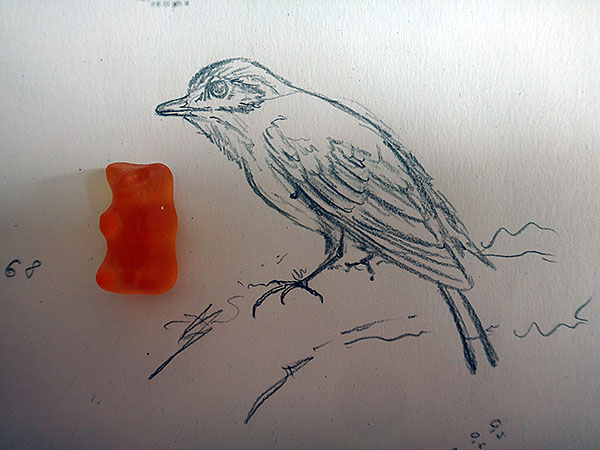
This bird is known only by a single leg with an unusually elongated middle toe and parts of the wing.
I will come back to that bird somewhat later ….
*********************
References:
[1] Lida Xing; Jingmai K. O’Connor; Luis M. Chiappe; Ryan C. McKellar; Nathan Carroll; Han Hu; Ming Bai; Fuming Lei: A new enantiornithine bird with unusual pedal proportions found in amber. Current Biology 29: 1-6. 2019
*********************
edited: 12.07.2019
Podicipedidae
Aechmophorus elasson Murray
Miobaptus huzhiricus Zelenkov
Miobaptus walteri Švec
Miodytes serbicus Dimitreijevich, Gál & Kessler
Pliolymbus baryosteus Murray
Pliolymbus lanquisti Brodkorb
Podicepidae gen. & sp. ‘Truckee A’
Podicepidae gen. & sp. ‘Truckee B’
Podiceps oligocaenus (Shufeldt)
Podiceps arndti Chandler
Podiceps caspicus (Habizl)
Podiceps csarnotatus Kessler
Podiceps discors Murray
Podiceps dixi Brodkorp
Podiceps miocenicus Kessler
Podiceps oligocaenus (Shufeldt)
Podiceps parvus (Shufeldt)
Podiceps sociata (Navás)
Podiceps solidus Kuročkin
Podiceps subparvus (Miller & Bowman)
Podilymbus mujusculus Murray
Podylimbus wetmorei Storer
*********************
edited: 01.07.2019




*********************
bearbeitet: 29.06.2023
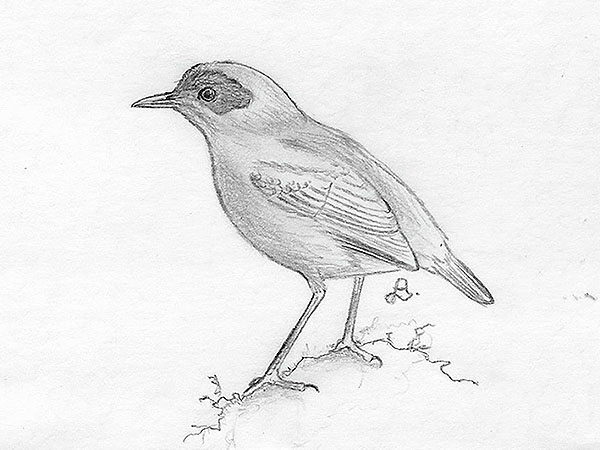
*********************
bearbeitet: 23.06.2019
Today, I doodled some birdies, Rarotonga Starlings.:
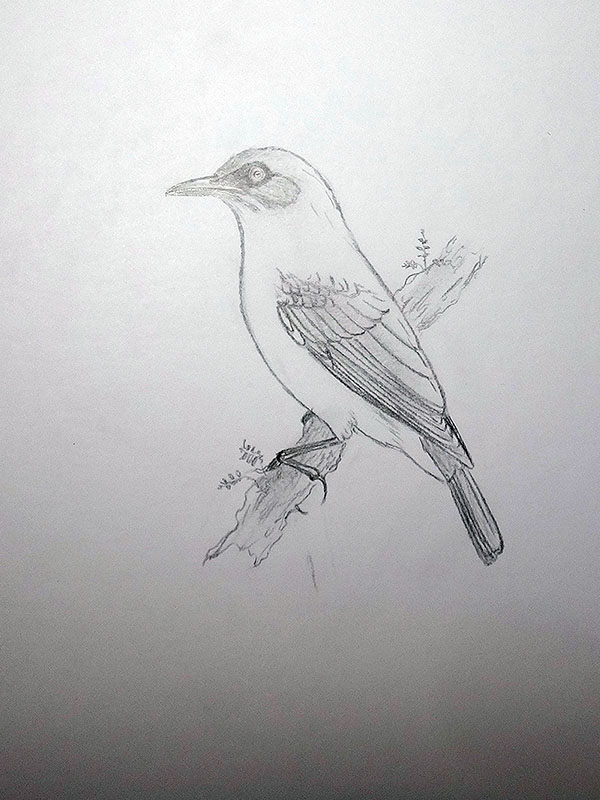
Personally, I like these freehand sketches better, at least the bird on the right, because it looks more lively and less static. :
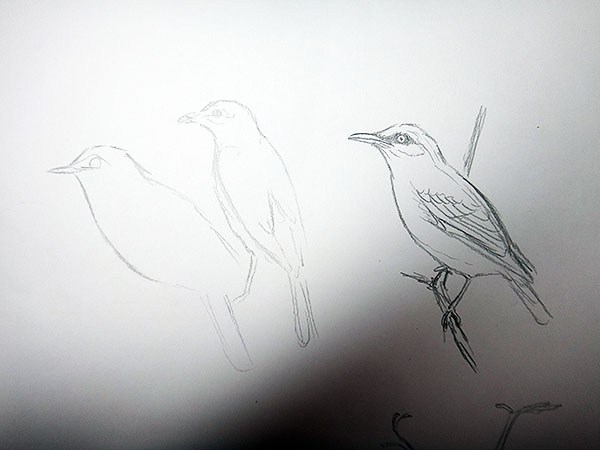
*********************
edited: 12.06.2019
We were in the little zoo in Gotha today where we go almost once a year, and for the first time I took my sketchbook with me, which, however, wasn’t a great idea since there were way too many people and I could not really take the time to sketch something beside that one.:
*********************
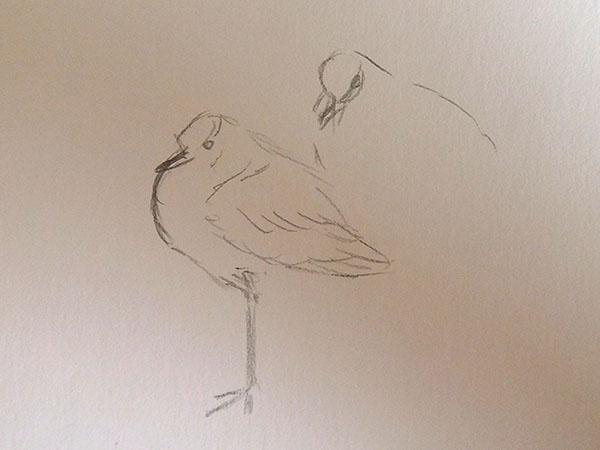
… it’s a Blacksmith Lapwing (Vanellus armatus)
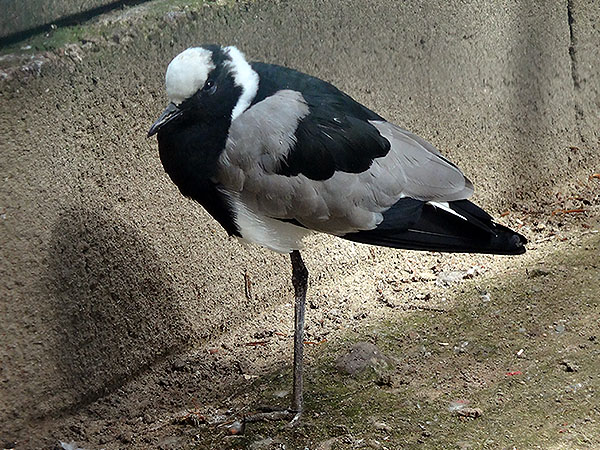
*********************
edited: 10.06.2019
Otididae
Chlamydotis mesetaria Sánchez Marco
Gryzaja odessana Zubareva
Ioriotis gabunii Burchak-Abramovich & Vekua
Miootis compactus Umanskaya
Otis affinis Lydekker
Otis bessarabicus Kessler & Gál
Otis hellenica Boev, Lazaridis & Tsoukala
Otis khozatzki ssp. beremendensis Jánossy
Pleotis liui Hou
*********************
Quelle:
[1] Zlatozar Boev; Georgios Lazaridis; Evangelia Tsoukala: Otis hellenica sp. nov., a new Turolian bustard (Aves: Otididae) from Kryopigi (Chalkidiki, Greece). Geologica Balcanica 42(1-3): 59-65. 2013
*********************
edited: 25.04.2024
Oh well, I did some research, and actually still do … here are the results I got so far.:
The first account dates from November 30th, 1895 and is given by a Dr. Georg Irmer, who was the Imperial German Government District Administrator in the Marshall Islands, which were a German overseas colony back then.
In his account he gives a bit information of some birds he saw when he inspected the Taongi Atoll (now Bokok) to collect guano samples for analysis and to reaffirm the German claim to the island, he mentions seabirds and a large ground-dwelling bird which he named a ‘Trappe‘, the German term for a bustard. He gives no further description or whatsoever, but it is thought that he might not have seen any of the birds commonly known from the Marshall Islands because neither he nor his Marshallese crew were able to identify that bird.
Given his name for the bird, ‘Trappe‘, it is quite likely that he indeed saw a rail of the genus Gallirallus, very much like the one that once inhabited the Wake Atoll to the north of the Marshall Islands. [4]
***
The second account comes from the natives of the Marshall Islands and was forwarded by them to the German ‘anthropologists’ who explored these islands at the beginning of the 20th century.
It is a bird named as the anang-, annan-, or annang. This is said to have been a very small bird (the size of a butterfly (!)), and to have possessed a pleasant smell, it is said to have lived among the rocks around the shores of the northern Marshall Islands. The bird is known from oral traditions at least from the Jaluit-, and the Wotho Atoll, and it is always said to have been a ground-dwelling singing bird.
This may in fact be a description of a Turnstone (Arenaria interpres (L.)), a species that winters in Micronesia and that was very much appreciated, for example by the inhabitants of Nauru, who cought them not to eat them but to tame them and keep them as pets.
Or it is the description of a small crake or a reed-warbler, mixed with some phantastic components. [4]
***
The third account comes from Paul Hambruch, a German ethnologist that researched the life of the natives of the island of Nauru, his accounts are merely stories that were told him by a native named Auuiyeda, and which he translated into German.
Let’s read them.:
“Es gibt auch Vögel auf Nauru, wie Fregattvogel, schwarze Seeschwalbe, weiße Seeschwalbe, Regenpfeifer, Brachvogel, Möve, Schnepfe, Uferläufer, Ralle, Lachmöve und Rohrdrossel.” [1]
translation:
“There are also birds on Nauru, as frigate bird, black tern, white tern, plover, curlew, gull, snipe, sandpiper, rail, black-headed gull and reed thrush.“
And he goes on.:
“Die Vogelwelt ist nach Zahl und Art reicher. Der Fregattvogel (Tachypetes aquila), itsi, die schwarze Seeschwalbe (Anous), doror, die weiße Seeschwalbe (Gygis), dagiagia, werden als Haustiere gehalten; der erste galt früher als heiliger Vogel, mit den beiden anderen werden Kampfspiele veranstaltet. Am Strande trifft man den Steinwälzer (Strepsilas interpres), dagiduba, den Regenpfeifer (Numenius), den Uferläufer (Tringoides), ibibito, die Schnepfe, ikirer, den Brachvogel ikiuoi, den Strandreiter iuji, die Ralle, earero bauo und zwei Möwenarten (Sterna), igogora und ederakui.
Im Busche beobachtet man an den Blüten der Kokospalme den kleinen Honigsauger raigide, die Rohrdrossel (Calamoherpe syrinx), itirir und den Fliegenschnäpper (Rhipidura), temarubi.” [1]
translation:
“The bird world is richer by number and species, The frigate bird (Tachypetes aquila), itsi, the black tern (Anous), doror, the white tern (Gygis), dagiagia, are kept as pets; the first one was formerly considered a holy bird, with the two others are used for fighting games. At the beach one mets with the turnstone (Strepsilas interpres), dagiduba, the plover (Numenius), the sandpiper (Tringoides), ibibito, the snipe, ikirer, the curlew, ikiuoi, the beach rider [?] iuji, the rail, earero bauo and two gull species (Sterna), igogora and ederakui.
In the bush one observes on the flowers of the coconut palm the small honeyeater raigide, the reed thrush (Calamoherpe syrinx), itirir and the flycatcher (Rhipidura), temarubi.“
The author is usually thought to have misinterpreted the things he was told by Auuiyeda, but I personally doubt that somehow, all the mentioned landbirds make in fact sence for georaphical reasons, so, why not?
Nauru is now almost deserted, the whole island looks like a building site – and it actually is one! There are some sad rests of the forest that once covered the whole island, and indeed some landbirds still manage to survive in small numbers, one of them, the Nauru Reed-Warbler (Acrocephalus rehsei (Finsch)) is even an endemic species, there’s no reason not to accept the former presense of a fantail, a honeyeater, and especially a rail, no reason at all!
These birds, especially the rail, may already have been extirpated by the beginning of the 20th century, leaving only memories and storys told by the islanders.
***
And last but not least, here the fourth account of birds from the Namoluk Atoll, Chuuk, that were enumerated by Max Girschner, another German who had lived in Micronesia at the beginning of the 20th century, he was a colonial offical, a doctor, and an ethnologist.
I have no access to his accounts, but I can give you quotations of them by Mac Marshall from 1971, here they are.:
“Ponape Lory (no Namoluk name)
Trichoglossus rubiginosus
Extinct breeder.
According to Girschner (1912:126), this species was blown to Namoluk in a typhoon in 1905, and apparently it still occurred on the atoll at the time of his visit. there are no lories at present on Namoluk nor can anyone alive on the atoll in 1971 remember seeing them.” [2]
According to Donald W. Buden this whole information is unlikely, and if these parrots have ever occurred on the Namoluk Atoll at all, they must have been brought there by people. [3]
I personally think … why not, typhoons may indeed blow parrots from one island to another, or how did the loris themselves came to end up on the island of Pohnpei in the first place?
But wait, there’s more.:
“A second bird mentioned by Girschner that no longer is found on Namoluk is “a small black and white bird” for which he gives the name lipukepuk.” [2]
The author states that this can only be the description of a New Hanover Mannikin (Lonchura (hunsteini ssp.) nigerrima (Rothschild & E. J. O. Hartert)), which does not occur anywhere in Micronesia and which is not black and white by the way. The bird he is actually referring to is Hunstein’s Mannikin (Lonchura hunsteini ssp. minor (Yamashina)), which again is very well occuring in Micronesia, at least on the island of Pohnpei (yes, again), and which is at least blackish and greyish ….
To me the whole account sounds very much like a nice description of the Truk Monarch (Monarcha rugensis (Hombron & Jacquinot)), and given the fact that most island-dwelling birds in Micronesia also occur on nearby atolls it is quite possible that there once was a native population of this bird here as well.
But we will probably never know for sure.
***
The most interesting things that I found out so far are.:
1: Micronesian bird names are odd (to my ears and eyes), I mean the Palau Ground Dove (Pampusana canifrons (Hartlaub & Finsch)) for example is named omekrengukl, I do not even know how to pronounce that. 🙂
2: Micronesia harbors only 148 native breeding bird species (including the extinct ones!).
3: The Micronesian landbirds do not only occur on the higher islands but also on the atolls, even on those atolls that are quite far away from the next high islands, a situation that is completely different from Polynesia, where the high islands almost entirely harbor a different avifauna than the atolls.
There may have been more species once, especially when we fill some of the illogical gaps between the islands and island groups.
*********************
References:
[1] Paul Hambruch: Nauru. Ergebnisse der Südsee-Expedition 1908-1910. II. Ethnographie: B. Mikronesien, Band 1.1 Halbband. Hamburg, Friedrichsen 1914
[2] Mac Marshall: The natural history of namoluk Atoll, eastern Caroline Islands. Atoll Research Bulletin 189: 1-53. 1975
[3] Donald W. Buden: The birds of Satawan Atoll and the Mortlock Islands, Chuuk, including the first record of Tree Martin Hirundo nigricans in Micronesia. Bulletin on the British Ornithologists’ Club 126(2): 137-152. 2006
[4] Dirk H. R. Spennemann: Extinctions and extirpations in Marshall Islands avifauna since European contact – a review of historic evidence. Micronesia 38(2): 253-266. 2006
*********************
edited: 04.01.2024
Have you ever heard of Lamotrek, Ngulu, or Woleai?
No?
Neither did I ….
These are the names of some of the atolls that form a squadron-like swarm around the Yap Islands – you have also never heard of the Yap Islands?
Well, let me help you out here, the Yap Islands are a part of the Federated States of Micronesia, which again are a part of Micronesia which is a name for the region of small islands that lie east of the Philippines, north of New Guinea, the Solomons and Vanuatu, and west of Polynesia.
***
I asked for the name Woleai especially because I only recently found out that the White-breasted Waterhen (Amaurornis phoenicurus (Pennant)) ‚recently‘ expanded its area of distribution from Southeast Asia to exactly this part of Micronesia. [1]
The photo below shows that species, the name of the photographer is just a coincidence, I swear. 🙂
I wrote ‚recently‘ in quotation marks because this bird apparently appeared here already in the 1970s, but no one took any notice of that until 2009, when some westerners cought one bird on the Woleai atoll.
This event is a very good exemplary for the whole state of the ornithological research in that region – we just do not know anything.
*********************
References:
[1] Donald W. Buden; Stanley Retogral: Range expansion of the White-breasted Waterhen (Amaurornis phoenicurus) into Micronesia. The Wilson Journal of Ornithology 122(4): 784-788. 2010
*********************

*********************
edited: 01.06.2019
The genus Pareudiastes consists of two species that both are known from historical times, meaning ‘having been seen’ by western scientists. We can probably add at least two undescribed extinct forms that are known exclusively from scanty subfossil remains, one from Fiji and one from the Solomon Islands.
The two species of which at least skins remain are very little known, the puna’e (Pareudiastes pacificus Kubary, Hartlaub & Finsch) from Samoa is in fact the best known of them.
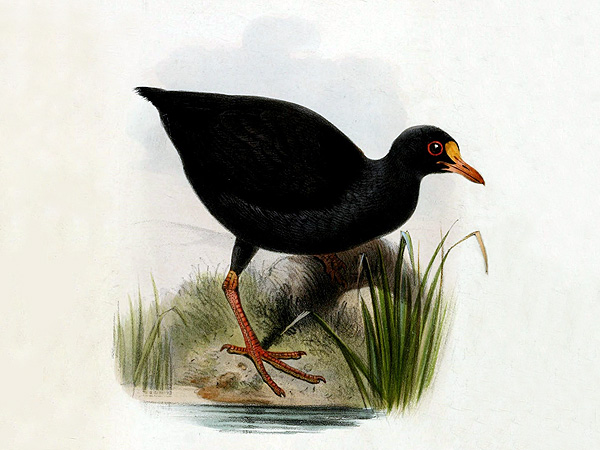
***
The puna’e, whose name roughly translates as “springs up“, is known to have inhabited the rainforests of Savai’i, Samoa; it is said by the natives to have lived in burrows, which were longer than a man’s arm and which ended in a sort of chamber in which the bird slept during the day.
The large eyes of the species indeed point to a somewhat nocturnal habit.
When the bird was disturbed it jumped up from its burrow with fluttering wings but being flightless it landed shortly after and run away quickly.
It is furthermore known that it was not a vegetarian species, since it died when it was fed with plant material but was “happy” when fed with insects.
***
There is at least one reliable account that indicates that this species also inhabited the neighboring island of ‘Upolu.:
“The Samoans always speak of the Pareudiastes as the ‘bird which burrows like a rat.’ Again and again when I have put the question to a native, ‘Do you know the Puna’ e?’ the reply has been, ‘No, I have never seen it; but that is the bird of which the old people speak that it used to be very plentiful long ago, and that it burrows like a rat and lives underground.’ It is very rarely that I have met with any one who has seen the bird; but I have met with two persons who have actually taken it in its burrow. The first is a man well known to me, and in whose veracity I have faith. He says that about four years ago [ca. 1870] he was one of a large party hunting feral pigs in the mountains of Upolu, when they came upon a burrow which one of the party pronounced to be the hole of a Puna’e. My informant says that he put his arm into the hole, and at its extremity (which he could barely reach) he found the bird. He drew it out, and, taking it home, tried to tame and feed it; but it would not eat, and soon died.” [1]
Yet, how is this possible? The islands of Savai’i and ‘Upolu are separated by the 13 km wide Apolima strait.

***
During the Pleistocene, the sea level was lower and Manono very likely was connected with ‘Upolu, but Apolima was not, and Savai’i and ‘Upolu also weren’t connected.
So, how did a flightless bird manage to get from one island to the other?
The answer might be that the Puna’e wasn’t flightless at the time when the sea level was lower, or that the birds from ‘Upolu represented a distinct (sub)species.
***
What do we know about the second historical known species, the Makira Woodhen (Pareudiastes silvestris (Mayr))?
This species is known from a single specimen that was taken in 1929 on the island of Makira, Solomon Islands in montane forest at an elevation of about 600 m, only its skin was preserved, the bones not, and it apparently was flightless or at least nearly so.
The natives called it kia and hunted it with dogs.
That’s all.
The species was apparently still ‘well-known’ by the natives in 1953, and they also said that it was not rare, nevertheless not a single one was ever seen since (by western scientists).
The Makira Woodhen, or Kia, however, is the sole member of this genus that may in fact still survive, and I personally hope that it might be rediscovered someday.
***
The two additional forms are, as I’ve said before, known only from some scanty subfossil remains found on the island of Buka in the northernmost part of the Solomon Islands as well as on Viti Levu, the largest of the Fijian Islands respectively.
***
The genus Pareudistaes should be merged with the genus Gallinula, by the way.
*********************
References:
[1] Letter from Rev. S. J. Whitmee. In: Proceedings of the Zoological Society of London 1874: 183-186
*********************
edited: 04.07.2023
Family incertae sedis
Chupkaornis keraorum Tanaka et al.
Judinornis nogotsavensis Nessov & Borkin
Pasquiaornis hardiei Todaryk, Cumbaa & Storer
Pasquiaornis tankei Todaryk, Cumbaa & Storer
Potamornis skutchi Elzanowski, Paul & Stidham
Baptornithidae
Baptornis advenus Marsh
Brodavidae
Brodavis americanus Martin et al.
Brodavis baileyi Martin et al.
Brodavis mongoliensis Martin et al.
Brodavis varneri (Martin & Cordes-Person)
Enaliornithidae
Enaliornis barretti Seeley
Enaliornis sedgwicki Seeley
Enaliornis seeleyi Galton & Martin
Hesperornithidae
Asiahesperornis bazhanovi Nesov & Prizemlin
Canadaga arctica Hou
Fumicollis hoffmani Bell & Chiappe
Hesperornis altus (Marsh)
Hesperornis bairdi Martin & Lim
Hesperornis chowi Martin & Lim
Hesperornis crassipes (Marsh)
Hesperornis gracilis Marsh
Hesperornis lumgairi Aotsuka & Sato
Hesperornis macdonaldi Martin & Lim
Hesperornis mengeli Martin & Lim
Hesperornis montana Schufeldt
Hesperornis regalis Marsh
Hesperornis rossicus Nesov & Yarkov
Parahesperornis bazhanovi Nessov & Prizemlin
*********************
edited: 30.06.2019

*********************
bearbeitet: 28.05.2019
Levaillant’s Sicrin de l’Imprimerie de Langlois, apparently meaning ‘Sicrin from the print of Langlois’ (?) is a strange bird drawn by Johann Friedrich Leberecht Reinhold that I discovered while flicking through the volumes of François Le Vaillant’s ‘Histoire naturelle des oiseaux d’Afrique’ from 1799.
Here it is.:
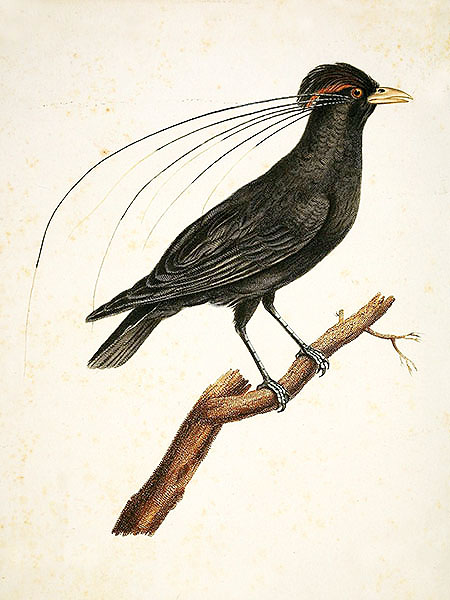
I must confess, first I had absolutely no idea what this astonishing bird is supposed to have been, it looks like some corvid bird, or a starling, possibly one of the strange starling species from the Philippine Islands, but what about the six porcupine spines in its face?
The bird is said to have been found at the Cape of Good Hope, South Africa, what I very much doubt it has, Monsieur Le Vaillant furthermore places it amongst the Jackdaws.
But let’s now just see what else Monsieur Le Vaillant has to tell us about this bird.:
„Le Sicrin est une espèce absolument nouvelle, et dont aucun naturaliste n’a fait mention encore; je fai placé parmi les choucas, parce que ce sont les oiseaux desquels je trouve qu’il se rapproche le plus, pour les formes de son bec, de ses pieds et de son corps. Au reste, si par la suite quelque voyageur nous apprend ses moeurs, que nous ignorons totalement, on lui donnera une autre place, si on juge qu’elle lui convienne mieux. Quant à moi, je le crois un vrai choucas, et cela pour l’avoir comparé attentivement avec tous les oiseaux de ce genre; je trouve même qu’il ressemble tellement au choquart ou choucas des Alpes, que si on lui retranchoit les six crins et la huppe qui le caractérisent si bien, on en feroit absolument le même oiseau; il est aussi de la même taille, mais il m’a paru un peu plus gros de la poitrine: il est vrai que, n’ayant vu cet oiseau qu’empaillé, il pourroit se faire qu’il ne dut sa rotondité quà une plus grande extension de la peau; cependant elle ne ma pas paru excessivement bourrée, puisque la peau n’étoit pas très-tendue. Le bec est absolument semblable aussi à celui du choquart, sinon qu’il est un peu plus pointu et plus épais à sa base. La queue est de même carrément coupée par le bout c’est-à-dire, que toutes ses pennes sont aussi longues les unes que les autres. Les aîles pliées s’étendent aux deux tiers de la longueur de la queue, qui a dix pennes.“ [2]
translation:
“The Sicrin is an absolutely new species, and of which no naturalist has yet reported; I did place them among the jackdaws, because they are the birds to which I find it comes closest, for the shapes of its beak, feet and body. For the rest, if afterwards some traveler informs us of more, which we are totally unaware of, we will give it another place, if we judge that it suits it better. As for me, I believe it to be a real jackdaw [M. Le Vaillant apparently was not that good in taxonomy ….], and that for having compared it attentively with all the birds of this kind; I even think that it resembles so much the cough or jackdaw of the Alps, that if we cut off the six horsehair [… actually real horse hair stucked into the bird?] and the crest that characterize it so well, we would make absolutely the same bird; it is also of the same size, but it seemed to me a little bigger of the breast: it is true that, having seen this bird only tempered [?], it could be done that it had its rotundity only to a greater extension of the skin; however it did not seem to me excessively drunk, since the skin was not very tense. The bill is absolutely similar to that of the cough, except that it is a little more pointed and thicker at its base. The tail is likewise cut off by the end, that is to say, that all its feathers are of equal length. The folded wings extend to two-thirds of the length of the tail, which has ten feathers.”
and
„Cet oiseau est remarquable par les crins ou longues plumes sans barbes qui ornent les côtés de sa tête, (à peu près comme dans l’espèce d’oiseaux de paradis que Buffon a nommée le sifilet), et par une belle huppe flottante qui, se couchant en arrière, ombragela tête. Les pieds sont conformés comme ceux du choquart; le bec est d’un jaune de citron, et prend une teinte d’orange sur son arête supérieure et vers les narines; celles-ci sont couvertes de poils ou plumes déliées, qui se dirigent en avant comme chez tous les oiseaux du genre des corbeaux. Les pieds et les ongles sont noirs.“ [2]
translation:
„This bird is remarkable for the hair or long feathers without barbs, which decorate the sides of its head (almost as in the species of bird of paradise that Buffon named the Sifilet [Western Parotia (Parotia sefilata (J. R. Forster))], and by a beautiful floating crest which, lying backward, shades its head. The feet are shaped like those of the cough; the beak is lemon yellow, and has an orange hue on its upper ridge and towards the nostrils; these are covered with loose hairs and feathers, which go forward as in all the birds of the crow kind. The feet and nails are black.“
and
„Il est plus que probable que ces oiseaux ont la faculté de redresser ces filets, et par conséquent de les resserrer contre le corps dans l’action du vol, dont ils gêneroient les mouvemens s’ils balotoient au gré des vents: je présume du moins cette faculté, d’après la longueur du tuyau qui s’implantoit dans la peau, et qui étoit trop grand pour ne pas faire soupçonner qu’il devoit pénétrer dans un muscle extenseur, propre à le faire mouvoir au gré de l’oiseau: ce qui me le donnoit encore à penser, c’est que dans la partie de la joue où ils entroient, toute la peau étoit plus épaisse et plus dure que par-tout ailleurs, et qu’on y remarquent très-distinctement une cavité profonde oùse logeoit le tuyau du filet que j’avois arraché, comme on le voit sur la métacarpe et le croupion de tous les oiseaux, quand on leur détache une penne soit de l’aîle ou de la queue. Je ne hasarderai point de désigner l’usage dont ces barbes peuvent être à cet oiseau, ni quel but s’est proposé la nature dans cette singulière production, que je regarde, au reste, comme un simple ornement. Combien de fois nos philosophes ne se sontils pas trompés et n’ont-ils pas égaré les autres hommes, lorsqu’ils ont voulu donner raison des causes que la nature avoit sans doute destinées à rester cachées aux foibles humains, d’un côté trop au-dessous de sa puissance pour les concevoir, et d’un autre trop audacieux peut-être pour être initiés, sans danger, dans ses mystères! O nature! il y a longtems, hélas! que les aveugles mortels auroient détruit ton ouvrage, et troublé cette belle harmonie de l’univers s’ils avoient pu te suivre dans ta marche et te deviner un seul instant!“ [2]
translation:
„It is more than probable hat these birds have the faculty of straightening these filaments, and consequently of tightening them against the body in the action of the flight, of which they disturb the movements if they struggle with the winds: I presume at least this faculty, according to the length of the pipe which was implanted in the skin, and which was too large not to make us suspect it had to penetrade into an extensor muscle, capable of causing it to move at the whim of the bird: what gave me still to think is, that in the part of the cheek they entered, the whole skin was thicker and more lasting than anywhere else, and we remark very distingly a deep cavitiy where the tube of the net which I had thorn off, as one sees on the metacarpus and the rump of all the birds, when one detaches a quill either of the ellbow or the tail. I will not venture to designate the use of which these beards can to be to this bird, nor what goal has nature proposed itself in this singular production, which I regard, moreover, as a simple ornament. How many times have our philosophers become unaccustomed to themselves, and have they not treated other men when they wished to give reason to the causes which nature had doubtless intended to remain hidden from the eak human beings, on the one hand too much below its power to to conceive them, and another too audacious perhaps to be initiated, without danger, into his mysteries! O nature! Long ago alas! That the blind mortals would have destroyed your work, and disturbed this beautiful harmony of the universe if they could have followed you in your march and guess you one moment!“ [what the ***, was he drunk here?]
By the way I could not find out what ‚Sicrin‘ is supposed to mean.
For about one day I was quite sure that this bird is nothing but a made-up piece, probably a Parotia species, for example the Western Parotia (Parotia sefilata (J. R. Forster)), with the glossy breast-shield feathers and the spatulate vanes of the six ornamental feathers below the eyes having been removed – even before translating and reading all the stuff above.
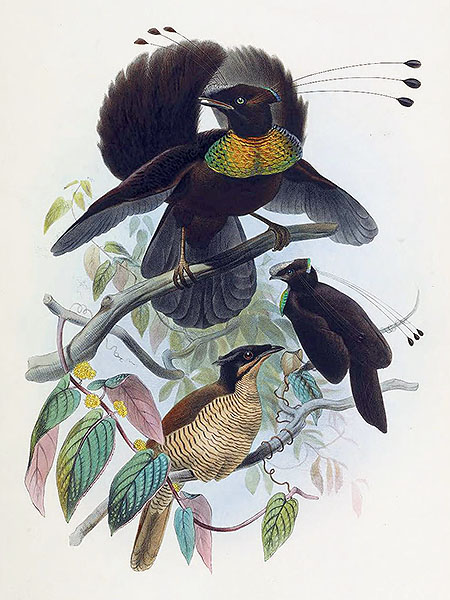
Well, well, but reading the original ‚description‘ including another, much older depiction, I am quite convinced that this mysterious bird is something completely different ….
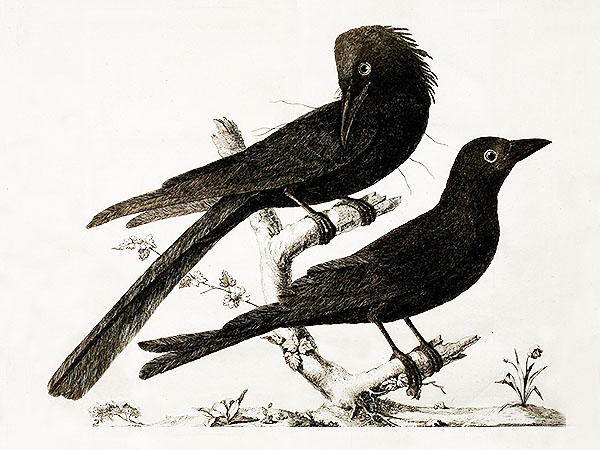
a section of the original ‘description’:
“Il est à peu près de la grosseur du précédent. Sa longueur depuis le bout du bec jusqu’à celui de la queue est d’onze pouces quatre lignes, & jusqu’à celui des ongles de huit pouces dix lignes. Son bec depuis sa pointe jusqu’aux coins de la bouche a un pouce six lignes de long; sa queue cinq pouces; son pied douze lignes; & celui du milieu des trois doigts antérieurs, joint avec l’ongle, douze lignes & demie: les latéraux sont un peu plus courts; & celui de derriere est presque aussi long que celui du milieu de ceux de devant. Il a un pied sept pouces trois lignes de vol, & ses aíles, lorsqu’elles sont pliées, s’étendent jusqu’à la moitié de la longueur de la queue. La tête, la gorge & le col sont couverts de plumes d’un noir-verd très – brillant, celles de la partie supérieure du col font très – étroites & beaucoup plus longues que les autres. Elles glissent sur le dos sélon les différens mouvemens de la tête & du col. Les plumes qui retombent sur les narines sont d’un noir de velour. Audessus de ces plumes partent de l’origine du demi-bec supérieur quelques poils noirs, longs de trois pouces & très-fléxibles: & au-dessous tout le long de la bâse du bec, jusque vers les coins de la bouche, sont d’autres poils noirs, beaucoup plus courts & roides comme des soyes. Le dos, le croupion, la poitrine, le ventre, les côtés, les jambes & les couvertures du dessus & du dessous de la queue sont d’un noir de velours changeant en verd brillant. Celles du dessus & du dessous des aîles sont d’un noir-verd éclatant & changeant en violet. Les plumes des aíles sont de la même couleur endessus du côté extérieur feulement, & noires du côté intérieur; & en-dessous elles sont noirâtres. La première des plumes de l’aíle est plus courte de deux pouces sept lignes que la quatrième & la cinquième, qui sont les plus longues de toutes. Les plumes de la queue, qui sont toutes d’égale longueur, sont d’un noir-verd en-dessus & tout-à-fait noirâtres en-dessous. Le bec, les pieds & les ongles sont noirs. On le trouve au Cap de Bonne Esperance, d’où il a été apporté à M. l’Abbé Aubry, qui le conserve dans son cabinet.“
translation:
“He is about the size of the preceding. Its length from the tip of the beak to that of the tail is eleven inches four lines, & up to that of the nails eight inches ten lines. Its beak from its point to the corners of the mouth is one inch six lines long; his tail five inches; his foot twelve lines; & that of the middle of the three anterior toes, joined with the nail, twelve lines & a half: the lateral ones are a little shorter; & the one behind is almost as long as the one in the middle of the front ones. He has one foot seven inches three flight lines, & his wings, when folded, extend to half the length of the tail. The head, the throat, & the neck are covered with feathers of very brilliant black-green, those of the upper part of the neck are very narrow & much longer than the others. They slide on their backs, according to the different motions of the head & the collar. The feathers that fall on the nostrils are of a black velvet.Above these feathers, from the origin of the upper half-beak, are a few black hairs, three inches long & very flexible; & below all the length of the bill-body, as far as the corners of the mouth, are other black hairs, much shorter & stiff like sores. The back, rump, chest, belly, sides, legs & covers of the top & bottom of the tail are velvet black, shiny green. Those on the top and bottom of the elbows are of a shiny black-green & changing into violet. The feathers of the birds are of the same color, on the outer side, & black on the inner side; & below, they are blackish. The first of the feathers of the ale is shorter by two inches seven lines than the fourth & the fifth, which are the longest of all. The feathers of the tail, which are all of equal length, are of a black-green above & quite blackish below. The beak, the feet & the nails are black. It is found at the Cape of Good Hope from where it was brought to the Abbé Aubry, who keeps it in his cabinet.” [1]
… a Hair-crested Drongo (Dicrurus hottentottus ssp. hottentottus (L.)) originally described in 1766, also as being from the Cape of Good Hope, South Africa, by the way.

This bird actually comes from Southeast Asia, where it has a quite wide distribution, doesn’t it fit well with the description? 🙂
*********************
[1] Mathurin-Jacques Brisson: Ornithologie, ou, Méthode contenant la division des oiseaux en ordres, sections, genres, especes & leurs variétés: a laquelle on a joint une description exacte de chaque espece, avec les citations des auteurs qui en ont traité, les noms quils leur ont donnés, ceux que leur ont donnés les différentes nations, & les noms vulgaires. Vol 2. Parisiis: Ad Ripam Augustinorum, Apud Cl. Joannem-Baptistam Bauche, Bibliopolam, ad Insigne S. Genovesae, & S. Joannis in Deserto 1760
[2] François Le Vaillant: Histoire naturelle des oiseaux d’Afrique. A Paris: Chez J. J. Fuchs, Libraire, Rue des Mathurins, Hótel de Cluny. Vol. 2. 1799
*********************
edited: 15.05.2019
Alcmona-‘Vogel’ (Alcmonavis poeschli Rauhut, Tischlinger & Foth)
Diese Art, die gerade erst beschrieben wurde, ist nur anhand von Teilen der Flügel, bzw. eines Flügels, bekannt (siehe Foto).
***
Der ‘neue Vogel’ lebte in was vor 150 Millionen Jahren der so genannte Solnhofen-Archipel war, Seite an Seite mit den berühmten Archaeopterygidae, war aber offenbar nicht sehr nah mit diesen verwandt.
Die wenigen Knochen sind, zumindest für meine Augen, äußerlich denen von Archaeopteryx albersdoerferi Kundrát et al. und Wellnhoferia grandis Elżanowski oder vielleicht sogar Jeholornis prima Zhou & Zhang aus China ziemlich ähnlich; sie zeigen aber immerhin, dass dieses Tier besser ans Fliegen angepasst war als die zeitgleich existierenden ‘Urvögel’, darüber hinaus wird er aber, zumindest äußerlich, recht ähnlich ausgesehen haben.
***
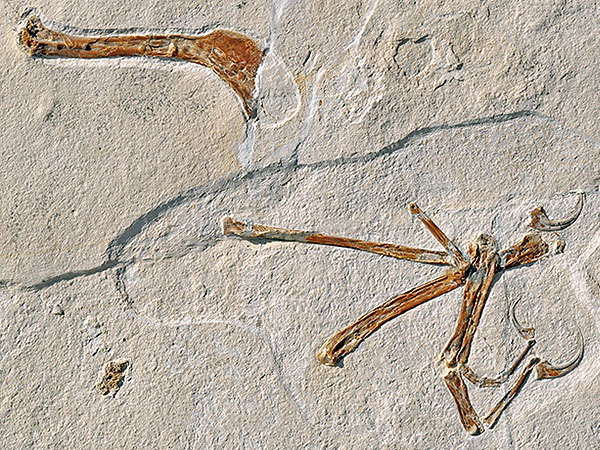
Bis jetzt wurden nur die Überreste eines einzigen Arms, bzw. Flügels gefunden – ich hoffe es werden weitere Funde folgen.
*********************
Quelle:
[1] Oliver W. M. Rauhut; Helmut Tischlinger; Christian Foth: A non-archaeopterygid avialan theropod from the Late Jurassic of southern Germany eLife DOI: 10.7554/eLife.43789.001. 2019
*********************
bearbeitet: 15.05.2019
During the last few days the online newspapers were trying to outdo each other with silly headlines, headlines like … :
“The bird that came back from the dead” or: “Extinct species of bird came back from the dead, scientists find” or, the worst of them all: “Scientists discover bird that came back from the dead – A species which became extinct 136,000 years ago in a rare flood on an Indian Ocean atoll has now re-emerged in the same place“
***
What is wrong with that?
Well, a lot, but let’s just start with the statement that their isn’t any species that really goes extinct and then comes back, also not a rail species!
We actually deal with two distinct species here, or let’s rather say, with two distinct taxa, since they may not be species but subspecies.
***
May I introduce the White-throated Rail (Dryolimnas cuvieri (Pucheran)), a very beautiful rail species that is endemic to the island of Madagascar and that apparently has also colonized the island of Mayotte northeast of Madagascar.
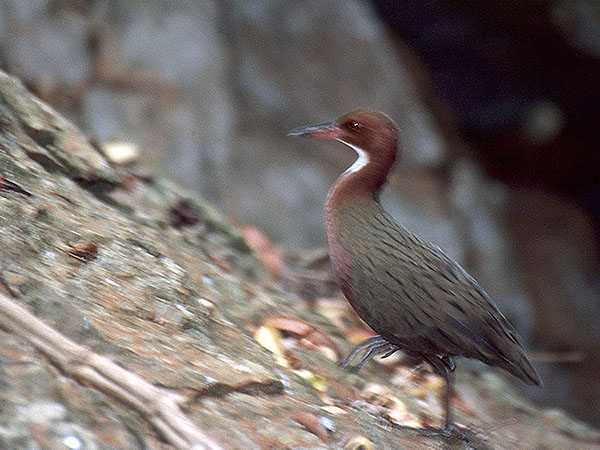
This species obviously is the source of several other flightless species and subspecies that are known to have existed on many of the islands around Madagascar, such forms are known from the islands of Mauritius and Réunion west of Madagascar and others from some of the atolls that belong to the Seychelles north of Madagascar, including the Aldabra atoll.
And the Aldabra atoll in fact is the only place where such a flightless form (subspecies or species if you want) still survives until today, this is the Aldabra Rail (Dryolimnas (cuvieri ssp.) aldabranus (Günther)).
***
Long time ago, some White-throated Rails for which reason ever, took a flight to the atoll to find it uninhabited (by rails) and decided to stay there … over time the rails that were born on this predator-free island stopped using their wings and their descendants again finally became completely flightless.
But then the Aldabra atoll just disappeared due to total inundation in the middle Pleistocene, about 340000 years before present, leading to the extinction of all endemic animals and plants, including this ‘First’ Aldabra Rails.
***
Then again, around 100000 years before present, the sea-level begun to sink and the Aldabra atoll reemerged.
Again, some White-throated Rails left their home island of Madagascar and took a flight to the north to find a new home on the now rail-free Aldabra atoll, and the story took the same direction as thousands of years before, and the final result are the recent endemic, flightless Aldabra Rails that one can see when visiting the atoll.
***
So, the Aldabra atoll was inhabited by two distinct lineages of flightless rails at two different times in history, respectively prehistory, that, despite both descenting from one and the same ancestor species, still represent two completely distinct forms, whether they are referred to as subspecies or as species.
*********************
References:
[1] Julian P. Hume; David Martill: Repeated evolution of flightlessness in dryolimnas rails (Aves: Rallidae) after extinction and recolonization on Aldabra. Zoolocigal Journal of the linnean Society 20: 1-7. 2019
*********************
edited: 10.05.2019
Cratoavis cearensis, an enantiornithiform bird from the lower Cretaceous of the extremely interesting Crato Formation in Brazil.
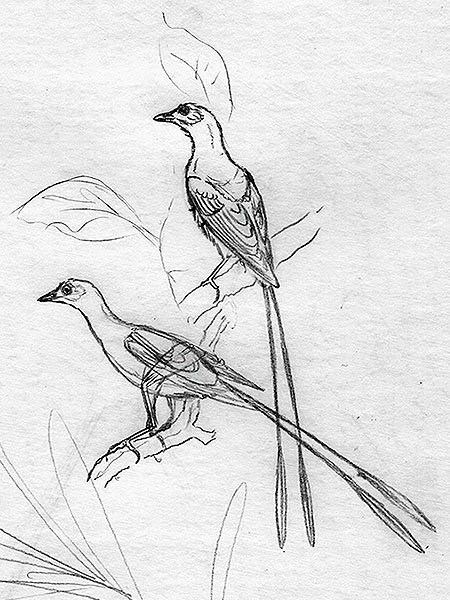
This bird is known from a single specimen that apparently was not fully grown, it was altogether only about 12 cm long (including the tail streamers)!
Yet, I have no idea how large it may have got when fully adult, who knows.
***
The Crato Formation is otherwise known for its numerous plant fossils, many of them angiosperms, so I cannot really decide yet which plant species may fit with this bird, but time will show ….
*********************
edited: 02.04.2019
Agnopteridae
Agnopterus hantoniensis Lydekker
Agnopterus laurillardi Milne-Edwards
Agnopterus turgaiensis Turgarinov
Palaelodidae
Adelalopus hoogbutseliensis Mayr & Smith
Megapaloelodus connectens Miller
Megapaloelodus goliath Milne-Edwards
Megapaloelodus opsigonus Brodkorb
Megapaloelodus peiranoi Agnolin
Palaelodus ambiguus Milne-Edwards
Palaelodus aotearoa Worthy et al.
Palaelodus crassipes Milne-Edwards
Palaelodus germanicus (Lambrecht)
Palaelodus gracilipes Milne-Edwards
Palaelodus kurochkini Zelenkov
Palaelodus minutus Milne-Edwards
Palaelodus pledgei Baird & Vickers-Rich
Palaelodus steinheimensis Fraas
Palaelodus wilsoni Baird & Vickers-Rich
Phoenicopteridae
Elornis anglicus Aymard
Elornis grandis Milne-Edwards
Elornis littoralis Milne-Edwards
Harrisonavis croizeti (Gervais)
Juncitarsus gracillimus Olson & Feduccia
Juncitarsus merkeli Peters
Leakeyornis aethiopicus (Harrison & Walker)
Phoeniconaias gracilis Miller
Phoeniconotius eyrensis Miller
Phoenicopterus copei Shufeldt
Phoenicopterus floridanus Brodkorb
Phoenicopterus minutus Howard
Phoenicopterus novaehollandiae Miller
Phoenicopterus siamensis Cheneval
Phoenicopterus stocki (Miller)
*********************
edited: 01.04.2019
Stephan F. K. Schaal; Krister T. Smith; Jörg Habersetzer: Messel – Ein fossiles Tropenökosystem. E. Schweizerbart’sche Verlagsbuchhandlung 2018
*********************
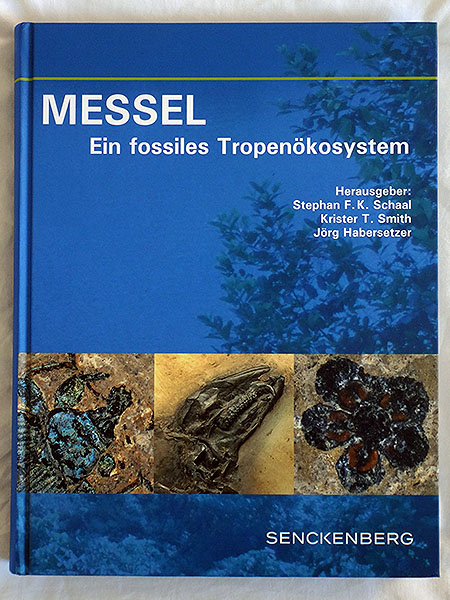
This is the latest summary of the current knowledge of the fossil fauna and flora of the Middle Eocene of Messel, Germany. You can actually get it in two versions, a German one and a English one.
The book indeed covers all of the mammal-, bird-, reptile-, amphibian-, and fish species, as well as probably only some of the insect species known at the date of publication, yet, and that is very annoying, contains only a very small ammount of plant species, which probably is because their fossils are not yet fully examined, who knows.
There are photos of all species covered, reconstructions of some of the mammals, but actually none of the birds, however, the book contains three murals (at least I think they are murals), which again show several of the Messel birds (however, without naming them), among them the famous Messel ‘rail’, unfortunately with a way too short tail and a fleshy comb on its head (I will get back to that some time ….).
All in all, the book can be recommended to all who are interested in Eocene biodiversity! 🙂
*********************
edited: 20.03.2019
I have some free days right now, actually I have five days holiday right now!
So I decided to draw a bit … which, of course, hasn’t been that much successful so far … however, here are two pieces that I have at least already sketched, two members of one of the most colorful bird families at all, the tanagers (Thraupidae).


*********************
edited: 20.03.2019
This species has only just been described – Creme-eyed Bulbul (Pycnonotus pseudosimplex Shakya et al.); it is one of the many cryptic species that have been previously overlooked.
The species appears to be more closely related to the Gray-fronted Bulbul (Pycnonotus cinereifrons(Tweeddale)) from the island of Palawan, Philippines than to the White-eyed Bulbul (Pycnonotus simplexLesson) with which it shares its habitat on the Indonesian island of Borneo and which it closely resembles. [1]
*********************
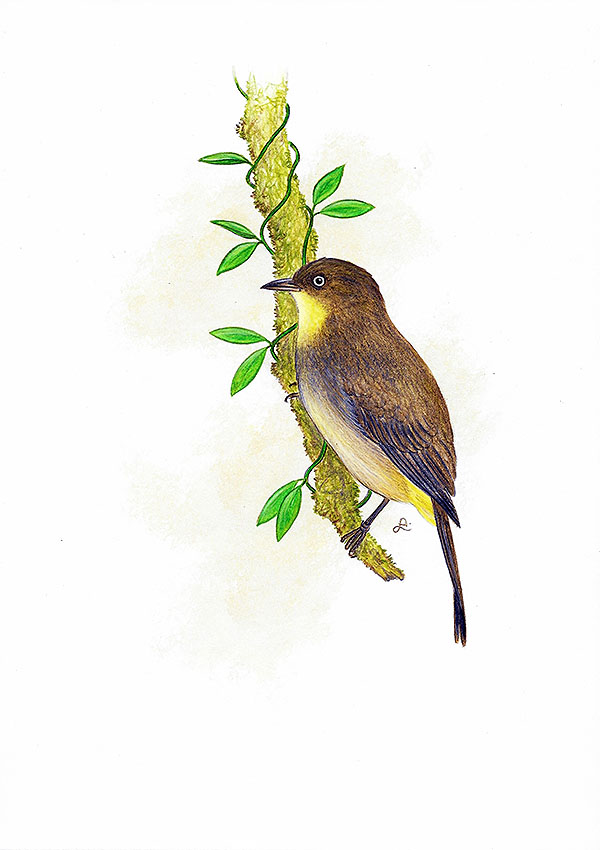
*********************
References:
[1] Subir B. Shakya, Haw Chuan Lim, Robert G. Moyle, Mustafa Abdul Rahman, Maklarin Lakim, Frederick H. Sheldon: A cryptic new species of bulbul from Borneo. Bulletin of the British Ornithologists’ Club 139(1): 46-55. 2019
*********************
bearbeitet: 20.07.2023
Lithornithidae
Calciavis grandei Nesbitt
Fissuravis weigelti Mayr
Lithornis celetius Houde
Lithornis hookeri (Harrison)
Lithornis nasi (Harrison)
Lithornis plebius Houde
Lithornis promiscuous Houde
Lithornis vulturinus Owen
Paracathartes howardae Harrison
Pseudocrypturus cercanaxius Houde
*********************
edited: 18.03.2019
Opisthodactylidae
Diogenornis fragilis de Alvarenga (?)
Opisthodactylus horacioperezi Agnolin & Chafrat
Opisthodactylus kirchneri Noriega et al.
Opisthodactylus patagonicus Ameghino
Rheidae
Heterorhea dabbeni Rovereto
Hinasuri nehuensis Tambussi
Rhea anchorenense (Ameghino & Rusconi)
Rhea fossilis Moreno & Mercerat
Rhea mesopotamica (Agnolín & Noriega)
Rhea subpampeana Moreno & Mercerat
*********************
edited: 16.03.2019
Ciconiidae
Ciconia gaudryi Lambrecht
Ciconia kahli Haarhoff
Ciconia louisebolesae Boles
Ciconia lucida Kurochkin
Ciconia maltha Miller
Ciconia minor Harrison
Ciconia nana (De Vis)
Ciconia sarmatica Grigorescu & Kessler
Ciconia sp. ‘Las Breas de San Felipe, Kuba’
Ciconia sp. 1 ‘Lee Creek Mine, USA’
Ciconia sp. 2 ‘Lee Creek Mine, USA’
Ciconia stehlini Jánossy
Eociconia sangequanensis Hou (?)
Leptoptilus arvernensis Milne-Edwards
Leptoptilos falconeri Milne-Edwards
Leptoptilos indicus (Harrison)
Leptoptilos lüi Zhang et al.
Leptoptilos patagonicus Noriega & Cladera
Leptoptilos pliocenicus Zubareva
Leptoptilos richae Harrison
Leptoptilos robustus Meijer & Awe Due
Leptoptilos siwalicensis Harrison
Leptoptilos sp. ‘Baringo District, Kenia’
Leptoptilos titan Wetmore
Mycteria milleri (Short)
Mycteria wetmorei Howard
Palaeoephippiorhynchus dietrichi Lambrecht
Palaeoephippiorhynchus edwardsi (Lydekker) [1]
Palaeopelargus nobilis De Vis
Pelargodes magna Milne-Edwards
Pelargopsis stehlini Gaillard
Pelargopsis trouessarti Gaillard
Pseudotantalus milneedwardsii Shufeldt
Tantalus breselensis Marmora
Xenorhynchopsis minor De Vis
Xenorhynchopsis tibialis De Vis
Xenerodiopidae (?)
Xenerodiops mycter Rasmussen
*********************
Quelle:
[1] Jiří Mlíkovský: Early Miocene birds of Djebel Zelten, Libya. Časopis Národního muzea, Řada přírodovědná 172(1-4): 14-120. 2003
*********************
bearbeitet: 24.04.2024
Familie incertae sedis
Eocuculus cherpinae Chandler
Cuculidae
Centropus antiquus Gervais
Centropus colossus Baird
Chambicuculus pusillus Mourer-Chauvire, Tabuce, Essid, Marivaux, Khayati, Vianey-Liaud & Ben Haj Ali
Cuculus csarnotanus Jánossy
Cuculus pannonicus Kessler
Cursoricoccyx geraldinae Martin & Megel
Geococcyx californianus ssp. conklingi Howard [1]
Neococcyx mccorquodalei Weigel
Thomasococcyx philohippus Steadman
*********************
Quellen:
[1] David W. Steadman; Joaquin Arroyo-Cabrales; Eileen Johnson; A. Fabiola Guzman: New information on the Late Pleistocene San Josecito Cave, Nuevo León, Mexico. The condor 96: 577-589. 1994
*********************
bearbeitet: 10.03.2019
Here we have the two species of finch-like passeriform birds that had been described at the beginning of this year, Eofringillirostrum boudreauxi and Eofringillirostrum parvulum, both from the Eocene, the first from North America, the second, smaller species from Europe.
***
Eofringillirostrum boudreauxi Mayr, Ksepka & Grande
This is the larger of the two known species, reaching about 10 cm in length, it also is the older one, having lived in the Early Eocene about 52 Million years ago in what today is Wyoming, USA.
This is what I call a pre-sketch, or a working sketch, it’s just the very first step in reconstructing a fossil bird, in which this particular species is drawn in a simple side-view, usually smaller than life-size.

Eofringillirostrum parvulum Mayr, Ksepka & Grande
This bird may have reached a length of only about 9 cm, it lived in the Middle Eocene of what today is the State of Hesse in Germany.
I sketched it together with a reconstructed infructescence of Volkeria messelensis Smith, Collinson et al., a plant from the family Cyperaceae that was growing around the Messel lake, and whose seeds may indeed have been eaten by this presumably seed-eating bird.
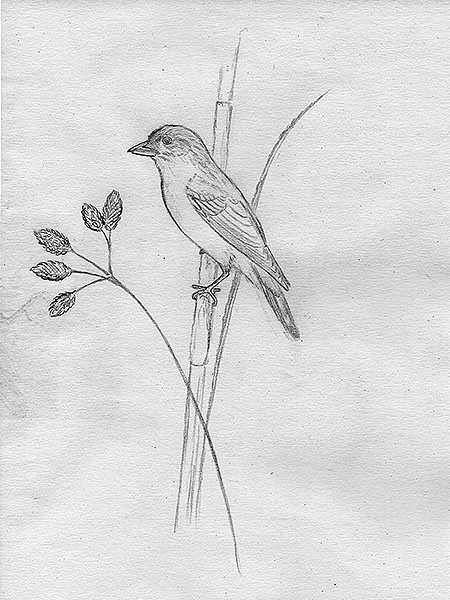
*********************
edited: 05-03.2019
Family incertae sedis
Botauroides parvus Shufeldt
Eocolius walkeri Dyke & Waterhouse
Palaeospiza bella Allen
Chascacocoliidae
Chascacocolius cacicirostris Mayr
Chascacocolius oscitans Houde & Olson
Selmeidae
Selmes absurdipes Peters
Sandcoleidae
Anneavis anneae Houde & Olson
Eobucco brodkorbi Feduccia & Martin
Eoglaucidium pallas Fischer
Eoglaucidium sp. ‘Messel, Germany’
Sandcoleidae gen. & sp. ‘Messel, Germany’
Sandcoleus copiosus Houde & Olson
Tsidiiyazhi abini Ksepka et al.
Uintornis lucaris Brodkorb
Uintornis marionae Feduccia & Martin
Coliidae
Celericolius acriala Ksepka & Clarke
Coliidae gen. & sp. ‘Hoogbutsel, Belgium’
Coliidae gen. & sp. ‘Moncucco Torinese, Italy’
Coliidae gen. & sp. ‘Grillental, Namibia’
Colius hendeyi Vickers-Rich & Haarhoff
Colius palustris (Milne-Edwards)
Limnatornis archiaci Milne-Edwards
Limnatornis consobrinus Milne-Edwards
Limnatornis paludicola Milne-Edwards
Masillacolius brevidactylus Mayr & Peters
Oligocolius brevitarsus Mayr
Oligocolius psittacocephalon Mayr
Primocolius minor Mourer-Chauviré
Primocolius sigei Mourer-Chauviré
*********************
edited: 05.03.2019
This species was described in 2018 based on a distal tarsometatarsal fragment and a distal fragment of a right tibiotarsus from the uppermost Early Miocene sediments of the Tagay locality on the island of Olkhon in Lake Baikal in Siberia, Russia.
The single known fragment is most similar to the corresponding bone of the recent Wallcreeper (Tichodromia muraria (L.)), yet still differs sufficiently enough to justify its placement into a distinct, new genus.
The bird reached the size of a recent Wallcreeper and, like that species, had the ability to climb vertical surfaces. [1]
*********************
References:
[1] N. V. Volkova; N. V. Zelenkov: A scansorial passerine bird (Passeriformes, Certhioidea) from the uppermost Lower Miocene of eastern Siberia. Paleontological Journal 52(1): 53-60. 2018
*********************
edited: 25.02.2019
Diese Art wurde 2008 beschrieben, so weit ich weiß anhand eines einzigen Knochens, eines vollständig erhaltenen rechten Tarsometatarsus, der immerhin der Überfamilie Certhioidea zugeordnet werden kann, nicht aber einer der rezenten Formen dieser Gruppe (Baumläufer, Mückenfänger, Zaunkönige)
Meiner Meinung nach ähnelt der einzige bekannte Knochen jedoch am ehesten dem entsrechenden Knochen eines Kleibers.
Der Vogel wird eine Gesamtgröße von etwa 15 cm erreicht haben, war also größer als die meisten Baumläufer und kleiner als ein durchschnittlicher Kleiber.
Es handelt sich hierbei tatsächlich um den (bis jetzt) ältesten bekannten echten Singvogel der in Europa gefunden wurde.
*********************
Referenzen:
[1] Albrecht Manegold: Earliest fossil record of the Certhioidea (treecreepers and allies) from the Early Miocene of Germany. Journal of Ornithology 149(2): 223-228. 2008
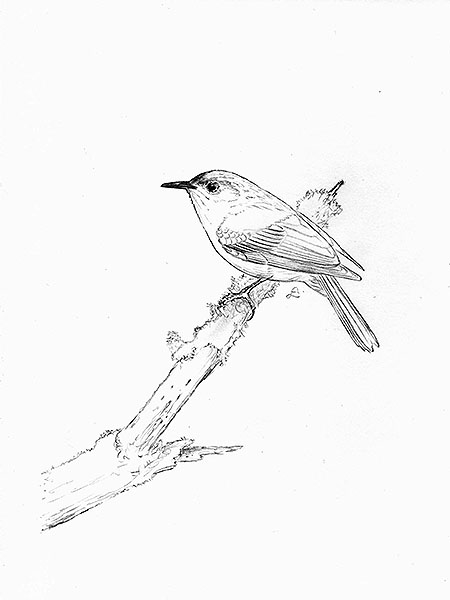
*********************
bearbeitet: 25.02.2019
… just some sketching, Hassiavis laticauda, a member of the Archaeotrogonidae, an extinct family that possibly belonged to the Caprimulgiformes or was closely related to that order.

*********************
edited: 20.02.2019
Ich präsentiere: eine Skizze des Antarktischen Konflikt(vogel)s (Conflicto antarcticus ), einen stem-anseriformen Vogel aus dem unteren Paläozän der Antarktis.
*********************
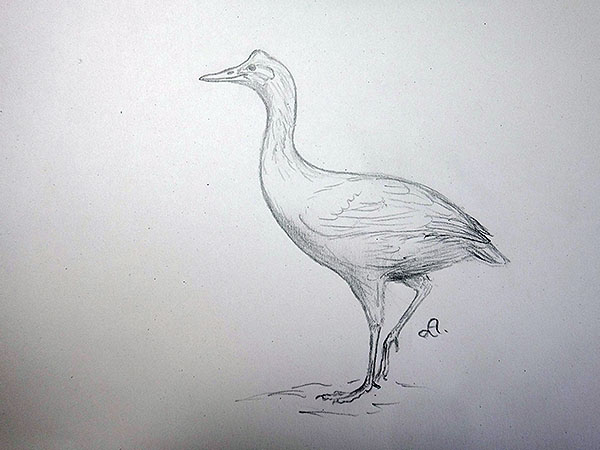
*********************
bearbeitet: 19.02.2019
Pumiliornis means as much as “dwarf bird”, and with that, all has been said.
***
No, not so fast ….
The genus/species was described in 1999 and is, to my knowledge, so far known from three skeletal finds, of which one even contains the remains of its last meal, namely pollen.
All in all, Pumiliornis tessellatus resembled today’s sunbirds (Nectariniidae) or the sunbird-asitys (Eurylaimidae) in being very small and having an elongated beak. Its beak, however, was quite unlike those of the members of the beforementioned two families, it resembled the beak of a plover (Charadriidae), especially its narial opening (nose hole), which was rather slit-like and not round.
Pumiliornis was apparently a flower-visitor that fed on nectar and pollen (as is known from the content of the gut of one specimen), however, it may not have been specialized to that diet and may also have taken insects and other small invertebrates.

The bird was small, very small, in my reconstruction it reaches a length of only 7,5 cm, this size, however, is of course depending on the length of its tail feathers, which unfortunately are not preserved in any of the known specimens. I’ve reconstructed the bird with a rather short tail, which may some day turn out to be completely wrong, who knows.
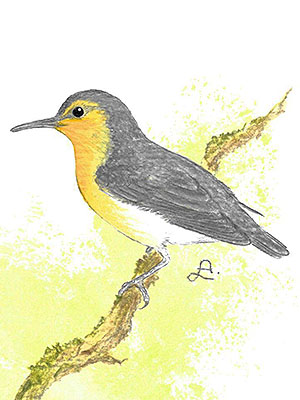
The feet corresponded to the typical scheme of recent passerine birds, i.e. they have three toes pointed forward and one towards the back. However, the feet appear to have been facultative or semi-zygodactyl, which in turn means, in simple terms, the first toe usually pointed forwards, but could be held backward when needed.
***
The genus/species originally could not be assigned to any living bird family, not even an order, but is now known to belong to the extended Passeriformes-orbit, which in addition to the passerine birds also includes the falcons (Falconiformes) and the parrots (Psittaciformes). It is now known to have been a member of the extinct family Psittacopedidae Morsoravidae, that apparently also contains other unusual genera like Morsoravis, Psittacopes and the recently described, very interesting Eofringillirostrum and probably others too.
***
Finally, it should be mentioned that this bird was not a dwarf spoonbill, as claimed by a certain person. 😉
*********************
References:
[1] Gerald Mayr: Pumiliornis tessellatus n. gen. n. sp., a new enigmatic bird from the Middle Eocene of Grube Messel (Hessen, Germany). Courier Forschungsinstitut Senckenberg. 216: 75-83. 1999
[2] Daniel T. Ksepka; Lance Grande; Gerald Mayr: Oldest finch-beaked birds reveal parallel ecological radiations in the earliest evolution of Passerines. Current Biology 29: 1-7. 2019
*********************
edited: 08.02.2019
Errol Fuller: The Lost Birds of Paradise. Airlife 1996
*********************
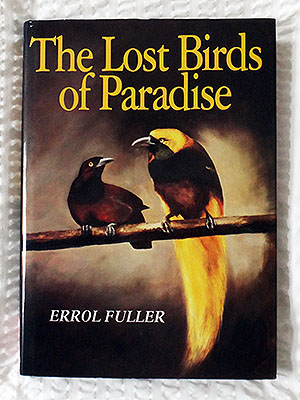
Dieses etwas in die Jahre gekommene Buch hat sicher nichtsdestotrotz nichts von seiner Aktualität verloren, auch wenn sein Titel etwas irreführend ist, etwas.
Es geht um Hybriden innerhalb der Familie der Paradiesvögel (Paradisaeidae), welche, zumindest in einigen Fällen, aber eventuell gar keine Hybriden sondern tatsächlich verlorene Arten darstellen mögen – ‘verloren’ weil die meisten davon nur von wirklich sehr wenigen Exemplaren bekannt sind, die im vergangenen Jahrhundert für die Modeindustrie gesammelt wurden und die eventuell heute ausgestorbene Formen darstellen könnten.
Man erfährt viel über die Geschichte der ornithologischen Sammlungen einiger der bekanntesten Museen der Welt, über die Arbeit der Ornithologen vergangener Jahrhunderte und, wahrscheinlich am wichtigsten, über die sich scheinbar nie ändernde gehorsame Angewohnheit, Aussagen sogenannter Experten niemals in Frage zu stellen, weil angenommen wird, dass sie einfach nicht falsch sein können (alle seltenen Formen wurden vor fast 100 Jahren zu Hybriden erklärt – und dies wurde offensichtlich erst in heutiger Zeit in Frage gestellt, obwohl einige Fälle tatsächlich fraglich sind).
Jede einzelne ‘verlorene’ Form wird mit mindestens einer zeitgenössischen oder modernen Darstellung abgebildet, hier und da findet sich sogar ein Foto eines Museumsexemplars.
Ein Buch, das durchaus empfohlen werden kann. 🙂
*********************
bearbeitet: 02.02.2019
… terrible to draw, especially if you indeed consider drawing them in life-size minus 1 cm as I always do.
This is supposed to be a Escudo Hummingbird (Amazilia tzacatl ssp. handleyi Wetmore), which is endemic to the Isla Escudo de Veraguas off north western Panama, and which is identical to its nominate subspecies except for being very much larger.
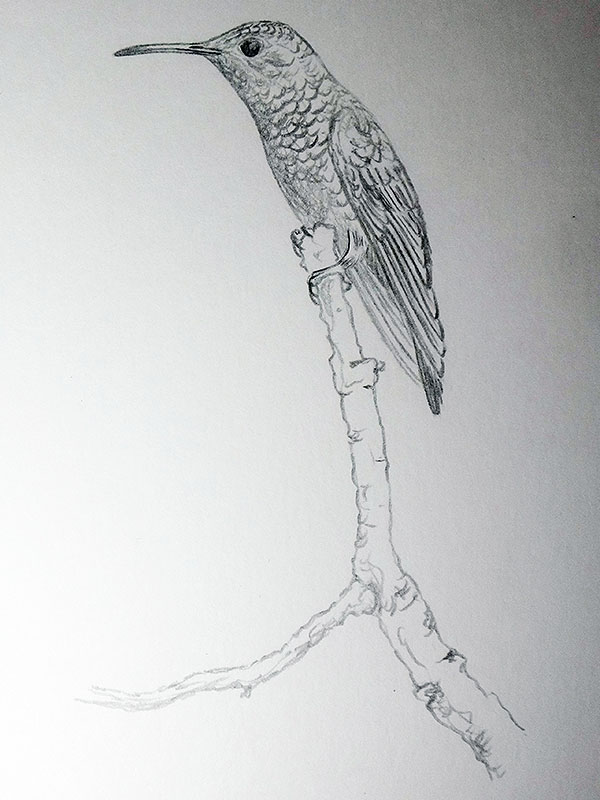
*********************
edited: 02.02.2019
Der Hezheng-Fasan wurde im Jahr 2018 beschrieben, er war sehr nah mit den heutigen Fasanen verwandt.
Das einzige bisher bekannte Fossil ist bemerkenswert da bei ihm die Trochlea erhalten geblieben ist, was darauf hindeutet, dass der Vogel zu Lebzeiten recht stimmgewaltig gewesen sein muss (ganz wie heutige Fasanenarten).
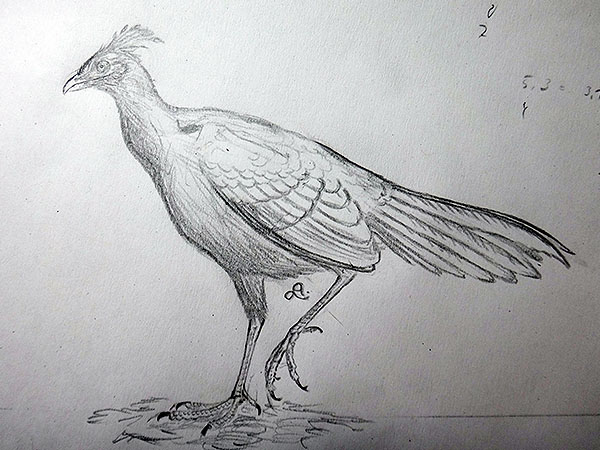
*********************
Referenzen:
[1] Zhiheng Li; Julia A. Clarke; Chad M. Eliason; Thomas A. Stidham; Tao Deng & Zhonghe Zhou: Vocal specialization through tracheal elongation in an extinct Miocene pheasant from China. Scientific Reports 8(1): 1-12. 2018
*********************
bearbeiten: 02.02.2019
William T. Cooper: Capturing the Essence: Techniques for Bird Artists. Yale University Press 2011
William T. Cooper, der leider 2015 verstorben ist, war einer von wenigen wirklich überdurchschnittlich begabten Künstlern. Er hat hauptsächlich australische Vögel gemalt und hat auch sehr viele Bücher illustriert. Seine Bilder zeigen die Vögel sehr, sehr lebensecht, mit kräftigen Farben und meist umgeben von echten Pflanzen usw. mit tatsächlich existierenden Landschaften im Hintergrund.
Ich habe dieses Buch als Geburtstags-/Weihnachtsgeschenk bekommen. 🙂
In diesem Buch gibt der Künstler einen Einblick in sein Werk, seine Art zu malen aber auch einige Hinweise in Bezug auf anatomische Besonderheiten bestimmter Vogelgruppen; ich denke, es ist immer sehr informativ zu sehen, wie jemand anderes etwas tut was ich liebe – malen.
Ich kann dieses Buch nur empfehlen, auch wenn es gern etwas dicker ausfallen hätte können. 😉
*********************
bearbeitet: 05.01.2019
David Attenborough; Errol Fuller: Drawn From Paradise: The Discovery, Art and Natural History of the Birds of Paradise. HarperCollins Publishers 2012

Dies ist ein weiteres Buch, das ich als Geburtstags-/Weihnachtsgeschenk bekommen habe – und ich weiß gar nicht wo ich anfangen soll ….
Es ist wohl eines der fantastischsten Bücher, das ich je gelesen habe, es geht um die Familie der Paradiesvögel (Paradisaeidae) aber auch um die Geschichte der Ornithologie und nicht zuletzt, die Geschichte der Ornithologischen Kunst – all dies zusammen.
Wer sich für so genannte antike Vogeldarstellungen oder -drucke interessiert, kennt definitiv die Werke so bekannter Künstler wie Jaques Barraband, John Gerrard Keulemans usw. Viele von ihnen malten auch Paradiesvögel, ohne jedoch tatsächlich jemals einen lebend gesehen zu haben … geschweige denn in vollem Balzgefieder! Diese Künstler nutzten ihre reiche Vorstellungskraft, um diese oft äußerst spektakulären Vögel mit all ihren seltsamen und übergroßen Federn in den fantastischsten und futuristischsten Posen darzustellen – und doch nur um von der Realität bei weitem überboten zu werden.
Ich kann dieses Buch allen, die sich für Ornithologische Kunst, für Paradiesvögel oder einfach auch nur für schöne Bilder begeistern, nur wärmstens empfehlen, es lohnt sich!
*********************
bearbeitet: 05.01.2019
Well, it seems that I finish this whole Rapa Nui project already in December 2018 ….
***
Anyway, let’s just begin with the first one (or two?) of the endemic landbird species that once inhabited Easter Island.
There were two parrots once …:
“Parrots are represented by a partial quadrate of a very large species (larger than in Nestor, Prosopeia, Eclectus, or any lorikeet; dissimilar from that in neotropical parrots) and digit I, phalanx 2 of the wing (larger than in Vini or Cyanoramphus, smaller than in Nestor or Eclectus; ca. the size in Prosopeia).” [1]
***
So far so fine, but my gut feeling almost screams: “ONE!!!” What if this was a very large species, something like a Rapa Nui equivalent of the New Zealand Kakapo (Strigops habroptila Gray), a big, small-winged and flightless ground-dwelling parrot that inhabited the dense forests of the island, now long gone, searching for fallen fruits of the likewise extinct Rapa Nui Palm (Paschalococos disperta (J. Dransf.)).
The Rapa Nui Parrot may still have been able to climb smaller trees with the help of its typical parrot beak and its feet, and it certainly was a curious and tame bird and was easily killed off by the first Polynesian discoverers of the island.
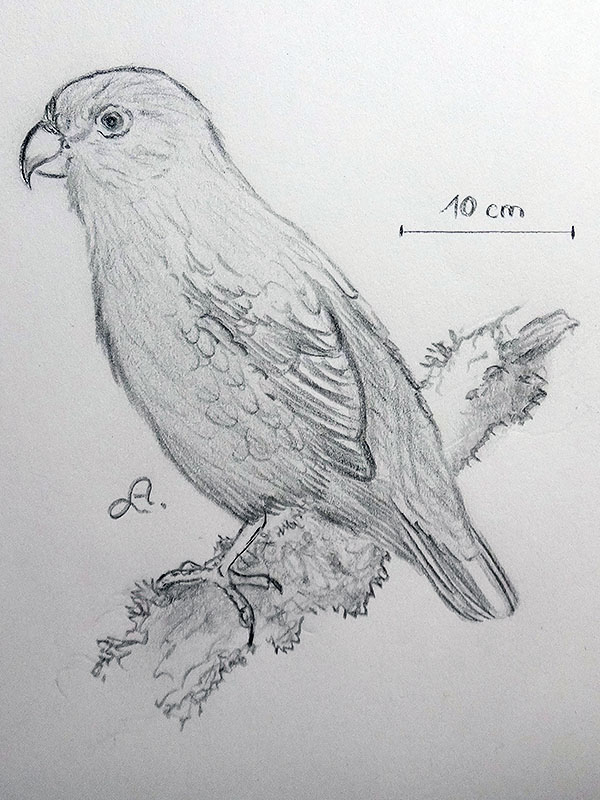
*********************
References:
[1] David W. Steadman: Extinction and Biogeography of Tropical Pacific Birds. University of Chicago Press 2006
*********************
edited: 10.12.2018
Daniel Lewis: Belonging on an Island. Yale University Press 2018
*********************

It took me about six months to finish reading this book, its content is just too frustrating sometimes.
The book is divided into four chapters, each is build around a special species of bird, the first around a bird that was extirpated in (pre)historic or rather pre-European times, the second around a bird extinct in recent times, the third around a bird that is nearly extinct, and the fourth around a bird that was recently introduced to the Hawaiian Islands.
When you have read about endemic Hawaiian birds before you came along a lot of names of persons involved with them that you will find again here in this book, and the four chapters are more or less about these people: those who discovered subfossil bones, those who collected and described Hawaiian birds, those who are or were involved in their protection and so on.
It’s just almost unbearable to read about the ‘Hui Manu’ Society and other such ‘clubs’ of bored housewives of rich businessmen of American and European origin that were convinced that the Hawaiian Islands would need more colorful and songful birds, because the native ones had just disappeared or were about to do so.
… on the other hand, the endemic Hawaiian Crow was seen as a pest, it was just not colorful enough and its song not pleasant enough.
It’s quite interesting to read all of that, all the different points of view by all the different people that now call these islands their home, but it is also sad, for example to read about the discovery of the ‘O’o’a’a and it’s extinction, it’s rediscovery, it’s next extinction, it’s re-rediscovery, and it’s final extinction … or may it be re-re-rediscovered some day? No,definitely not.
I can recommend this book, it is not about the birds themselves but about everything else surrounding them.
*********************
edited: 08.12.2018
Well, I have a lot of pictures in my head, but when I try to get them onto paper … well.
Rapa Nui about 2000 BCE.:
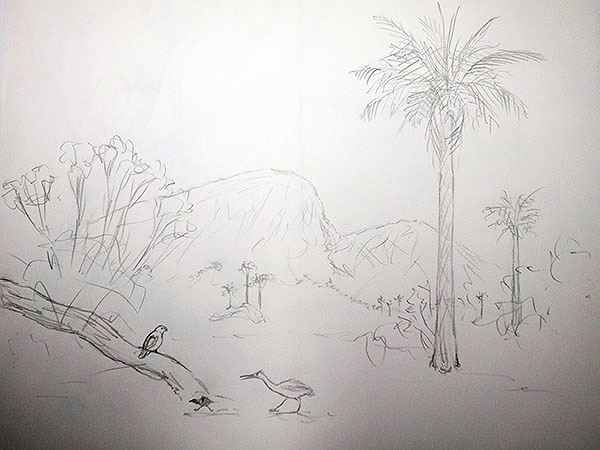
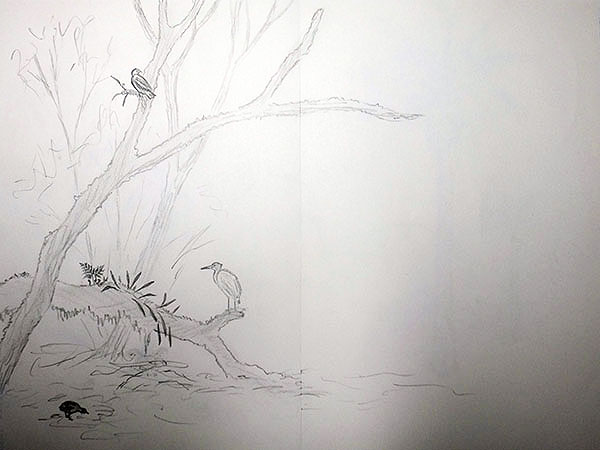
*********************
edited: 09.12.2018
When James Richard Hill MacFarlane [unfortunately I could not find out who that actually was] stayed on Easter Island in February 1884, he made the following statement, which, however, appears to be very reliable after all.:
„The only birds I saw in the crater [Rano Kao] were three ruddy-coloured Geese, but I was unable to get anywhere near them.“ [1]
There were at least three geese on the island, straying around in the crater of the extinct Rano Kao volcano, but what can we make of this observation?
***
Well, given the date of this observation, 1884, these geese certainly were not an endemic species now lost, but given the recorded color they may also not have been feral geese, which are always either gray or white or mottled gray and white.
The authors of the most recent listing of native and introduced birds found on Rapa Nui, Manuel Marin and Pablo Caceres, think that what Mr. McFarlane saw may have been female Upland Geese (Chloephaga picta (Gmelin)), a species that inhabits southern South America and that either may have stranded on the island after they lost their route during a flight or, probably more likely, were imported to the island by humans. [2]
***
I will possibly post more interesting [I hope it is] stuff about this very, very isolated island in 2019.
*********************
References:
[1] J. R. H. MacFarlane: Notes on birds in the western Pacific, made in H. M. S. ‚Constance‘, 1883-5. Ibis 5(5): 201-215. 1887
[2] Manuel Marin; Pablo Caceres: Sobre las aves de Isla de Pascua. Boletín del Museo Nacional de Historia Natural, Chile 59: 75-95. 2010
*********************
edited: 08.12.2018
A new paper, that was just published [1], deals with the subfossil remains that had been excavated on the Gambier Islands, far, far in the almost easternmost corner of Polynesia, more easterly are only the Pitcairn Islands and the well known island of Rapa Nui.
The Gambier Islands, for those who don’t know them, are basically a more or less sunken atoll, a so called ‚almost atoll‘ like the better known Aitutaki atoll in the Cook Islands. This ‚almost atoll‘ consists of a larger but still relatively small main island, Mangareva, and several other smaller islets surounding it, all of them of volcanic origin and merely the meager remains of a former large volcano. The whole group of islands is encircled by a fringe of coral islands, which again are formed by lifted coral reefs. There are some other real atolls (only coral islands without remains of former volcanoes) that belong to the Gambier group, these are Maria (East), Marutea (South), Matureivavao, Morane, Temoe, Tenararo, Tenarunga, and Vahanga.
***
The authors describe one new species, a pigeon, and mention several others, mostly pigeons and of course seabirds, we are on a island group here after all. 😛
***
The first surprise is Bountyphaps, very likely the same Bountyphaps obsoleta Worthy & Wragg that was originally described from Henderson Island, Pitcairn Islands. Its remains were found on Kamaka Island, one of the numerous small or very small islands within the group. The remains are interpreted as probably having been transported from the Pitcairn Islands to the Gambiers by Polynesian settlers, which indeed are known to have captured and tamed parrots and pigeons, at least in olden times when there still were parrots and pigeons.
The next bird is a newly described pigeon species, Ducula tihonireasini Rigal, Kirch & Worthy, its remains were found on Taravai Island, the second largest of the islands in the group, and it probably was endemic to the Gambier Islands.
Then there are a Ptilinopus sp. which may be identical to the Atoll Fruit-Dove (Ptilinopus coralensis Peale), and a Columbidae gen. & sp., probably Macropygia sp., which would extend the distributional area of that genus far to the east and to the south.
There are of course remains of the Pacific Reef Egret (Egretta sacra ssp. sacra (Gmelin)), the most common land bird in whole Polynesia today.
And off we go to the seabirds, here we have the remains of Red- and White-tailed Tropicbirds, a rather small Pseudobulweria sp., apparently also a new species, three unspecified Pterodroma spp., three Puffinus spp., the Wedge-tailed Shearwater, the Polynesian Storm-Petrel, the Great- and the Lesser Frigatebird, the White Tern, and finally another tern, probably the Blue Noddy.
***
Most of these birds are known to have occurred on the Gambier Islands at least since 2005 when their first remains were found (except for Bountyphaps obsoleta, whose remains were wrongly assigned to another pigeon species, Alopecoenas nui (Steadman)). But only now their subfossil bones were scientifically investigated.
*********************
References:
[1] Stanislas Rigal; Patrick V. Kirch; Trevor H. Worthy: New prehistoric avifaunas from the Gambier Group, French Polynesia. Palaeontologia Electronica 21.3.4A 1-35. 2018
*********************
edited: 07.12.2018
This is my blog and so I will now talk about myself right now!
Attention: I made a discovery, yesterday evening I found a drawing of a bird that I did not know.
Because it was supposed to be a rail I could just say that this is a species that does not exist (either any longer or at all), because I simply know every rail species (they are amongst my closest favorite birds, so I indeed know all of them quite well), may it be extant or extinct.
I had also never ever heard of the artist before, so probably haven’t you, who ever is reading this article right now. 🙂
Enough about me ….
***
Pieter Cornelius de Bevere (1721-1781) is an almost unknown artist who lived on the island of Sri Lanka and who produced many drawings of birds (and other stuff), several of them in a distinct way of being dead and lying belly-up on a tree trunk.
The artist created the drawings for the likewise almost unknwon “Loten collection of coloured drawings of birds, mammals, insects & plants” from the years 1754 to 1757. This work apparently contains almost exclusively drawings of species from Sri Lanka
There is a single drawing that shows a bird that appears to be completely unknown, a rail, apparently from the island of Sri Lanka as all the other species in the work.
The bird appears to have a rather fluffy plumage, typical of rails, the typical rail-like long and strong legs and feet, a typical beak and so on, it has no visible wings, so may even have been flightless – it is clearly a rail, yet, which one?
Even if we take all the known rail species worldwide into account there is none that looks like this one.
Now one could easily think that Pieter Cornelius de Bevere was just a bad artist, who drew unrecognizable things, but this is just not the case here – he was a rather well-skilled artist, and all his bird drawings can very easily be recognized and assigned to certain species.
With this one exception! And that leads me to the conclution that he painted some rail species that obviously once inhabited the island of Sri Lanka, at least until the middle of the 18th century.
The bird was identified as Eastern Water Rail (Rallus aquaticus ssp. indicus Blyth), now recognized as a full species, however bears absolutely no similarities with that species, and the bird depicted does definitely not belong in that genus at all. [1]
Bevere’s Rail is now either extinct or just has never been recognized as being something somewhat distinct (actually very distinct) from all known rail species, and thus may even be still alive and hiding somewhere on Sri Lanka, awaiting its discovery and description.
*********************
[1] Alexander J. P. Raat: The Life of Governor Joan Gideon Loten (1710-1789): A personal history of a Dutch virtuoso. Hilversum Verloren 2010
*********************

*********************
A little update here.:
It appears that this enigmatic bird isn’t that enigmatic after all, it may in fact turn out to be an immature White-breasted Waterhen (Amaurornis phoenicurus Pennant), and look what I just found, a depiction of an adult one that looks very familiar, doesn’t it?
*********************

*********************
edited: 24.11.2018
This is another of the enigmatic birds that were described and depicted by François Le Vaillant at the very beginning of the 19th century.
The bird is supposed to originate from South Africa, and it appears to be known from at least five actual specimens, three males and two females, that were collected (hunted and killed) by François Le Vaillant himself.
„Cjet oiseau qu’on reconnoîtra facilement à tous ses caractères pour appartenir au genre coucal, habite le pays des Caffres et ne fréquente que les grandes forêts. Il se perche sur les branches basses des arbres, d’où le mâle fait entendre d’une voix plaintive les deux syllabes côoo-ro répétées jusqu’à dix fois de suite, et toujours sur le même ton. On le trouve presque toujours avec sa femelle. Celle-ci, comme toutes les femelles d’oiseaux chanteurs, ne chante pas non plus; mais elle a un cri précipité cri-cri-cri-cri’, qui a beaucoup de rapport avec celui que fait notre émérillon lorsqu’il plane dans les airs , et qui paroît être le cri d’appel, car le mâle le faisoit aussi lorsqu’il vouloit avoir sa femelle auprès de lui, comme lorsqu’il paroissoit craindre de se trouver dans quelque danger: toutes les fois du moins qu’il s’appercevoit que j’essayois de l’ap- procher, il se tenoit sur ses gardes, et il répétoit ce même cri jusqu’à ce que j’eusse disparu à ses yeux, et que sa fe- melle l’eût rejoint. C’est aussi dans un creux d’arbre que le Coucal nègre fait sa nichée. La femelle pond quatre œufs d’un blanc de craie, et que le mâle et elle couvent tour-à-tour.“
Translation:
„This bird, which is easily recognized by all its characters to belong to the coucal genus [Centropus], inhabits the country of the Caffres and frequents only the great forests. It perches on the lower branches of the trees, whence the male utters in a plaintive voice the two syllables of the same color, repeated ten times afterwards, and always on the head. One finds himself almost always with his female. The latter, like all the females of birds of prey, do not excite more; but that is a precipitate cree-cree-cree-cree, which has much to do with that which our merlin [Falco columbarius] does when it hovers in the air, and which appears to be the cry of appeal, for the male also did it when he wished to have his female near him, as when he appeared to be afraid of finding himself in some danger: whenever he perceived that I was trying to approach him, he was on his guard, and he repeated the same cry until I had disappeared from his eyes, and his wife had rejoined him. It is also in a hollow of tree that the Negro Coucal makes its brood. The female lays four eggs in a chalk white, and the male and she hatch in turn.“
***
The description tells us that this bird was completely black.:
„Le Coucal nègre a le corps de la grosseur de celui de notre grive draine. Sa queue légèrement étagée, est de la longueur de tout son corps, y compris la tête et le cou. Le bec, les pieds et tout le plumage de cet oiseau sont d’un noir mat, sans teinte d’aucune autre couleur absolument. Les yeux sont marron foncé. La femelle est un peu plus petite que le mâle, et son noir brunit un peu sur le ventre.“
Translation:
„The Negro Coucal has the body of the size of that of our mistle thrush [Turdus viscivorus]. His slightly stepped tail, is the length of his whole body, including the head and neck. The beak, the feet and all the plumage of this bird are of a matt black, without shade of any other color absolutely. The eyes are dark brown. The female is a little smaller than the male, and her black browns a little on the belly.“
There are indeed some all-black or more or less completely black coucal species known to exist, these are the Black-billed Coucal (Centropus bernsteini), the Biak Coucal (Centropus chalybeus), the Green-billed Coucal (Centropus chlororhynchus), the Ivory-billed Coucal (Centropus menbecki), the Kei Coucal (Centropus spilopterus), the Black-hooded Coucal (Centropus steerii), the Violaceous Coucal (Centropus violaceus), and a subspecies of the Philippine Coucal (Centropus viridis ssp. mindorensis), yet none of them inhabits Africa.
***
The last part oft he original text tells us a bit about the habits and the food oft hat birds.:
„Je n’ai tué que cinq individus de l’espèce, trois mâles et deux femelles: je n’en ai pas vu les jeunes, les petits n’étant pas encore éclos lorsque je quittai le canton où j’ai trouvé l’espèce. A la dissection, je n’ai trouvé que des débris d’insectes dans le corps de ces oiseaux.“
Translation:
„I killed only five individuals of the species, three males and two females: I did not see the young, the young ones not having hatched yet when I left the canton where I found the species. At the dissection, I found only debris of insects in the bodies of these birds.“
So, obviously the author found the birds by himself in the named place, at least five specimens were taken (where are they today?), so this Black Coucal very likely actually existed, but what is/was it? A now extinct species, a subspecies of another species, a color morph?
We may never find out.
*********************
[1] François Le Vaillant: Histoire naturelle des oiseaux d’Afrique. Paris, Delachaussée, Rue du temple, N°. 40. Vol. 5. 1806
*********************
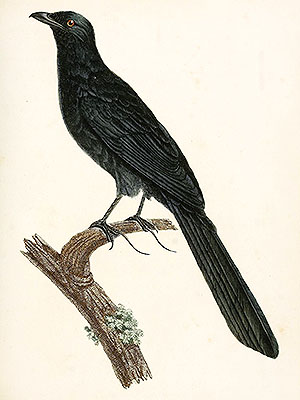
*********************
edited: 11.11.2018
… some thoughts about my favorite parrot genus – Cyanoramphus, I think about them very often …. 😉
***
„28.* Cyanoramphus erythronotus.
…
Society Is.: Tahiti and Raiatea (Forster)“ [1]
and
„30.* Cyanoramphus ulietanus.
…
?Ulietea or Raiatea, Society Islands (Lath.). – ?Tanna, New Hebrides (Bullock Coll. Brit. Mus.).
If the Parrot, P. ulieteanns Gm., really came from Ulietea as stated by Latham, it may prove to be the young of P. pacificus Forst. = erythronotus Kuhl.“ [1]
***
Number 28., the Black-fronted- or Tahiti-Parakeet is now named as Cyanoramphus zealandicus (Latham), what if the two species, the black-fronted and the Society Islands Parakeet, where indeed only one species?
The Black-fronted Parakeet appears to be very much like the remainder of the Cyanoramphus species, more or less completely green, with bluish wing feathers, and some red feathers behind the eye, but the other species, the Society Islands Parakeet, has a completely different coloration, being brownish olive-colored with a completely blackish head, it is completely unlike any of ist congeners.
The dull form may indeed have been the juvenile of the green one, yet all other species in the genus lack a special juvenile plumage, the young birds look exactly like the adult ones, and the only two known specimens of the Society Islands Parakeet appear to be adult birds – so no, this theory is invalid.
***
The origin of the two species is another question, it is not that much for certain, that in historical times one was found only on the island of Tahiti and the other one only on Ra’iatea, let alone the prehistorical times …! The only thing absolutely for sure is that the Black-fronted Parakeet indeed inhabited Tahiti.
Can you still follow me?
The genus is very rich in species in New Zealand and occurs there almost everywhere with at least two sympatrical species, and even as much as three on the large South Island (Yellow-fronted Parakeet (Cyanoramphus auriceps), Orange-fronted Parakeet (Cyanoramphus malherbi), Red-fronted Parakeet (Cyanoramphus novaezealandiae)).
So why should the island of Tahiti not have harbored two species as well? And why should these two species not have occurred on other islands within the Society archipelago as well? We will probably never know that for sure.
***
There are still so many mysteries surrounding this genus, one is the very disjunct distribution, with giant gaps of which one was only recently filled with the discovery of subfossil remains on the island of Rapa, Austral archipelago.
But this is another story for another day. 🙂
*********************
References:
[1] Lionel K. Wiglesworth: Aves polynesiae: a catalogue of the birds of the Polynesian subregion (not including the Sandwich Islands). Berlin: R. Friedlaender & Sohn 1891 In: Abhandlungen und Berichte des Königl. Zoologischen und Anthropologisch-Etnographischen Museums zu Dresden Bd. 3: 1-84. 1890/91. herausgegeben von Hofrath Dr. A. B. Meyer, Director des Museums
*********************
edited: 24.10.2018
When C. Jouanin and P. Paulian surveyed beds of subfossil bones on Île Amsterdam in the subantarctic Indian Ocean in 1960, they found almost only bones of seabirds, but also some bones of what later was described as the Amsterdam Island Duck (Anas marecula Olson & Jouventin) – and – the mummified body of a middle-sized rail.
The two just wrote some kind of short note [1], that later, in 1977, was translated by Storrs L. Olson.:
„A mummy of a small rail was discovered in a tunnel in a lava flow, under a block that had no doubt protected it from moisture. A sketch was made in situ, as well as taking measurements of the beak (22 mm), the tarsus (40) and the middle toe without claw (34), but the mummy fell to dust when an attempt was made to pick it up. In this case one cannot infer the former existence of a rail peculiar to New Amsterdam, although it would be perfectly likely (endemic species of this order exist on most isolated islands), for the measurements cited coincide with those of a skin of a Corncrake (Crex crex Linnaeus) in the British Museum collected 100 miles to the south of Madagascar. Still, this identification is not wholly satisfactory: the mummy did not have the bulk nor the heavy bill of a Corncrake, and it is most regrettable not to have been able to remove it.“ [2]
The Amsterdam Island Rail very, very, very likely, if not absolutely definitely, was an endemic species, that indeed may have descended from the trampy Corncrake, a species that inhabits parts of western Asia and Europe, but on its migrations, pops up almost everywhere on Earth!
***
Imagine how many such endemic rails may have existed before mankind spread all over the planet, it must have been thousands …!
*********************
References:
[1] C. Jouanin; P. Paulian: Recherche das ossements d’oiseaux provenant de l’île Nouvelle-Amsterdam (Océan Indien). Proceedings of the XIIth International Ornithological Congress, Helsinki: 368-372. 1960
[2] Storrs L. Olson: A synopsis of the fossil Rallidae. In: Sidney Dillon Ripley: Rails of the World – A Monograph of the family Rallidae. Codline. Boston 1977
*********************
edited: 15.10.2018
I just found an interesting little side note in ‘Aves polynesiae: a catalog of the birds of the Polynesian subregion (not including the Sandwich Islands)’ from the 19th century in which the South Sea Sandpiper (Prosobonia cancellata Peale / parvirostris J. F. Gmelin) under the name Phegornis cancellatus is listed for an island called Hervey Island (now the Manuae Atoll in the north of the Cook Islands). [1]
Is that just a mistake or does this little side note refer to a last surviving population of the unnamed Prosobonia species known only from subfossil remains, the remains of which have been found on Mangaia Island in the south of the Cook Islands?
***
I wish I had more time for all this research, but unfortunately, I have to work to live (… actually more work than life at the moment …).
*********************
References:
[1] Lionel K. Wiglesworth: Aves polynesiae: a catalogue of the birds of the Polynesian subregion (not including the Sandwich Islands). Berlin: R. Friedlaender & Sohn 1891 In: Abhandlungen und Berichte des Königl. Zoologischen und Anthropologisch-Etnographischen Museums zu Dresden Bd. 3: 1-84. 1890/91. herausgegeben von Hofrath Dr. A. B. Meyer, Director des Museums
*********************
edited: 10.10.2018
Saint Paul Duck (Anas sp. ‚Île Saint-Paul‘)
While describing a new extinct bird, the Amsterdam Island Wigeon (Anas marecula) in 1996, the two authors Storrs L. Olson and Pierre Jouventin mentioned an account from the middle of the 18th century, and quoted another author, W. R. P. Bourne.:
„Of far greater interest, however, is the report of the explorer John Barrow, who was on St. Paul Island on 2 February 1793, where he mentioned the presence of „a small brown duck, not much larger than a thrush“ that was „the favorite food of the five sealers living on the island“ (quotes brom Bourne et al. 1983).“ [2][3]
To me, it seems, the two authors did not actually check the original source, John Barrow, here.
Well, but I did …! 😉
***
By the way; another well-known author of bird/extinction-related books, Julian P. Hume (in Extinct Birds; in the 2012 – or in the 2017 edition), even gives a completely wrong source.:
„John Barrow: Some Account of the Public Life, and a Selection from the Unpublished Writings, of the Earl of Macartney. Amsterdam London: T. Cadell and W. Davies. 1806“
I checked that source too! 😉
***
But back to the actual source, what does it really say?
Page 140:
„On the 1st of February we discovered the two islands of St. Paul and Amsterdam, and on the evening of the same day anchored on the eastern side of the latter, at the distance of about a mile from the shore. …“ [1]
The latter one is Amsterdam Island, right?
What follows are several descriptions of the island, of its geology, and some quite interesting philosophical reflections about the fact that some parts of the planet appear to be older/younger than others, and that islands apparently can just appear out of nothing or disappear into nothing, obviously without aid of an unearthly higher being (remember; Darwin’s ‚On the Origin of Species‘ first appeared 66 years after).
… oh, and a list of birds of course.:
Page 147/148:
„The number of birds was likewise astonishing, and the two causeways were strewed with teir eggs. During our short stay on shore we obtained the following birds:
…
Anas, A small brown Duck, not much larger than a thrush, and apparently not described by naturalists.“ [1]
The author still speaks about Amsterdam Island here, so this is the Amsterdam Island Duck (Anas marecula Olson & Jouventin)!
Its this little passage – „A small brown Duck, not much larger than a thrush“ – that apparently was copied again and again by several authors without checking the original source.
***
On page 155 resp. 156, the author reports about five seal hunters, that „all lived in a small miserable hut, as dirty and offensive as that of an Hottentot; and it was surrounded on every side by the dead carcasses of seals and sea-lions.“ [1]
Page 155:
„If the smoke and the fires of Amsterdam Island had excited our curiosity, the discovery of two or three human being running along the shore, as our ships approached it, on so miserable a spot, and so distant from any other land except the little neighboring island of St. Paul, caused a still greater degree of astonishment. …“ [1]
This passage clearly still refers to Amsterdam Island!
***
Page 156:
„The birds, they observed, had a strong fishy taste, to which, however, long habit had reconciled them: those that were the least so were the blue petrel and the little brown duck.“ [1]
There again, the small duck from Amsterdam Island!
***
The Amsterdam Island Wigeon clearly survived into the 18th century, since it is clearly that bird that is mentioned in the so often (incorrectly) cited quotes. There may a duck have existed on the Île Saint-Paul, however, up to now there is no proof for that assumption!
*********************
References:
[1] John Barrow: A voyage to Cochinchina, in the years 1792 and 1793. To which is annexed an account of a journey made in the years 1801 and 1802, to the residence of the chief of the Booshuana nation. London: printed for T. Cadell and W. Davies 1806
[2] W. R. P. Bourne; A. C. F. David; C. Jouanin: Probable Garganey on St. Paul and Amsterdam Islands, Indian Ocean. Wildfowl 34: 127-129. 1983
[3] Storrs L. Olson; Pierre Jouventin: A new species of small flightless duck from Amsterdam Island, southern Indian Ocean (Anatidae: Anas). The Condor 98(1): 1-9. 1996
*********************
edited: 08.10.2018
Leybold’s Firecrown was described in 1870 as a full species, but was later downgraded to subspecific level under the Juan Fernández Firecrown and is now known as Alejandro Selkirk Firecrown (Sephanoides fernandensis ssp. leyboldi (Gould)).
***
Let’s just start with something completely different to make all of this even more complicated!
The Juan Fernández Archipelago consists of three islands, which were originally named in 1574 as Más a Fuera, Más a Tierra, and Santa Clara.
The archipelago is primarily known for having been the home to the marooned sailor Alexander Selkirk in the very early 18th century, which again was the template for Daniel Defoe’s Robinson Crusoe. The islands are now named Isla Alejandro Selkirk, Isla Robinson Crusoe, and, well, Santa Clara respectively. Robinson Crusoe Island is the largest of the three, while Santa Clara, about 1 km southwest is merely a snipped crumb of it. Alejandro Selkirk, however, is located 180 km further west.
The islands contain many endemic animals and plants, and, among the birds are home for at least two species of hummingbirds, the endemic Juan Fernández Firecrown (Sephanoides fernandensis (King)) and the Green-backed Firecrown (Sephanoides sephaniodes (Lesson, RP & Garnot)), which inhabits Argentina and Chile and comes to the Juan Fernández archipelago only during the warmer parts of the year (… perhaps only to annoy the endemic species!).

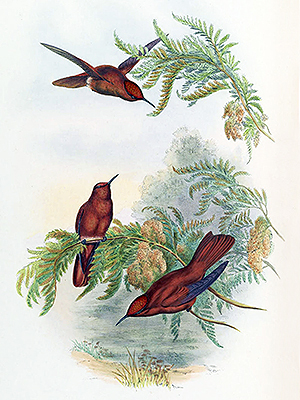
***
Let’s now move the Juan Fernández Firecrown itself, which for some time was also somewhat a mysterious bird.
The species was described in 1831, yet both sexes are so dissimilar that they immediately were described as two distinct species, the male as Trochilus fernandensis and the female as Trochilus stokesii (both by Capt. Philip P. King in „Proceedings of the Committee of Science and Correspondence of the Zoological Society of London 1: 30. 1831“).
John Gould in his hummingbird monograph [1] followed that by naming them es Eustephanos fernandensis and Eustephanos stokesii respectively, and, somewhat funny, wondered if he would ever get to see a female E. stokesii.
„Some of them are more richely coloured than others, but all have the metallic green crown; the question then arises, has the female this character as well as the male, or did Mr. Bridges procure males only?“ [1]
Well, no, they all were females!
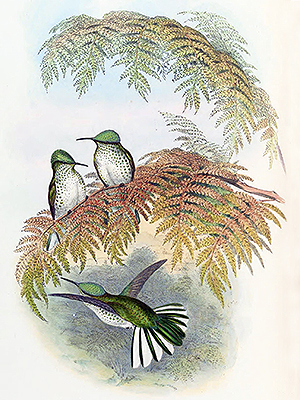
***
He corrected himself later in the supplement of his monograph [2], and by the way also introduced the second (sub)species.:
„… such a case is the present, in which, from lack of the requisite knowledge, I figured the two sexes of the Cinnamon Firecrown as distinct species, under the names of E. fernandensis and E. stokesii; and now that I am giving for the first time a Plate of the more recently discovered E. leyboldi, I have seized the opportunity to refigure the two sexes of E. fernandensis.“ [2]
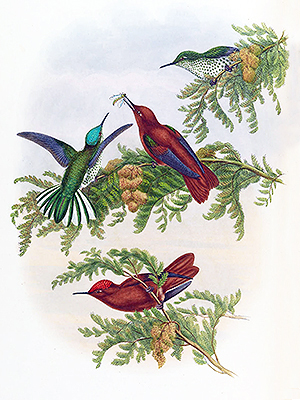
***
Let‘s talk about the differences between the two forms.:
S. f. ssp. leyboldi:
male: the glowing golden feathers on the crown stretch onto the neck
female: the back is more yellowish green instead of bluish green to green; the tail feathers with a far less amount of white.
The nominate race is endemic to Más a Tierra (Robinson Crusoe), while the ssp. leyboldi is supposed to have been endemic to Más a Fuera (Alejandro Selkirk).
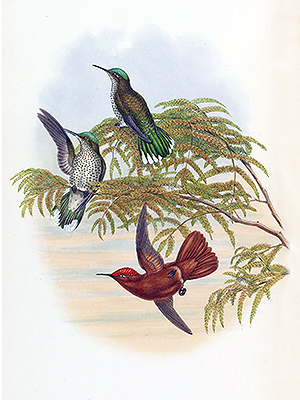
***
Let’s now take a look at the archipelago’s wonderful flora …! [5][6]
These are the plant species that are native (mostly endemic) to Isla Robinson Crusoe and that are known to be utilised by the Juan Fernández Firecrown.:
Centaurodendron dracaenoides Johow
Cuminia fernandeziana Colla
Dendroseris litoralis Skottsb.
Dendroseris macrantha (Bertero ex Decne.) Skottsb.
Eryngium bupleuroides Hook. & Arn.
Escallonia callcottiae Hook. & Arn.
Nicotiana cordifolia Phil.
Notanthera heterophyllus G. Don.
Ochagavia elegans Phil.
Raphithamnus venustus (Phil.) Rob.
Sophora fernandeziana (Phil.) Skottsb.
The most important endemic plant for the hummingbirds is Raphithamnus venustus (Phil.) Rob., a beautiful shrub with violet flowers, because it is the only native plant that flowers during the winter, thus is extremely important for the survival of the Juan Fernández Firecrown. The males often build their territory around such a shrub, and vigorously chase away other birds, including females except in the breeding season.
And these are the native plant species that occur (native or endemic) on Isla Alejandro Selkirk..:
Dendroseris regia Skottsb.
Eryngium sarcophyllum Hook. & Arn.
Nicotiana cordifolia Phil.
Raphithamnus venustus (Phil.) Rob.
Sophora masafuerana (Phil.) Skottsb.
They are not always conspecific, but at least congeneric, and Raphithamnus venustus does occur on this island as well, so …?
By the way, the first real inventure of Masafuera’s flora was made by Carl Skottsberg at the beginning of the 20th century [5], the island was already nearly completely denuded at that time by introduced goats, and there were only traces left of the former forests. It is thus no wonder that no hummingbird has survived there.
***
What do others think?:
Federico Johow, either Friedrich Richard Adalbert Johow, the German-Chilean botanist and biologist born 1959 and now (in 2018) 159 years old, or, more likely, someone with just the same name, has done some research on the same matter in 2007, and has found only four persons who have claimed to have seen hummingbirds on Isla Alejandro Selkirk.:
Augustín Guajardo, a botanist that has worked in the archipelago in 1869, Friedrich Johow (named as Federico Johow), the one mentioned above, Carl Skottsberg, and finally R. A. Philippi Bañados, a zoologist that has worked on the islands in 1928.
I could only find two of the abovementioned accounts, and I will generously share them with you here. 😉
Friedrich Johow:
„Eustephanus galeritus Mol. – Masatierra. En chile solamente durante el invierno. – Nombre vulgar en Juan Fernandez: Picaflor chico.
Eustephaus fernandensis King. – Endémico en Masatierra. – Nombre vulgar: Picaflor grande.
Eustephanus leyboldi Gould. – Endémico en Masafuera (*)
…
(*) Opinamos que esta especie, fundada en ejemplares mal conservados, es idéntica con el E. fernandensis de Masatierra. A lo ménos, no nos fué posible descubrir diferencia alguna entre los ejemplares que cazamos en una i en otra isla.“
Translation:
„Eustephanus galeritus Mol. – Masatierra. In Chile only during the winter. – Common name in Juan Fernandez: Picaflor chico.
Eustephaus fernandensis King. – Endemic in Masatierra. – Common name: Picaflor grande.
Eustephanus leyboldi Gould. – Endemic in Masafuera (*)
…
(*) We believe that this species, founded on poorly preserved specimens, is identical with E. fernandensis of Masatierra. At least, it was not possible for us to discover any difference between the specimens we hunted on one island and another island.“[3]
Carl Skottsberg:
„Die Kolibris gehören auf Masatierra zu den bedeutungsvollen Bestäuber[n]. Früher kam E. fernandensis – denn E. Leyboldii ist höchstwahrscheinlich mit ihm identisch – ebenfalls auf Masafuera vor, wo ich im August 1908 mehrere beobachtete. Im [Jahr] 1917 bekamen wir keinen einzigen zu sehen; er scheint hier ausgestorben, was übrigens keinen, der das Schicksal Masafueras kennt, überraschen wird.“
Translation:
„The hummingbirds belong on Masatierra to the significant pollinators. Formerly, E. fernandensis – because E. Leyboldii is most likely identical with it – also occurred on Masafuera, where I observed several in August 1908. In 1917 we did not get to see a single one; it seems to be extinct here, which by the way, will not surprise anyone who knows the fate of Masafuera.”[4]
***
The Juan Fernández Firecrown is said to be quite variable, especially the females, I personally have no access to any specimens nor do I know of any scientific assay that deals with that matter; and of course, the specimens used for the description of Leybold’s Firecrown are lost now, so my last words in this case are: Leybold’s Firecrown very likely should not be treated as a full species but indeed as a subspecies, it has in fact existed, and it is now extinct.
… uff, that was quite an amount of letters …. 😛
*********************
source:
[1] John Gould: A Monograph of the Trochilidae, or family of humming-birds. London: Printed by Taylor and Francis 1861
[2] John Gould: A Monograph of the Trochilidae, or family of humming-birds. Supplement. London: Henry Sothern & Co. 1887
[3] Friedrich Johow: Estudios sobre la flora de las islas de Juan Fernandez. Santiago de Chile, Imprenta Cervantes 1896
[4] Carl Skottsberg: Pollinationsbiologie und Samenverbreitung auf den Juan Fernandez-Inseln. 503-547. 1928. In: The Natural history of Juan Fernandez and Easter Island, edited by Carl Skottsberg. Vol. 2., Botany. Uppsala: Almqvist & Wiksells Boktryckeri, 1920-1953
[5] C. Skottsberg: Derivation of the Flora and Fauna of Juan Fernandez and Easter Island, Part 1. The Juan Fernandez Islands. 193-438.In: The Natural history of Juan Fernandez and Easter Island, edited by Carl Skottsberg. Vol.1., Geography, Geology, Origin of island life. Uppsala: Almqvist & Wiksells Boktryckeri, 1920-1956
[6] Michael S. Roy, Juan Carlos Torres-Mura, Fritz Hertel, Marina Lemus and Renate Sponer: Conservation of the Juan Fernandez firecrown and its island habitat. Oryx 33(3): 223-232. 1999
[7] Federico Johow: El picaflor de la Isla de Masafuera: ¿Subespecie extinta, nunca existió o Mistery Bird?. Boletín Chileno de Ornitología 13: 28-41. 2007
*********************
edited: 02.10.2018
Levaillant’s Blue-tailed Lory is another mysterious lory ‚described‘ at the very beginning of the 19th century by François Le Vaillant on the basis of a single specimen (alive or dead?).
The bird is very similar in many aspects to the Red Lory (Eos bornea (L.)), a species that does not occur on the island of Borneo, Indonesia, but on several small islands within the Maluku island group, Indonesia, namely Ambon, Buru, Saparua, Seram, Haruku, and the Kai Islands.
The mysterious lory differs from the Red Lory actually only in its name-giving blue tail.
The bird was never scientifically described, and since F. Le Vaillant wasn’t a fan of C. von Linné‘s binominal nomenclature system, it was only ever named as ‚Le Perroquet Lori a queue bleue‘, as ‚The Lori Parrot with a blue tail‘.
Here is the important part of Levaillant’s ‚description‘.:
„…
Le plumage général, c‘est-à-dire, celui de la tête, du cou, du dos, du croupion; les plumes des jambes du Lori à queue bleue, sont d’un rouge foncé, tirant au cramoisi. Toutes les couvertures des ailes sont du rouge cramoisi du corps, à l’exception de trois ou quatre de celles du millieu, qui sont bleu-foncé; queles autres de celles du millieu et les plus grandes sont lisérées de bleu. Les scapulaires, les deux dernières plumes des ailes près du dos, le bas-ventre et la queue entière, sont aussi bleus. Les grandes pennes alaires sont d’un noir brun. Le bec est d’un jaune d’ocre, et les pieds sont noirs.
L’espèce du Lori à queue bleue se trouve plus communément à l’île Bornéo. L’individu que nous en avons figuré de grandeur naturelle, fait partie de la belle collection de M. Raye de Breukelervaert, à Amsterdam.“
Translation:
„…
The general plumage, that is to say, that of the head, neck, back, rump; the feathers of the blue-tailed Lori’s legs are dark red, scarlet-crimson. All the wing coverts are crimson red, with the exception of three or four of the middle ones, which are dark blue; the others from the middle and the larger ones are marked with blue. The scapulars, the last two feathers of the wings near the back, the lower abdomen and the whole tail, are also blue. The large wing tips are black-brown. The beak is ochre yellow, and the feet are black.
The Blue-tailed Lori is more commonly found on Borneo Island. The individual that we have figured in natural size, is part of the beautiful collection of Mr. Raye de Breukelervaert, from Amsterdam.“ [1]
***
What or who is this Blue-tailed Lori?
Well, if F. Le Vaillant did only see a dead, a stuffed bird, this may in fact just have been a Red Lory lacking its actual tail, which had been replaced by the blue tail of any other parrot species – this method was actually quite common in these days, either to complete a incomplete specimen or even to make a complete new species, a fake species if you want, something unique that could earn high prizes other collectors in search for something unique for their collection were often willing to pay.
There existed many such collections in the 18th and early 19th century, containing real natural treasures but also things like unicorn horns, dried mermaids, and, of course fake bird species, especially birds of paradise and parrots.
It is also interesting that the island of Borneo is given as the place of origin. The bird may very well have been bought on a bird market on that island to end up as a corpse in a collection in the Netherlands, but, being definetely a member of the genus Eos, it clearly was not native to that island.
My last words here: Levaillant’s Blue-tailed Lory very likely is just a Red Lory with a fake tail.
*********************
source:
[1] François Le Vaillant: Histoire naturelle des perroquets, Paris Levrault, Schoell & Cie, An IX-XII. 1801–1805
*********************
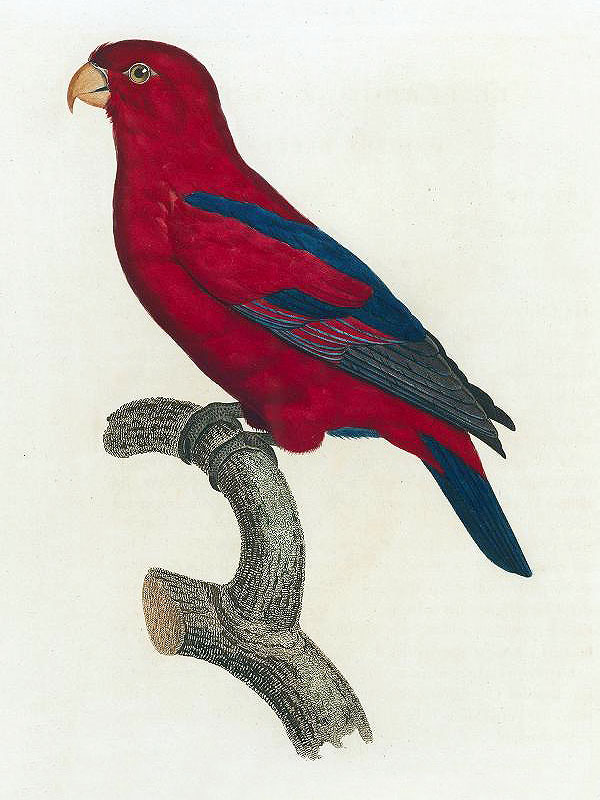
*********************
edited: 02.10.2018
The Unicolored Lory (Eos unicolor (Shaw)) is a bright red colored parrot, that is known from a single drawing and the annotated description in François Le Vaillant‘s ‚Histoire naturelle des perroquets‘ from the very early 19th century.
There were two individuals known at that time, kept in captivity in the Netherlands, from which one was depicted.:
„L’uniformité de la coleur du plumage de ce Lori nous a déterminé à lui donner le surnom d’unicolore; et cette coleur est d’un rouge pâle sur la tête, le cou, la poitrine, l’estomac, le ventre et les couvertures du dessous de la queue. Le manteau et le croupion, les couvertures des ailes et celles de la queue, lla queue elle-même, sont aussi rouges, mais d‘un noir brun vers leur pointe. Le bec est rouge, et les pieds sont d‘un brun terreux.
L’espèce de ce Lori se trouve aux Moluques. M. Temminck, d’Amsterdam, qui avoit deux de ces oiseaux dans sa belle collection, eut la bonté de m’en donner un. Ces deux individus sont les seuls de l’espéce que j’aie jamais vus.“
translation:
„The uniformity of the color of the plumage of this Lori has determined us to give him the moniker nickname; and this color is pale red on the head, neck, chest, stomach, belly, and undertail coverts. The mantle and the rump, the coverts of the wings and those of the tail, the tail itself, are also red, but of a dark brown towards their point. The beak is red, and the feet are of an earthy brown.
The species of this Lori is found in Maluku. M. Temminck from Amsterdam, who had two of these birds in his fine collection, was kind enough to give me one. These two individuals are the only ones of the species I have ever seen.“ [1]
***
The Maluku Islands were a Dutch colony (at least in parts), so it’s no wonder that birds cought there were transported to Amsterdam.
***
Since the Unicolored Lory is now known exclusively from the single drawing in ‚Histoire naturelle des perroquets‘, some zoologists think that this depiction may in fact simply show a Cardinal Lory (Chalcopsitta cardinalis (G. R. Gray)) from the Solomon Islands. This species, however, is not that unicolored but has a bright red underside and a rather dull cherry-red upper side, a longer tail, as well as a patch of bare skin around its beak.
The drawings made by Jacques Barraband are not just only very good, they are in fact scientifically correct, even for modern standards, so the Unicolored Lory can indeed be identified as a member of the genus Eos. This genus contains at least six species, that all are confined to the islands in the Banda Sea (the Maluku Islands and some islands off western New Guinea), Indonesia. All of these species are mainly bright red colored, with more or less amounts of bright blue areas.
There is a slight possibility that the two birds kept in captivity, were of hybrid origin, but this leads to the question for the parent species, since all other known congeneric species bear at least some blue in their plumage, while the Unicolored Lory was completely red.
The Maluku Islands, especially the smaller islands, are heavily deforested and the original forest has been replaced by plantations, this has probably already begun in the 14th century, when the islands were discovered by Arab merchants. Most of the endemic lory species are now heavily threatened with extinction, and at least two taxa (the Red-and-blue Lory (Eos histrio ssp. histrio (Statius Müller)), and the Talaud Red-and-blue Lory (Eos histrio ssp. talautensis Meyer & Wiglesworth)) are already completely extinct.
The Unicolored Lory may have been restricted to a single, small island within the region, and its population may already have been very low due to deforestation and hunting, when the two individuals were caught and brought to the netherlands
There is no obvious reason why the Unicolored Lory should not have existed!
*********************
References:
[1] François Le Vaillant: Histoire naturelle des perroquets, Paris Levrault, Schoell & Cie, An IX-XII 1801–1805
*********************
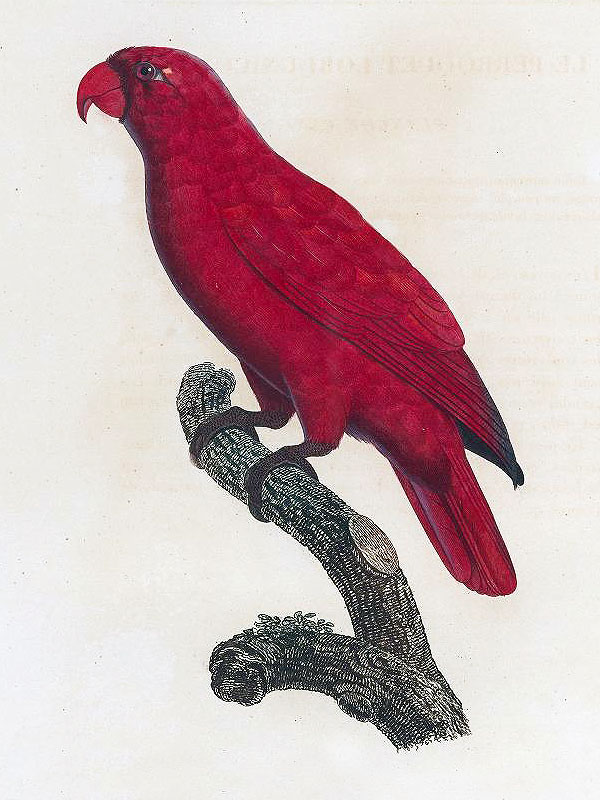
*********************
edited: 30.09.2018
Die Familie Aepyornithidae wurde endlich komplett überarbeitet! 🙂
***
Bisweilen wurden zeitgleich bis zu 15 Arten anerkannt; nach der letzten Revision, die vor ca. 50 Jahren gemacht worden war [!], waren davon immer noch sieben geblieben.:
Aepyornis gracilis Monnier
Aepyornis hildebrandti Burckhardt
Aepyornis maximus Geoffroy Saint-Hilaire
Aepyornis medius Milne-Edwards & Grandidier
Mullerornis agilis Milne-Edwards & Grandidier
Mullerornis betsilei Milne-Edwards & Grandidier
Mullerornis rudis Milne-Edwards & Grandidier
***
Und nun, nach der letzten Revision [1] sind nur vier Arten geblieben, und eine davon wurde in eine neue Gattung gestellt.:
Aepyornithidae
Aepyornis hildebrandti Burckhardt
Aepyornis maximus Geoffroy Saint Hilaire
Mullerornis modestus (Milne-Edwards & Grandidier)
Vorombe titan (Andrews)
*********************
Quellen:
[1] James P. Hansford; Samuel T. Turvey: Unexpected diversity within the extinct elephant birds (Aves: Aepyornithidae) and a new identity for the world’s largest birds. Royal Society Open Science 5(9): 1-28. 2018
*********************
bearbeitet: 27.09.2018
Bruner’s Rail (Cacroenis inornatus Bruner) is a very enigmatic species of rail supposed to have been endemic to the Tuamotu Archipelago, whose name repeatedly appears in listings of extinct birds and other publications. [4]
***
Yet, this species has never existed, but see for yourself.:
The name first appears in the “Field guide to the birds of French Polynesia” from 1972, obviously the first book about the birds of French Polynesia, and full of errors, some of them bad, others worst. [3]
The story begins right with the discovery of the Cocos Finch in 1843.: [1][2]
“This bird, which is in all probability a female, is from Bow Island, and is, I believe, the only insessorial form that has been brought from thence. Only a single example was procured, and its principal interest consists in its forming an additional species of a small group of birds inhabiting the Galapagos, to which islands they had hitherto appeared to be peculiar. …
Bow Island has truly little to boast of in its ornithology, since the only birds seen by us during a residence of six weeks at this Atol coral island were doves, the above new species of Cactornis, plover, a few black and white tern which appear attached to these situations, and herons; and none of these were at all numerous. The Cactornis inornatus was usually noticed about the lowly bushes of Petesia carnea, the succulent fruit of which most probably constitutes its chief food.”
***
Bow- or La Harpe Island, both are old names for the Hao atoll in the middle of the Tuamotu Archipelago, French Polynesia, and the plant mentioned in the text, Petesia carnea, is now known as Psychotria carnea (G. Forst.) A. C. Sm., a species that is native to Fiji and Tonga, and that has never existed in the Tuamotu Archipelago.
***
The bird is mentioned in the “Field guide to the birds of French Polynesia” [as Cacroenis inornatus] as being confusing and obscure but also as being small, speckled and generally brownish in appearance; it appears in a checklist at the end of the book [this time as Cactornis inornatus] as having been introduced to the Archipelago, which is complete bullsh**!
***
The Cocos Finch is now named as Pinaroloxias inornata (Gould), however, how this finch-like tanager finally ended up as a extinct rail species is still not known to me.
*******************
[1] John Gould: On nine new birds collected during the voyage of H.M.S. Sulphur. Proceedings of the Zoological Society of London 11. 103-107. 1843
[2] John Edward Gray; John Gould; John Richardson; Richard Brinsley Hinds and others: The zoology of the voyage of H.M.S. Sulphur: under the command of Captain Sir Edward Belcher, during the years 1836-42. London: Smith, Elder 1843-1846
[3] Phillip L. Bruner; O. G. Dykes: Field guide to the birds of French Polynesia. Bishop Museum Press 1972
[4] Greg Sherley; Rod Hay: Review of avifauna conservation needs in Polynesia. Bird Conservation Priorities and a Draft Avifauna Conservation Strategy for the Pacific Islands Region 10-17. 1999
********************

*******************
edited: 26.09.2018
There exists an almost unknown contemporaneous account from the 18th century, made by James Morrison, boatswain’s mate aboard the famous or infamous ‚Bounty‘, who made mention of a mysterious bird [… and how I love mysterious birds …!].:
“… the mountains produce birds of different kinds unknown to us, among which are a large bird nearly the size of a goose, which is good food; they are never observed near the sea nor in the low lands.” [1]
***
So, usually called the Tahiti Goose, Tahitian Goose, or Tahitian Mountain Goose – what are we talking about here actually?
We very probably do not talk about a goose, but why?
First we have to take into account who made the report:
A boatswain’s mate from the 18th century very likely was not a zoologist, but may in fact have known at least several European birds, especially poultry, so very likely knew chickens, doves, ducks, and geese, and very likely also quails, partridges and other so called game birds.
As a seafarer he perhaps may have had some good knowledge about seabirds, and probably could very well tell several species of them apart from each other.
These are the birds that we can just sort out, but what may it have been then?
Well, the Tahitian Mountain ‚Goose‘ apparently was a somewhat large, terrestrial bird, more or less the size of a feral goose, it was ‚good food‘ so it must have been easy to catch, it probably [actually very likely to almost certainly] was flightless, and it was unlike any bird known to ‚us‘, to the sailors of the ‚Bounty‘.
In my opinion, and in that of many others, the Tahitian Mountain ‚Goose‘ almost certainly was a kind of rail, a large, flightless rail, maybe a species from the widespread genus Porphyrio, somewhat like a Tahitian version of the New Zealand Takahe (Porphyrio mantelli (Owen)).
However, there is of course the chance that the Tahitian Mountain ‚Goose‘ was something completey different, we probably will never know for sure.
… mysterious ….
*********************
References:
[1] J. M. Derscheid: An unknown species – the Tahitian Goose. Ibis 81: 756-760. 1939
*********************
edited: 22.09.2018

When this tiny creature was first described it was thought to represent some parent form of the parrot order, however, it later [1] was reinvestigated and is now placed near the Passeriformes … near them, not among or in between them!
My reconstruction is life sized, the bird here is nearly 12 cm long, the feathers, however, are not known, so are completely speculative!
*********************
References:
[1] Gerald Mayr: A reassessment of Eocene parrotlike fossils indicates a previously undetected radiation of zygodactyl stem group representatives of passerines (Passeriformes). Zoologica Scripta 44(6): 587–602. 2015
*********************
edited: 17.09.2018
Ich hatte hier bereits über eine hypothetische Papageienart geschrieben, die einst auf der Insel Bora Bora im Gesellschaftsarchipel vorgekommen sein mag.
***
Ich möchte nun über ein paar sehr interessante Überlieferungen schreiben, die von Teuira Henry (1847-1915), einer tahitianischen Pädagogin, Ethnologin, Folkloristin, Historikerin, Linguistin und Gelehrten, in einem Manuskript hinterlassen wurden, das sie zu Lebzeiten aus den Stücken eines verlorenen Manuskripts rekonstruierte, das in den Jahren zwischen 1817 und 1856 ursprünglich von ihrem Großvater verfasst wurde. Es enthielt bedeutende Beiträge an mündlicher Folklore, Genealogie, Geschichte, Mythen und traditionellem Wissen wie Astronomie und Navigation. Ihr Manuskript wurde 1928 posthum vom Bernice Pauahi Bishop Museum als “Ancient Tahiti” veröffentlicht. [1]
***
Im Jahr 2006 schrieb Philippe Raust einen kleinen Artikel [2] über neu entdeckte und beschriebene Papageienarten, deren subfossile Überreste in Französisch Polynesien gefunden worden waren, er erwähnte hierbei auch die alten tahitianischen Namen einiger dieser Papageien, von denen einige jedoch immer noch keiner bekannten Art zugeordnet werden können.:
“… Peut être étaient-ce le vini-pa-tea perroquet de couleur pourpre à gorge blanche commun à toutes les îles de la Société et le vini-pa-uri de Pora Pora entièrement rouge décrit par T. Henry dans Tahiti au temps anciens? Il est connu que les plumes rouges étaient recherchées dans les sociétés polynésiennes préeuropéennes où elle symbolisaient le pouvoir des chefs; c’est peut être à cause de cela que ces espèces, trop chassées, ont disparu. T. Henry cite aussi le vini- rehu (perroquet sifleur gris), le tētē (perroquet noir de la Société), le ‘ura (perroquet rouge des montagnes) et le ‘a’a taevao (‘a’a sauvage des îles-sous-le-vent), le tavae (au plumage brillant et multicolore de Motu Iti, Tupai et Maupiha’a): cela fait au moins six espèces de perroquets, perruches et loris qui sont rapportés par la tradition.”
Übersetzung:
“… Vielleicht waren es der vini-pa-tea Papagei von purpurner Farbe mit weißem Hals, der allen Inseln der Gesellschaft gemein war, und der völlig rote vini-pa-uri von Pora Pora [Bora Bora], die von T. Henry in ‘Ancient Tahiti’ beschrieben wurden? Es ist bekannt, dass rote Federn in voreuropäischen polynesischen Gesellschaften begehrt waren, da sie die Macht der Häuptlinge symbolisierten; dies könnte der Grund sein, warum diese überjagten Arten verschwunden sind. T. Henry benennt auch den vini-rehu (grauer pfeifender Papagei), den tētē (schwarzer Papagei der Gesellschaftsinseln), den ‘ura (roter Bergpapagei) und den ‘a’a taevao (wilder ‘a’a der Inseln unter dem Winde), der tavae (mit strahlendem und buntem Gefieder von Motu Iti, Tupai und Maupiha’a): dies macht mindestens sechs [sieben!] Arten von Papageien, Sittichen und Loris, über die Überlieferungen existieren.“
***
Nun haben wir hier also offenbar sieben Papageienarten, aber welche davon ist welche?
‘a’a taevao – Raiatea-Sittich (Cyanoramphus ulietanus (Gmelin))
tavae – Rubinlori (Vini kuhlii (Vigors) ssp. ‘Bora Bora’) ?
tētē – Schwarzstirnsittich (Cyanoramphus zealandicus (Latham))
‘ura – ein mehr oder weniger komplett rot gefärbter Papagei, der offenbar nach seiner Farbe benannt wurde
vini-pa-tea – Saphirlori (Vini peruviana (Statius Müller))
vini-pa-uri – Rubinlori (Vini kuhlii (Vigors) ssp. ‘Bora Bora’) ?
vini-rehu – ein grauer Papagei [?] der pfeifende Geräusche macht, wie dem auch sei, rehu bedeutet jedenfalls nur grau; eventuell ein juveniler Saphirlori?
***
Die Gesellschaftsinseln waren die Heimat von mindestens fünf wissenschaftlich beschriebenen Papageienarten, die entweder anhand alter Überlieferungen bekannt sind oder anhand von subfossilen Überresten, außerdem gab es eine weitere Art, die heute auf eine einzige Population auf nur einer Insel im Australarchipel reduziert ist, früher aber viel weiter verbreitet war.
Nur ganze zwei davon existieren auch heute noch und nur eine davon bewohnt zumindest noch winzige Reste ihrer einstigen Heimat – der unfassbar schöne Saphir- oder Tahiti-Lori (Vini peruviana).
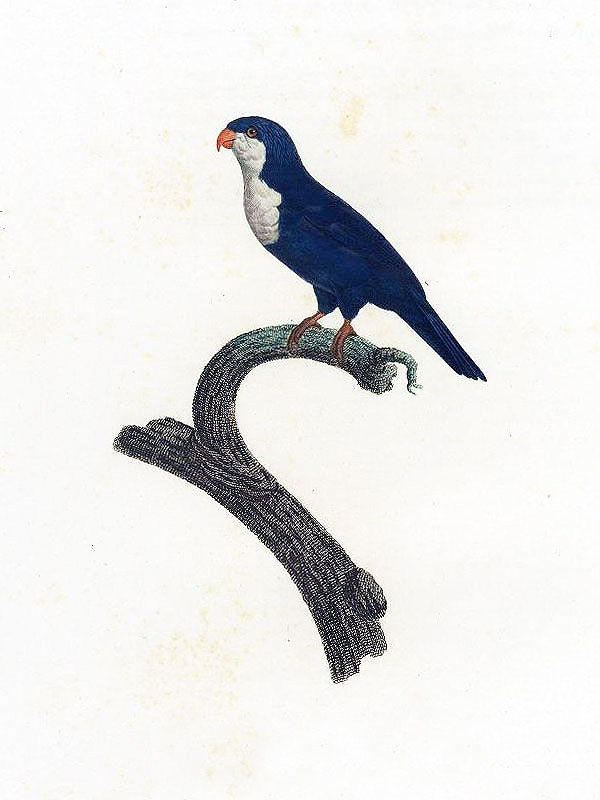
*********************
Quellen:
[1] Teuira Henry: Ancient Tahiti. Bishop Museum Bulletins 48: 1-651. 1928
[2] Philippe Raust: Les Psittacidés disparus de Polynésie Francaise. Te Manu: Bulletin de la Société d’Ornithologie de Polynésie 56. Septembre 2006
*********************
bearbeitet: 17.09.2018
Die aufregend schönen Elfenblauvögel sind offiziell eine kleine Familie mit nur zwei Arten, dem Philippinischen Elfenblauvogel (Irena cyanogastra) und dem Asiatischen Elfenblauvogel (Irena puella), die beide eine Reihe von Unterarten umfassen.
***
Nach einer Studie aus dem Jahr 2012 [1] scheint es jedoch acht Arten zu geben.:
Andaman-Feenblauvogel (Irena andamanica Abdulali) (vormals Irena puella ssp. andamanica Abdulali)
Indonesischer Elfenblauvogel (Irena crinigera Sharpe) (vormals Irena puella ssp. crinigera Sharpe)
Philippinischer Elfenblauvogel (Irena cyanogstra Vigors) (vormals Irena cyanogastra ssp. cyanogastra Vigors)
Ella’s Elfenblauvogel (Irena ellae Steere) (vormals Irena cyanogastra ssp. ellae Steere)
Hoogstral’s Elfenblauvogel (Irena hoogstraali Rand) (vormals Irena cyanogastra ssp. hoogstraali Rand)
Schwarzmantel-Elfenblauvogel (Irena melanochlamys Sharpe) (vormals Irena cyanogastra ssp. melanochlamys Sharpe; aber – ist nicht in der Studie enthalten!)
Asiatischer Elfenblauvogel (Irena puella (Latham)), mit drei Unterarten: Irena puella ssp. malayensis F. Moore, Irena puella ssp. puella (Latham), Irena puella ssp. turcosa Walden
Palawan-Elfenblauvogel (Irena tweeddalei Sharpe) (vormals Irena puella ssp. tweeddalei Sharpe)
***
Es ist sehr interessant, dass die meisten dieser „neuen“ Arten ursprünglich als eigenständige Arten beschrieben wurden.
*********************
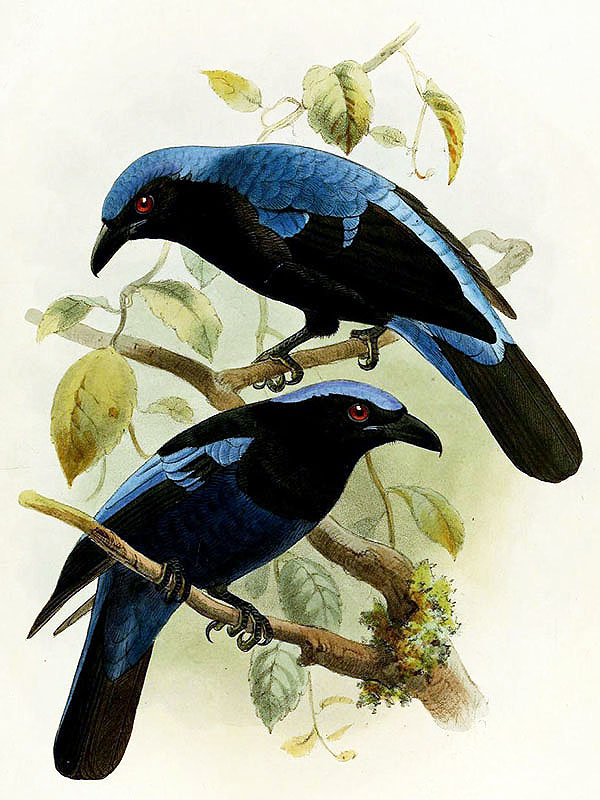
*********************
Update:
Der Palawan-Elfenblauvogel gilt nun offiziell als vollwertige Art und wird auch als solche in der HBW-Checkliste von 2016 geführt. [2]
*********************
Quellen:
[1] Maria Moltesen; Martin Irestedt; Jon Fjeldså, Per G. P. Ericson, Knud A. Jønsson: Molecular phylogeny of Chloropsidae and Irenidae – Cryptic species and biogeography. Molecular Phylogenetics and Evolution 65: 903-914. 2012
[2] Illustrated Checklist of the Birds of the World. Lynx Edicions; Ill edition Vol. 1 & 2. 2014/2017
*********************
bearbeitet: 17.09.2018
John Muir Laws: The Laws Guide to Drawing Birds. Heyday 2012
*********************
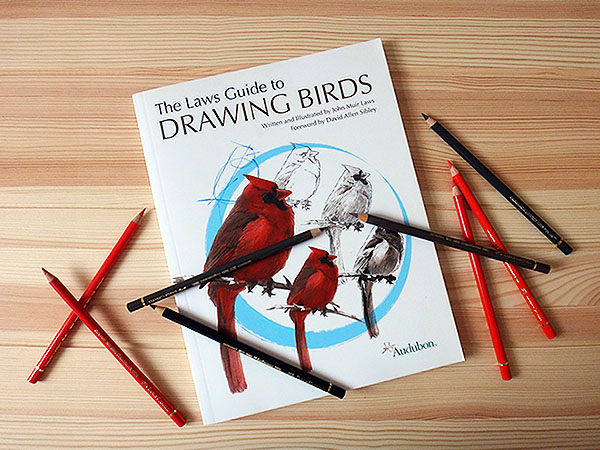
This is yet another book that I found recommended on the Avian Musings blog, where I found many other books that I then had to buy for myself, not least because one can never have too many books. 😛
There’s nothing I could add to the many reviews found online, the book is indeed a treasure chest full of the finest bird art and especially „how to do’s“.
*********************
edited: 03.09.2018
Diese Art, die bis vor kurzem als Unterart des Braunkopfkleibers (Sitta pusilla Latham) angesehen wurde, ist auf der Insel Grand Bahama, Bahamas, endemisch, wo sie wiederum auf einen einzigen kleinen Kiefernwald beschränkt zu sein scheint.
Der Bestand ist extrem klein – 2007 wurden nur etwa 20 Vögel gezählt; die fortschreitende Zerstörung ihres Lebensraums war und ist der Hauptgrund für ihren Rückgang. Diese sowieso viel zu kleine Population brach gerade zusammen, nachdem der Hurrikan Matthew 2016 die Bahamas getroffen hatte.
An diesem Datum [29.08.2018] sind nur 2 [in Worten zwei!!!] Vögel unbekannten Geschlechts bekannt, was den Bahama-Kleiber zur seltensten und am stärksten gefährdeten Vogelart der Welt macht.
***
Da bekannt ist, dass nur zwei Vögel überleben, und angesichts der Tatsache, dass nicht bekannt ist, ob diese beiden Individuen ein Paar sind oder nicht, sind die Zukunftsaussichten für diese Art ziemlich düster und der Bahama-Kleiber wird wahrscheinlich bald in die Liste der ausgestorbenen Arten aufgenommen.
*********************
bearbeitet: 29.08.2018
Darryl N. Jones; René W. R. J. Dekker; Cees S. Roselaar: The Megapodes. Oxford University Press 1995
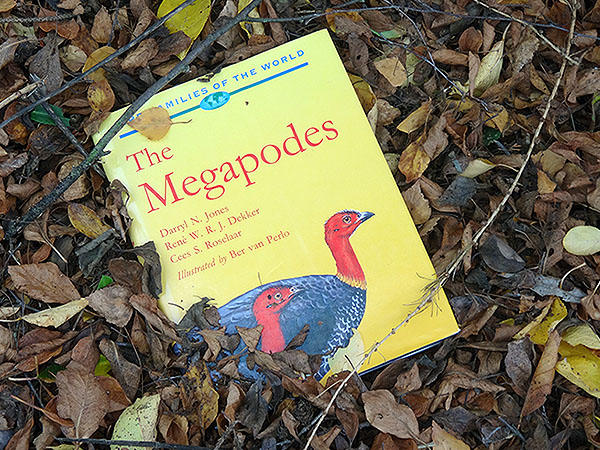
The Megapodes are a group of extremely interesting birds, probably best known for their rather reptilish way of „child care“, the eggs not being incubated by the birds themselves but by the aid of either microbial decomposition of organic matter, geothermal activity or solar radiation.
To me personally these birds share a somewhat prehistoric „aura“.
The book is a monography, so contains all information regarding the family Megapodiidae known at the date of the writing, all species are depicted, yet, because of the small number of species, however, there are only 8 plates and only a very small number of subspecies is depicted (as far as I remember, it is actually only one – I’m too lazy right now to walk to my book shelf to look again ….
The book even contains some interesting facts about the former distribution of many of these species, including eyewitnesses accounts and reports of eggs found at strange places and so on.
All in all I can only recommend this book, at least to those who are interested especially in this bird family.
*********************
edited: 20.08.2018
You probably have heard of plastic pollution before, and you may also have heard of the fact that some seabirds are highly threatened by it. But why is this so?
For millions of years seabirds like the albatrosses kept feeding from the ocean’s surface. It was an easy way to collect food, just flying along the ocean’s surface taking up all things floating about all they caught were little animals, and the worst things they could catch would have been little pieces of drifting wood or other plant material like algae.
And – that’s what these birds still do today.
Yet, the situation has changed dramatically. The surfaces of the oceans all over the world are covered with larger, as well as smaller to tiny bits of plastic debris, albatrosses just catch all of these little pieces and feed their chicks with them.
That is why perhaps all of them are containing plastic in their stomachs, and many of them, far to many of them, are dying from starvation despite having their stomachs full of „food“.
*********************
The movie „Albatross“ from 2017 [?] by Chris Jordan shows the fate of the Laysan Albatross colony on the Midway atoll in the northwestern Hawaiian Islands chain, it includes many graphic and heartbraking scenes of dead and dying albatross chicks, and it gives us an idea of the real situation of planet Earth’s oceans.
These are nightmarish scenes, yet there are still people [or rather the degenerated brain-less truth-deniers that we come along so many times these days] that state that all of this is fake!
The plastic pollution isn’t a fake, nor is it the devastating state of the populations of so many sea-dwelling animals including seabirds.
*********************
The following pictures show decayed albatross carcasses, all photographed on the northeastern Hawaiian Islands, and all containing plastic pieces inside.
*********************

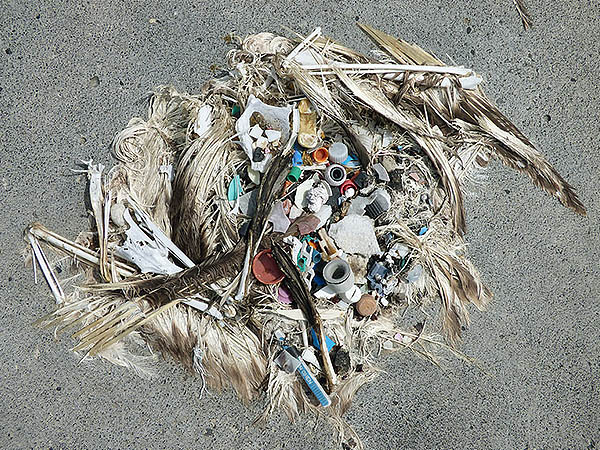

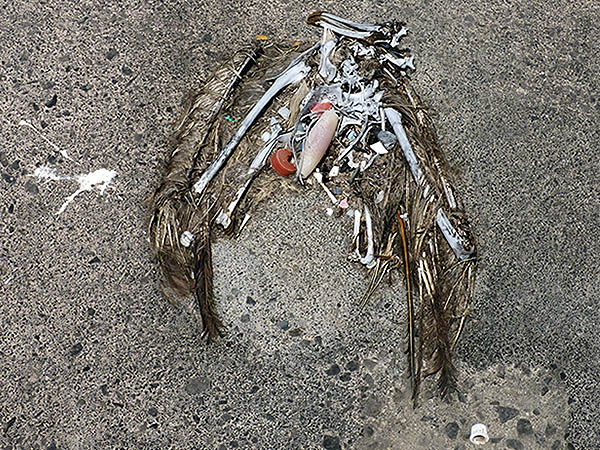
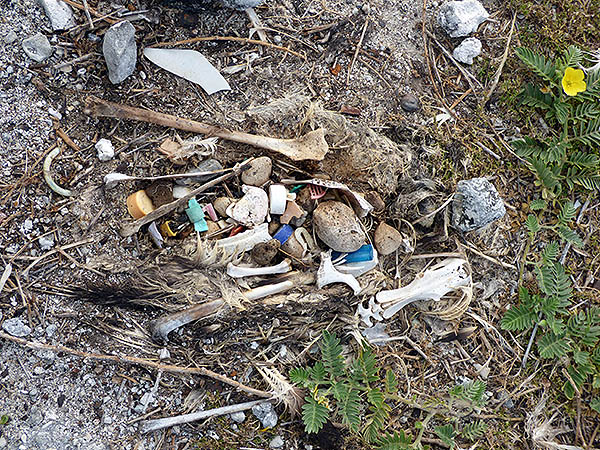
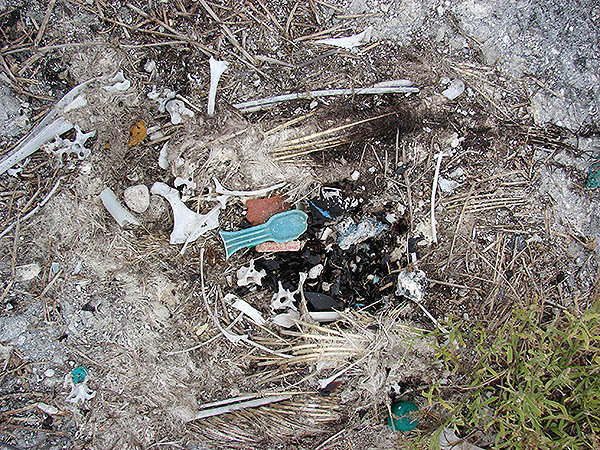
*********************
edited: 24.07.2018

*********************
bearbeitet: 11.07.2018
The Whenua Hou Diving Petrel was named after Whenua Hou [Codfish Island] a small island offshore the northwest coast of Stewart Island, New Zealand, where now the last remaining breeding population of this species, some 150 individuals at the most, remains.
The species did once breed on other New Zealand islands as well, including Dundas Island and Enderby Island (Auckland Islands), the Chatham Islands, South Island, and Stewart Island. It may also have bred on Macquarie Island.
The birds of that population are just now recognized as a distinct species, differing from the South Georgia Diving Petrel (Pelecanoides georgicus Murphy & Harper), with which they were until recently considered conspecific, and even consubspecific [if such a word exists] since this species was thought to be monotypic.
The Whenua Hou Diving Petrel can be distinguished from the South Georgia birds by several external features, especially by its more contrasting plumage.
*********************
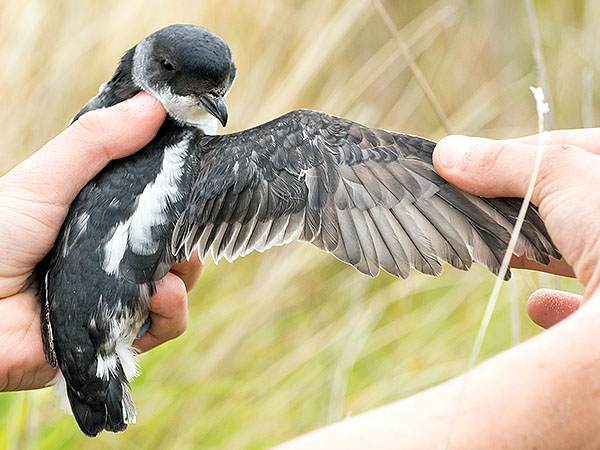
Unfortunately, all sea bird species are more or less threatened with extinction right now, mainly because of the increasing plastic pollution of the world’s oceans.
*********************
References:
[1] Johannes H. Fischer, Igor Debski, Colin M. Miskelly, Charles A. Bost, Aymeric Fromant, Alan J. D. Tennyson, Jake Tessler, Rosalind Cole, Johanna H. Hiscock, Graeme A. Taylor, Heiko U. Wittmer: Analyses of phenotypic differentiations among South Georgian Diving Petrel (Pelecanoides georgicus) populations reveal an undescribed and highly endangered species from New Zealand. PLoS ONE 13(6): e0197766. 2018
*********************
edited: 28.06.2018
Hier möchte ich einmal eine Art Fortsetzungs“roman“ beginnen, der sich mit geheimnisvollen, kaum bekannten, rätselhaften Vogelformen beschäftigen soll.
***
Die Familie Sylphornithidae wurde im Jahr 1988 für die Art Sylphornis bretouensis Mourer-Chauviré erstellt, die aus dem oberen Eozän Frankreichs stammt. Weitere Gattungen/Arten wurden später hinzugefügt. [1][2][3][4]
Die Familie umfasst sehr kleine, singvogelähnliche Vögelchen, gehört allerdings zur Ordnung der Spechtvögel (Piciformes) und ist innerhalb dieser Ordnung wahrscheinlich am nächsten mit den rezenten Glanzvögeln (Galbulidae) verwandt. Die Sylphornithidae sind hier nur eine von wahrscheinlich mehreren Familien innerhalb dieser Ordnung, die im Paläogen [Paläozän, Eozän, Oligozän] die Nischen besetzten, die heute von Singvögeln eingenommen werden. [4]
***
Die bislang bekannten Vertreter der Sylphornithidae weisen einen semi-zygodactylen Fussbau auf, das bedeutet, die äußere Zehe konnte je nach Bedarf nach vorn oder nach hinten gedreht werden.
***
Die folgenden Gattungen/Arten werden [von einigen Autoren] zur Familie Sylphornithidae gestellt.:
Palaegithalus cuvieri (Gervais): 1852 als Singvogel beschrieben, Oberes Eozän, Frankreich
Sylphornis bretouensis Mourer-Chauviré: 1988, Oberes Eozän, Frankreich [1]
Eutreptodactylus itaboraiensis Baird & Vickers-Rich: 1997, Oberes Paleozän, Brasilien; diese Art wurde ursprünglich der Familie der Kuckucke (Cuculidae) zugeordnet [2]
Oligosylphe mourerchauvireae Mayr & Smith: 2002, Unteres Oligozän, Belgien [3]
*********************



***
Es bleibt noch zu erwähnen, dass die Welt im Paläogen einerseits recht ähnlich ausgesehen haben mag wie heutzutage, dass aber viele bekannte Rollen von anderen „Darstellern“ eingenommen wurden, nicht nur bei den Säugern sondern auch bei den Vögeln. Echte Singvögel gab es zu dieser Zeit auf der heutigen Nordhalbkugel noch nicht oder zumindest noch kaum, ihre Nischen wurden von vollkommen anderen Vögeln eingenommen, darunter Verwandte der Hopfe, der Mausvögel, der Papageien oder der Spechtvögel.
Echte Singvögel, die nachweißlich in Australien entstanden, wanderten erst im Laufe des Paläogens ein und konnten sich schließlich zum Ende dieses Zeitalters wirklich etablieren und zu der unfassbaren Anzahl an Arten weiterentwickeln, die wir heute kennen.
*********************
Referenzen:
[1] C. Mourer-Chauviré: Le gisement du Bretou (Phosphorites du Quercy, Tarn-et-Garonne, France) et sa faune des vertebres de l’Eocene superieur; 2. Oiseaux. [Le Bretou locality (Quercy Phosphorites, Tarn-et-Garonne, France) and its late Eocene vertebrate fauna; 2. Birds.]. Palaeontographica Abteilung A 205(1-6): 29-50. 1988
[2] Robert F. Baird; Patricia Vickers-Rich: Eutreptodactylus itaboraiensis gen. et sp. nov., an early cuckoo (Aves: Cuculidae) from the Late Paleocene of Brazil. Alcheringa: An Australasian Journal of Palaeontology 21(2): 123-127. 1997
[3] G. Mayr; Richard Smith: Avian remains from the lowermost Oligocene of Hoogbutsel (Belgium). Bulletin de l’Institut Royal des Sciences Naturelles de Belqique, Sciences de la Terre 72: 139-150. 2004
[4] Gerald Mayr: The phylogenetic relationships of the Tertiary Primoscenidae and Sylphornithidae and the sister taxon of crown group piciform birds. Journal of Ornithology 145(3): 188-198. 2004
*********************
geändert: 26.05.2018
Plovers Lake Cave [see photo below] in the Gauteng Province of South Africa is known for its tens of thousands of fossils from the Pleistocene era, the remains date from about 1 Ma. to 70000 years.
*********************
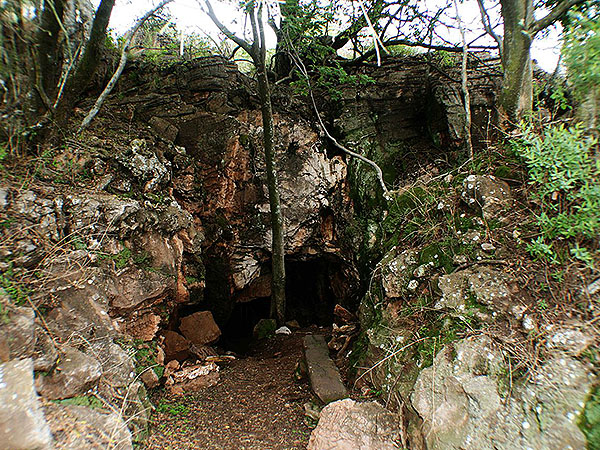
Among the many fossils is a so-called quadrate of a very small Agapornis sp., closely related to the Rosy-faced Lovebird (Agapornis roseicollis (Viellot)), yet very much smaller, reaching a size of only about 12 cm.
*********************
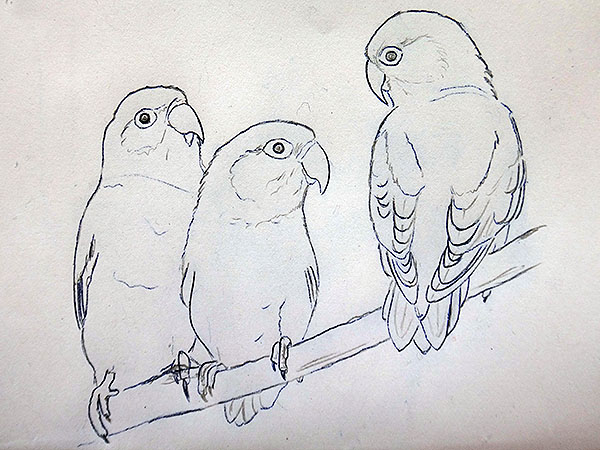
It should be noted that another very small Agapornis sp. is known from another South African site, but this has been dated to be about 900000 years older, and furthermore these remains appear to have been lost.
*********************
References:
[1] Thomas A. Stidham: A small Pleistocene lovebird (Psittacidae: Agapornis) from Plovers Lake, South Africa. Neues Jahrbuch für Geologie und Paläontologie. Abhandlungen Band 256(1): 123-128. 2010
*********************
edited: 23.05.2018
Dies ist nur eine Skizze eines Palaeotodus emryi, eines ziemlich großen Todi-Vorfahren aus dem frühen Oligozän von Wyoming, USA.

Heute sind die Todies auf die Karibik beschränkt, wo fünf Arten, die alle mehr oder weniger gleich aussehen, auf Kuba, auf Hispaniola sowie auf Jamaika und Puerto Rico zu finden sind.
Es ist sehr seltsam, wie wenig sich diese Vögel in den letzten 30 Millionen Jahren verändert haben.
********************
bearbeitet: 22.05.2018
Dieser nicht so kranichartige kleine Vogel lebte einst im frühen Oligozän vor etwa 32,5 bis 29,5 Millionen Jahren im heutigen Belgien und Frankreich und sicherlich auch in anderen Teilen Europas.
Die Art erreichte die Größe eines kleineren Huhns oder etwa 35 cm Länge in meiner Rekonstruktion.
Es wird angenommen, dass die Familie, zu der die Art gehört, am engsten mit den Rallenkranichen (Aramidae), den Kranichen (Gruidae) und den Trompetervögeln (Psophidae) verwandt ist, und tatsächlich scheint meine Rekonstruktion einen Vogel zu zeigen, der etwas von all diesen drei Familien hat.
*********************
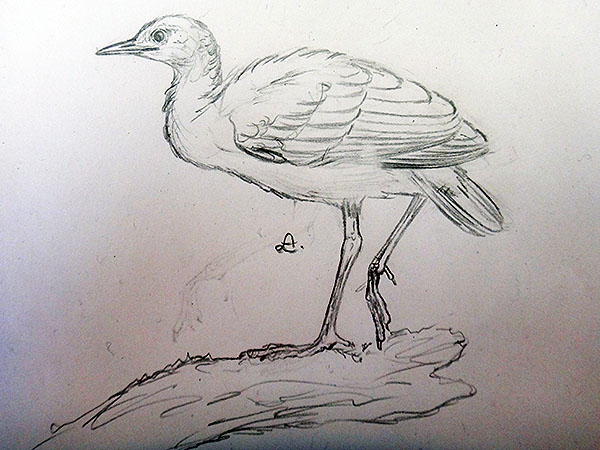
*********************
Quellen:
[1] Gerald Mayr: A chicken-sized precursoor from the early Oligocene of France. Naturwissenschaften 92:389-393. 2005
[2] Gerald Mayr: Parvigruidae (Aves, core Gruiformes) from the early Oligocene of Belgium. Palaeobiodiversity and Palaeoenvironments 93(1): 77-89. 2012
*********************
bearbeitet: 20.05.2018
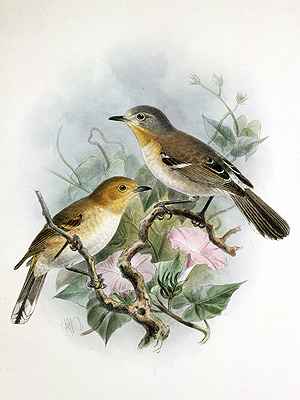
***
Die Elepaios, bis vor kurzem als eine Art mit fünf Unterarten betrachtet, sind auf den Hawai’i-Inseln endemisch verbreitet, wo sie aber auf die Inseln Hawai’i, Kaua’i und O’ahu beschränkt sind.
Die Vögel erreichen eine Größe von etwa 14 cm.
Die Elepaios kommen nicht auf den Inseln vor die vormals Maui Nui formten, Kaho’olawe, Lana’i, Maui und Moloka’i, ein Verbreitungsmuster, das im biogeografischen Sinn recht unlogisch ist.
Es gibt jedoch mindestens einen zeitgenössischen Bericht, der darauf hindeutet, dass dies nicht immer so gewesen ist.:
„It seems worth while recording that an old native who accompanied me on my Moanui trip said that he had heard from his father “that a long time ago there was on Molokai a small brown bird that ran on the ground but could not fly,” but that they had all been dead for a long time. He gave its name as Moho (Pennula). He also said that his father had told him of the Elepaio (Chasiempis) being on Molokai in the olden time. Mr. Theodore Meyer substantiated this report by saying that when he was a boy it was generally known to the old natives that both the Moho and Elepaio had been plentiful, but that they had long ago died out.“
Übersetzung:
„Es scheint lohnend zu erwähnen, dass ein alter Einheimischer, der mich auf meinem Moanui-Trip begleitete sagte, dass er von seinem Vater hörte, “dass vor langer Zeit auf Molokai ein kleiner brauner Vogel lebte, der am Boden rannte aber nicht fliegen konnte”, aber dass sie alle längst tot seien. Er nannte ihn Moho (Pennula). Er sagte auch, dass sein Vater ihm erzählte, dass es den Elepaio (Chasiempis) in alten Zeiten auf Molokai gab. Mr. Theodore Meyer bestätigte diesen Bericht indem er sagte, als er ein Junge war, wussten die alten Einheimischen sehr wohl vom Moho und vom Elepaio, dass sie aber vor langer Zeit ausgestorben sind.“
[W. A. Bryan: Some Birds of Molokai. Bishop Museum Occasional Papers 4(2): 43-86. 1908
***
Das Vorkommen lokaler Elepaio-Formen auf diesen Inseln muss trotz oben aufgeführtem zeitgenössischen Bericht immer noch als hypothetisch gelten, da die archäologischen Fundstätten auf diesen Inseln, trotz der vielen dort gefundenen Knochen kleiner passeriner Vögel nie Reste von Elepaios hervorbrachten.
***
Die heutigen Elepaios werden als drei Arten betrachtet, eine auf der Insel Hawai’i, eine auf Kaua’i, eine auf O’ahu.
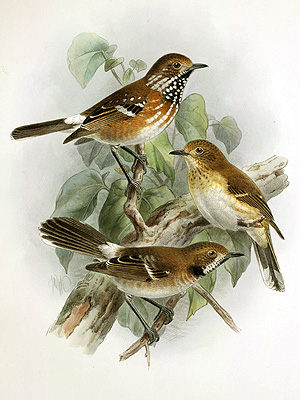
***
Die Art der Insel Hawai’i wiederum umfasst drei geografisch voneinander getrennte und verschieden gefärbte Formen, die vormals als eigenständige Unterarten betrachtet wurden, heute aber als Farbmorphen gelten, die in ihrer Färbung an ihren jeweiligen Lebensraum angepasst sind (… dunkler in feuchteren Regionen, heller in trockeneren …). Eine dieser drei Formen jedoch unterscheidet sich genetisch bereits so weit von den beiden anderen, dass man von einer sich entwickelnden neuen Unterart sprechen könnte.
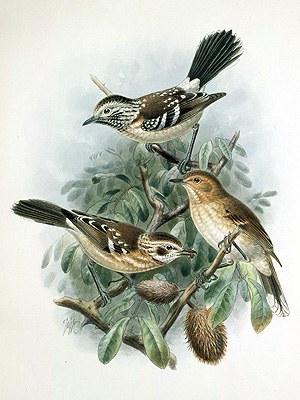
***
Die Elepaios gehören zu den Monarchschnäppern (Monarchidae), im Gegensatz zu nahezu sämtlichen anderen endemischen Vogelformen der Hawai’i-Inseln stammt der Urahn der Elepaios also nicht aus Nordamerika sondern aus Australasien.
Außerdem haben es die Elepaios geschafft, sich den veränderten Umweltbedingungen anzupassen, die die Inbesitznahme der Inseln durch den Menschen mit sich brachten, vor allem scheinen die Vögel gegen eingeschleppte Vogelkrankheiten immun geworden zu sein.
*********************
geändert 04.05.2018
I thought it would be a good idea to create a list (I loce to do lists) of all known Hawaiian drepanidine finches, and to assign vernacular names to all of them, but Hawaiian ones!
I have only translated ‘my’ names but not those that are already in use.
***
Aidemedia chascax – Nuku pololei [Straight-billed]
Aidemedia lutetiae – Nuku pololei [Straight-billed]
Aidemedia zanclops – Nuku pahi kakiwi [Sickle-billed]
Chloridops kona – Manoa ma’oma’o, Ma’oma’o-‘ai-naio [Thick-and-green, Green feeds on Naio]
Chloridops regiskongi – Nuku pa‘a [Strong-billed]
Chloridops wahi – Nuku palupalu [Weak-billed]
Ciridops anna – ‘Ula’-ai-hawane, Waaihawane
Ciridops tenax – ‘Ula-me-‘ele’ele [Red-and-black]
Drepanis coccinea – ‘I’iwi, ‘I’iwi polena, ‘I’iwi popolo
Drepanis funerea – Hoa, Mamo, ‘O’o nuku-mu , ‘O’o-nuku-umu
Drepanis pacifica – Hoha, Hoho, Mamo
Dysmorodrepanis munroi – ‘O’u nuku hakahaka [Gap-billed Ou]
Hemignathus affinis – Nuku pu‘u
Hemignathus ellisianus – ‘Akialoa, Kipi
Hemignathus flavus – ‘Amakihi
Hemignathus hanapepe – Nuku pu‘u
Hemignathus kauaiensis – ‘A’alawi, ‘Alawi, ‘Amakihi, ‘Amakihi ‘awa’awa, Kihi, Kihikihi
Hemignathus lanaiensis – ‘Akialoa
Hemignathus lucidus – Nuku pu‘u
Hemignathus munroi – ‘Akiapola’au
Hemignathus obscurus – ‘Akialoa, ‘Akihi-a-loa, ‘Akihi-loa
Hemignathus stejnegeri – ‘Akialoa
Hemignathus upupirostris – ‘Akihi-‘ai-‘ili la’au [Akihi feeds on tree bark]
Hemignathus virens ssp. virens – ‘Amakihi
Hemignathus virens ssp. wilsoni – ‘Amakihi
Hemignathus vorpalis – Nuku ihe [Spear-billed]
Himatione freethi – ‘Apapane mai Kauo [Apapane from Laysan]
Himatione sanguinea – ‘Akakani, ‘Akapane, ‘Apapane
Loxioides bailleui – Palila
Loxioides kikuchi – Palila loa [Large Palila]
Loxops caeruleirostris – ‘Akeke’e, ‘O’u-holowai
Loxops coccineus – ‘Akakane, ‘Akepa, ‘Akepeuie
Loxops ochraceus – ‘Akakane, ‘Akepa, ‘Akepeuie
Loxops wolstenholmei – ‘Akakane, ‘Akepa, ‘Akepeuie
Magumma parva – ‘Alawi, ‘Anauani’i, ‘Anianiau
Manucerthia mana – ‘Alawi
Melamprosops phaeosoma – Po’o-uli
Oreomystis bairdi – ‘Akikeke, ‘Akikihi, ‘Akikiki
Orthiospiza howarthi – Manu kuahiwi, Manu mauka [Highland bird, Bird from the mountains]
Palmeria dolei – ‘Akohekohe
Paroreomyza flammea – Kakawahie
Paroreomyza maculata – ‘Alauahio, ‘Alauwahio
Paroreomyza montana ssp. montana – ‘Alauahio, ‘Alauwahio
Paroreomyza montana ssp. newtoni – ‘Alauahio, ‘Alauwahio
Pseudonestor xanthophrys – Kiwikiu
Psittirostra psittacea – ‘O‘u
Rhodacanthis flaviceps – Po’o lena [Yellow-headed]
Rhodacanthis forfex – ?
Rhodacanthis litotes – ?
Rhodacanthis palmeri – Hopue, Po’o ‘alani [Orange-headed]
Telespiza cantans – Lele-i-honua, Melemele-‘ai-hua, Palila mai Kauo [Jumps on the ground, Yellow eats eggs, Palila from Laysan]
Telespiza persecutrix – Palila kahakai [Beach Palila]
Telespiza ultima – Palila mai Moku Manu [Palila from Nihoa]
Telespiza ypsilon – Palila iki, Palila kahakai [Small Palila, Beach Palila]
Vangulifer mirandus – Hopu mea kolo, Nuku kumumu [Catches insects, Blunt-billed]
Vangulifer neophasis – Hopu mea kolo, Nuku kumumu [Catches insects, Blunt-billed]
Viridonia sagittirostris – Nuku pua [Arrowbill]
Xestospiza conica – Nuku pu‘u [Cone-billed]
Xestospiza fastigialis – ?
*********************
edited: 17.04.2018
… endlich mal wieder etwas Zeit zum Zeichnen ….
***
Aloha!

Darf ich vorstellen: ein Pfeilschnabel (Viridonia sagittirostris Rothschild) auch bekannt als Einsiedlerkleidervogel oder Großer Amakihi; ein Fink, ja, tatsächlich ein Fink, von der größten der Hawai’i-Inseln, Hawai’i selbst, und natürlich, wie es sich für einen ‘ordentlichen’ hawaiianischen Vogel gehört, absolut und komplett ausgestorben.
Mahalo nui loa, a hui hou kakou!
*********************
bearbeitet: 16.04.2018
I just tried to draw a cretaceous bird from China, Archaeorhynchus spathula, well, I’m not that happy with the results. 😦
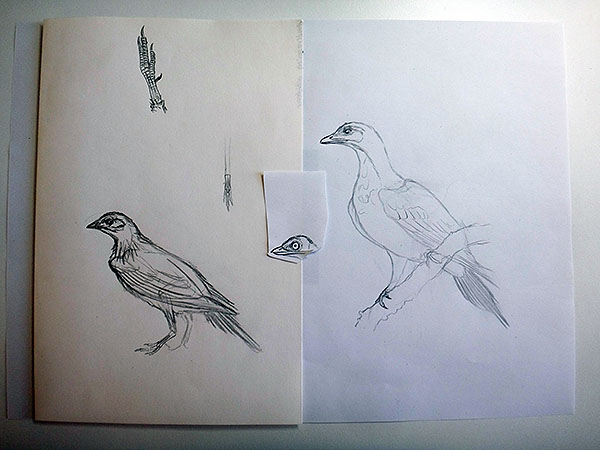
*********************
edited: 22.01.2019
This bird was described in 2010, it was then thought to be somehow related to the Charadriiformes respectively to the Charadriiformes “orbit”, later it was assumed to belong in some kind of relationship with other likewise “well-known” birds like Eocuculus cherpinae (Chandler), or Pumiliornis tessellatus Mayr.
The reconstruction shows a tiny bird, some 12 cm long, with a sharp-pointed beak and a quite long neck, such a bird would have needed long tail feathers to stabilize its body – so I just gave it a long tail, cause the feathers are not preserved in the Fur Formation birds.
***
So here is how all begins, some cut-out bone drawings put together, lines made with a pencil etc..:
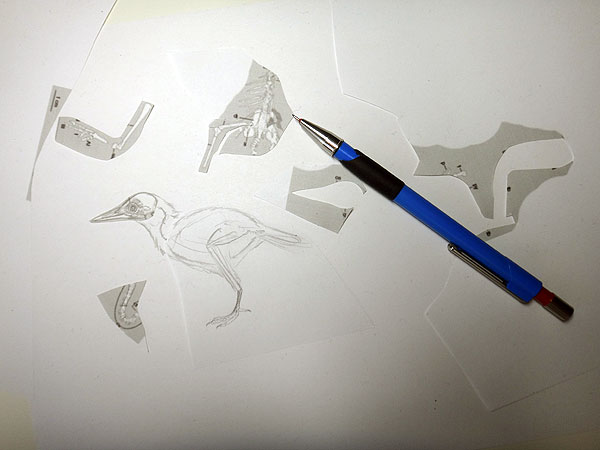
The final result is a quite life-like bird, maybe I got enough time to make a real painting, with colors and so on ….:
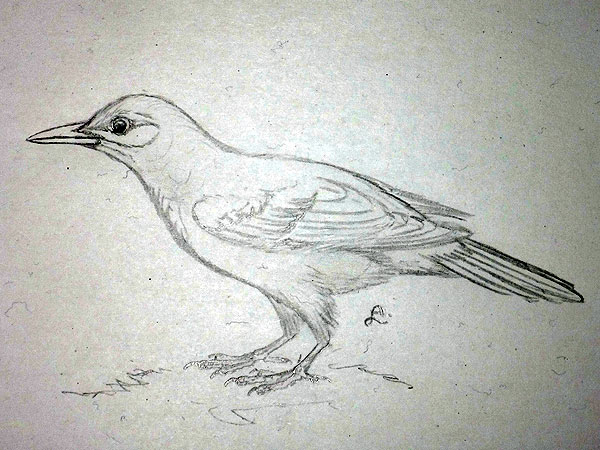
*********************
References:
[1] Sara Bertelli; Bent K. Lindow; Gareth J. Dyke; Luis M. Chiappe: A well-preserved ‘charadriform-like’ fossil bird from the Early Eocene Fur Formation of Denmark. Paleontology 53(3): 507-531. 2010
[2] Gerald Mayr: On the osteology and phylogenetic affinitis of Morsoravis sedilis (Aves) from the early Eocene Fur Formation of Denmark. Bulletin of the Geological Society of Denmark 59: 23-35. 2011
*********************
edited: 22.01.2018
Illustrated Checklist of the Birds of the World. Lynx Edicions; Ill edition Vol. 1 & 2. 2014/2017
*********************
[]
Heute habe ich den zweiten Band dieses Werkes bekommen, damit ich sie beide endlich stolz präsentieren kann.
Nun, was kann ich sagen, außer dass beide einfach wunderschön sind?! Wahrscheinlich nichts, aber warte, eins … der erst kurzzeitig als eigenständige Art anerkannte Natewa-Seidenfächerschwanz (Lamprolia klinesmithi Ramsay) hat wahrscheinlich sehr spät seinen Weg in das Buch gefunden, daher ist die Darstellung nichts anderes als eine verkleinerte und aufgehellte Version der Darstellung des Seidenfächerschwanz (Lamprolia victoriae Finsch) direkt daneben … das ist alles.
Die Darstellungen sind recht klein und einige Einzelheiten nur schlecht zu erkennen, wenn man die original großen Abbildungen möchte, muss man sich die eigentlichen HBW-Bücher kaufen (dürften zusammen so gegen 2000,- € kosten) oder sich auf der dazugehörigen Webseite anmelden (kostet keine Ahnung wie viel € im Monat).
*********************
bearbeitet: 15.03.2021
Hermann Heinzel; Barnaby Hall: Galápagos Diary: A Complete Guide to the Archipelago’s Birdlife. Bloomsbury Publishing Plc 2000′
*********************

This book is probably the exact opposite to this one.:
The two guys that have created this work simply love what they do.
The book is full of photographs and sketches, as well as drawings, some of the photos include sketches, some are half photo half drawing, and so on ….
The author has sometimes written some notices onto the photos, which gives the book a somewhat used touch, or let’s say, it appears as if the reader him/herself has made some notices directly into the book while being afield bird-watching.
There is even a page dealing with several subspecies of at least one of the Darwin Finches, the Warbler Finch, several of the subspecies are depicted, described in few words – you see, it’s possible!
This book simply has to be recommended, Period!
*********************
edited: 06.12.2017
‘Neanis‘ kistneri, der Gattungsname ist in Anführungszeichen geschrieben da der Vogel nicht zur Gattung Neanis gehört, zu der ansonsten eine einzige Art, Neanis schucherti Shufeldt, gehört, ist vermutlich ein Vertreter der Ordnung Piciformes und mag mit der Familie Galbulidae verwandt sein.
Die Art ist bisher von einem einzigen, fast vollständigen Skelett bekannt, und wie so viele eozäne Vögel war sie ein Zwerg.
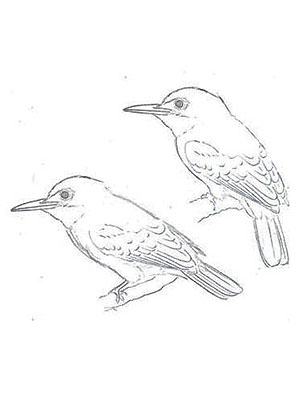
*********************
bearbeitet: 19.11.2017
Isabel Castro; Antonia Phillips: A Guide to the Birds of the Galápagos Islands. Princeton University Press 1996
*********************
Well, this is a quite old or even obsolete book, and unfortunately, I cannot recommend it at all.
The birds of the Galápagos Islands have not deserved such a disappointing and ugly concoction, well, actually no creature has!
The illustrations are at the best „not so good“ (don’t let yourself be fooled by the cover picture), the descriptions are beyond good and evil, the sizes of the Darwin Finches are given in grams!!! In grams, that means the weight! What the heck … how is this supposed to be of any help in identifying birds in the wild, especially such small and consimilar birds like especially the Darwin Finches are?
***
I personally think especially a book about the birds oft the Galápagos Islands should not just only mention the existence of subspecies (the book does in some cases, but not always), it should name them and show them with depictions, just to display the evolutionary processes that are going on, because:
(Galápagos Islands = Evolutionary Laboratory … ever heard of that before?).
Sorry, a given chance wasted!
***
However, maybe someone else is willing to go to the trouble of doing a suitable book about this topic. The birds of the Galápagos Islands deserve it, and they are not so many, so it should be possible!
*********************
edited: 13.11.2017
Hi there!
It’s coffee/tea time, whatever you prefer … and it’s dark outside, and thus it’s dark inside too.
***
I have decided to make another >step by step<, or >how to do<, or whatever you may call it series, of how I draw a bird, this time it is another extinct one, yet only known from two of its bones, so the coloration is just imagined.
***
1: a sketch is made

2: the sketch is fixed with the pencil

3: the sketch is finished, the surroundings are included

4: the rubber color is put on the bird

5: the rubber color has dried, the background is created with water color and a sponge

6: the background has dried, the rubber color is rubbed away

7: the actual coloring begins, I use my loved watercolor pencils

8/9: the watercolor is blurred with a brush and with water


10: the water has dried, the details are now worked out using the watercolor pencils again

11: the most important step, probably; the last details are worked out with a pencil, and the white dot is placed inside the eye

The end result is a drawing of a Cuban Tapaculo (Scytalopus sp.)
*********************
References:
[1] Storrs L. Olson; Evgeny N. Kurochkin: Fossil evidence of a tapaculo in the Quaternary of Cuba (Aves: Passeriformes: Scytalopodidae). Proceedings of the Biological Society of Washington 100(2): 353-357. 1987
*********************
edited: 09.11.2017